Trip Report/2016 Brochure
We will have a brochure available
for this Trip shortly. However, this report
will give you a great idea of the subjects we'll
be shooting and what we do.
Quest for the Puma
Torres Del Paine
Photo Safari-Tour
2014
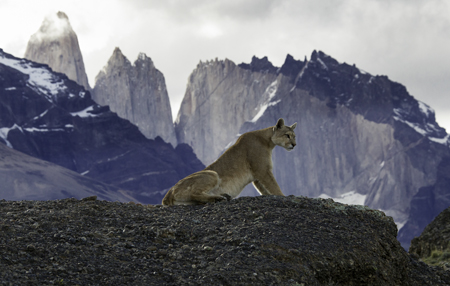
Truly, this tour-photo safari is the culmination of a Quest that started around 12 years ago when I saw, but failed to photograph, my first Puma in Torres del Paine National Park. The guest of two Chilean friends, Alex and Gustavo Furman, I had seen and followed a Puma in the pre-dawn light, and at times I was within 25 yards of the unfazed cat. I'd started in the near-dark and had not expected to get anything more than a view of the Puma, so I didn't bother carrying gear. That experience, however, convinced me that photographing wild Pumas was possible, and over the following years I made several trips.
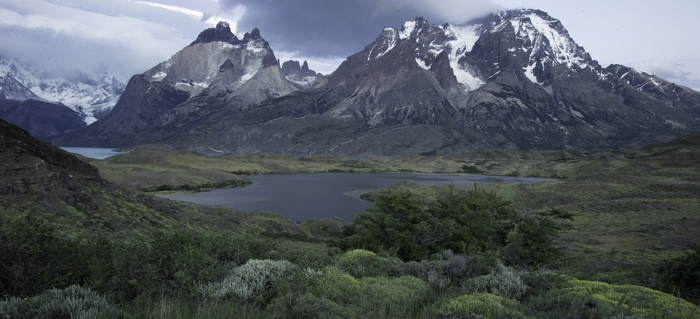
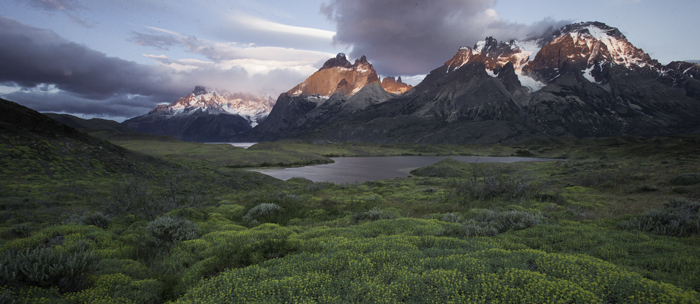 In minutes the landscape changes as the sun rises, and dull gray clouds and steely mountaintops transform to fiery peaks and colorful clouds.
In minutes the landscape changes as the sun rises, and dull gray clouds and steely mountaintops transform to fiery peaks and colorful clouds.
Last year (see Scouting Report), I had the chance to meet Alex and his guide, Diego Arraya, that I've known as a friend since my second trip to Chile. Diego is twenty years younger than me and we call him 'son,' and he calls Mary and me 'Mommy and Daddy,' and we're like family. Diego had a group, but Mary and I were invited to join them at a Puma encounter where I had a chance to see how a group would work in photographing the cats. That experience confirmed my belief, and this year, for the first time, we did a trip with the main objective to photograph Pumas! We were wildly successful.
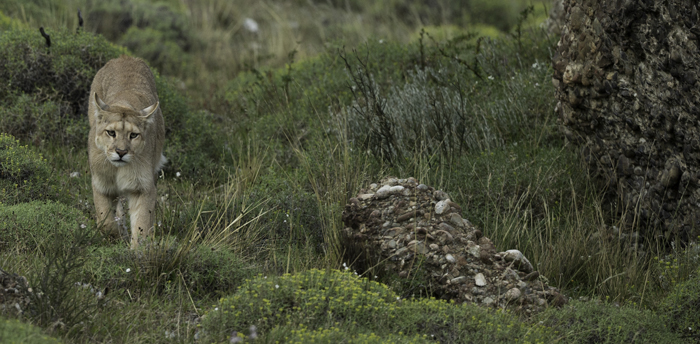 In the trip report that follows I have not divided the two tours into two separate accounts since 5 of our 6 participants did both trips. Bill Sailer, Tom Wester, Don Lewis and Judy Johnson, and Angus Fraser did both trips, and our friends Steve Berkowitz and Rick Cover filled out the tours, respectively, and enjoyed incredible luck. How much luck? Between what our two guides saw (and that we may have
In the trip report that follows I have not divided the two tours into two separate accounts since 5 of our 6 participants did both trips. Bill Sailer, Tom Wester, Don Lewis and Judy Johnson, and Angus Fraser did both trips, and our friends Steve Berkowitz and Rick Cover filled out the tours, respectively, and enjoyed incredible luck. How much luck? Between what our two guides saw (and that we may have 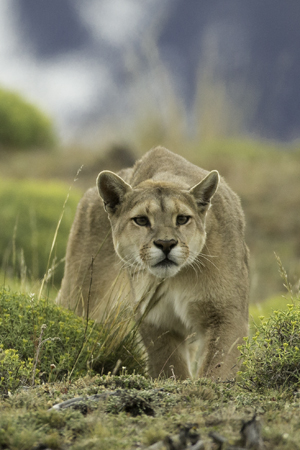 missed) we had at least 16 different Pumas, and we had, in the two weeks of shooting, 32 sightings or photography sessions. Some of the cats we saw more than once, but we counted each as a session if we had taken a mid-day break, since we had to find the cats once again. On the few times we stayed with the cats all day we counted the encounters as only one session.
missed) we had at least 16 different Pumas, and we had, in the two weeks of shooting, 32 sightings or photography sessions. Some of the cats we saw more than once, but we counted each as a session if we had taken a mid-day break, since we had to find the cats once again. On the few times we stayed with the cats all day we counted the encounters as only one session.
Honestly, I don't think I've enjoyed a photo safari or tour more. It is such a thrill to be ON FOOT with a big, wild cat that went about its business unconcerned by our presence. We had two different Pumas stalk right past us, and we photographed an unsuccessful hunt/chase with one Puma, and just missed another by seconds. Our friend, Diego, has a wit and sense of humor that is, perhaps sadly, in synchrony with mine, and we simply had fun. Our two 'Trackers,' naturalist-photographer friends of Diego, Christina and Rodrigo, worked their butts off to find cats for us, and their efforts were extremely successful. With Mary, me, Diego, and our two trackers, we had a Guide Ratio of 5:6, and our combined spotting I think really paid off.

In addition to Pumas we photographed a great Patagonian Gray Fox den, Andean Condors, Guanacos doing everything, landscapes, and numerous birds. Our days were long -- we started between 4:30 and 5:30 most days, breaking at mid-day for a few hours rest and down-loading session, and another field session at 4:30 until ... whenever. Sometimes we didn't return back to our lodge until 9PM.
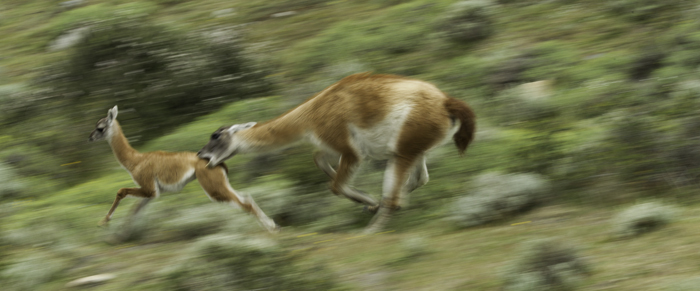
We'd start, usually, by seeking a dawn landscape while our Trackers searched for pumas. Usually we'd get a shoot in before going for Pumas, although on some days we went directly to the cats, and on two days we did not see a cat. On two days, one each tour, we didn't even look -- heading to a different part of the Park for landscapes, a rare and endangered species of Deer called a Huemul, and birds. Our average, for Pumas, was over 2 per day despite this!
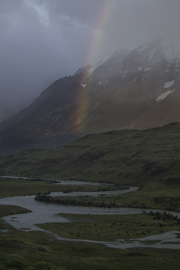 Unlike all of our other big cat photography, we photographed ALL of our Pumas while we were on foot, and not from a vehicle. Many of our cats were, at some point, stationary, but we did a lot of walking and we really worked hard. Pumas probably walk around 6mph, and a good human walking pace is around 3.5mph, so we really were working at times to keep up or to get ahead of a cat to position ourselves for a great shot. Although our walking speeds differed I don't think anyone ever missed a cat. Some were 'there' early, but everyone got there!
Unlike all of our other big cat photography, we photographed ALL of our Pumas while we were on foot, and not from a vehicle. Many of our cats were, at some point, stationary, but we did a lot of walking and we really worked hard. Pumas probably walk around 6mph, and a good human walking pace is around 3.5mph, so we really were working at times to keep up or to get ahead of a cat to position ourselves for a great shot. Although our walking speeds differed I don't think anyone ever missed a cat. Some were 'there' early, but everyone got there!
Still, it was a physical trip. My Cabela's boots failed, with a boot sole beginning to peel off, but luckily Diego had rubber glue that provided first-aid for the boot. I only mention this because in Rwanda the same style of boot did the exact same thing, with the sole peeling off. Both sets were new, so I was very annoyed. Both Mary and I had had back surgery this year, and Mary had her second total knee replacement, but we did well despite this. At the beginning of the second tour I either tore, irritated, or otherwise damaged my shoulder's rotator cuff, and for most of the second tour I couldn't lift my left arm higher than my chest. I often used a Canon 200-400mm zoom, loaned to me by my good friend Sam Maglione since my own lens' tripod collar had jammed in Tanzania and Canon's CPS would not loan me a lens while the other was being repaired. Last year I only took an 800mm lens, and I did take that lens this year, too, and used it mostly for birds. I rarely needed anything more than the big zoom (sometimes with the built-in converter) for the Puma shots.
If you don't bother to read the entire report, please skip to the end of the report for information about our next trips for the wild Pumas! Here's the report:
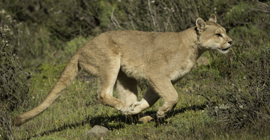
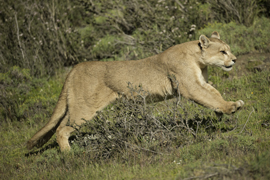
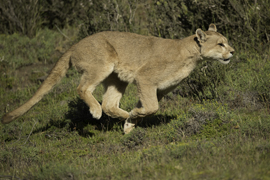
Our first puma, quite literally 5 minutes after we left our lodge to start
our photo
tour/safari on our Quest for the Puma!
Day 1. Our quest for the puma was satisfied in the first ten minutes of our trip. We had over-nighted in Punta Arenas, met a transit driver at 9, and proceeded to Porta Natales where we’d meet Diego, our outfitter who owns Wild Patagonia. I’ve known Diego for over 12 years when he had just begun his life centered around Torres del Paine, and since those days he’s built a nice little tour company.
When we arrived at the estancia where we’d be based for the next 12 days Diego radioed our spotters, Rod and Christina, and we learned they had a Puma! We could see their vehicle from the window of our lodge, and after a little looking we could see the Puma, too!
We had a meeting at 5, prepping the group on protocol, and began packing. While we were loading I saw a Guanaco walking across the hillside, seemingly straight at the Puma! We loaded as quickly as we could and raced the half mile to the cat but by the time we arrived everything was over.
Here’s what happened:
From their position, Rod and Christina could see the cat, which was lying facing away from the road. When the Guanaco approached, the cat reversed itself and flattened, and then disappeared. They were only about ten yards away from the Guanaco when the cat leaped from cover, having covered about thirty yards completely unseen by the two. The cat grabbed the back of the Guanaco and shifted to grab the neck, while the adult Guanaco ran down hill and started crossing the road. At that point, either the cat lost its grip or it lost its nerve and slid off, and the Guanaco ran to safety.
We arrived within a minute or two of this, and saw the Puma as it disappeared in thick brush less than thirty yards from the road. We walked uphill and got ourselves into position, and as R and C moved closer to find the cat it jumped out and ran uphill. They followed, and finally located the cat again.
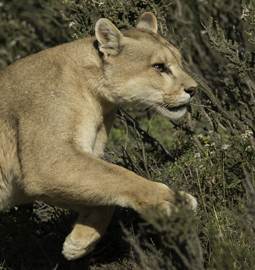 We hiked 100-200 yards up the steep hill and got into position, and a few minutes later the cat left cover and ran further up the hill. I was using an 800mm and I was too close for nearly all the shots, while those using a 200-400 had almost perfect composition as the cat ran by, fully in the open and in great light. It ran about 100 yards and stopped, and then leisurely walked further up hill and disappeared over a ridge.
We hiked 100-200 yards up the steep hill and got into position, and a few minutes later the cat left cover and ran further up the hill. I was using an 800mm and I was too close for nearly all the shots, while those using a 200-400 had almost perfect composition as the cat ran by, fully in the open and in great light. It ran about 100 yards and stopped, and then leisurely walked further up hill and disappeared over a ridge.
It was around 6:30PM and extremely windy, so we headed back to our lodge for a 7:30PM dinner. As we ate the gray clouds hanging over the mastiff moved in, slapping the windows with rain. The wind was fierce, and actually flapped the floor boards of the Restaurant, causing the chairs to rise up and down and move, as if haunted.
It was a great first afternoon and everyone got wonderful shots. If we did not see another Puma I think everyone would be satisfied – but hopefully there will be many more to come.
Day 2. Our first full day in the Park.
We left 4:45AM, hoping to do a sunrise of the mastiff, but it was shrouded in rain clouds. We drove to a spot where there would have been a reflection, had there been a mountain and had there been a quiet morning, but a gale-like wind made the reflection pond a cracked mirror of waves. We abandoned that location and headed west, to another overlook that encompassed the … River. Pink color was beginning to tint the clouds and the mountain mastiff revealed a bit more of itself, while a full arch of a rainbow spread across the southern edge. We photographed the scene until the rainbow disappeared and with it the enticing light.
We drove on looking for pumas. We did find a fresh Guanaco kill, with fresh, wet stomach contents and damp meat, with sticky blood on the fur. Mary dropped me off and I hiked to the top of a rocky ridge to look for the puma, while Rod and 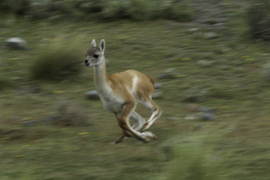 Christina scoped on the opposite side looking for one on the lake-side of the road. I had a fox sneak up from behind, and I spooked it when I stood, but otherwise, no predators.
Christina scoped on the opposite side looking for one on the lake-side of the road. I had a fox sneak up from behind, and I spooked it when I stood, but otherwise, no predators.
Mary and Diego cruised the roads, stopping to photograph Magellanic Oystercatchers and ducks, and eventually stopping at the road below my rock outcrop where a group of Guanacos had gathered. I slowly made my way down, and for the rest of the morning we photographed the Guanacos as they ran about, chasing one another or grazing, sometimes within only a few yards of where we stood. I did a lot of slow-shutter speed shots, at 1/50th sec, to capture motion blur as the Guanacos ran by, which worked well.
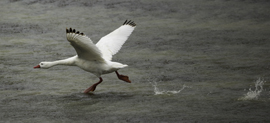 We took a mid-day break after lunch, and at 4:30 in a light rain headed back out. We were hoping to find Guanaco males that might be fighting, but they all were relaxed.
We took a mid-day break after lunch, and at 4:30 in a light rain headed back out. We were hoping to find Guanaco males that might be fighting, but they all were relaxed.
We continued to where Coscoroba Swans were swimming at a road-side lake. They then flew parallel to us, while Diego’s group did a nestling Crested Caracara. We got a radio call from Rod and Christina that they had spotted two pumas, and we raced to the area. One ended up being a shy collared female that eventually bolted from cover and ran right by Bill and Tom. Several others saw one of her cubs, but no shots. Mary spotted the female as it ran across the road and went following it but never got a chance to take a shot. By then it was past 8PM and time for dinner, with the light failing as we drove back to our lodge.
Day 3. Our Second Full day in the Park.
We awoke to clear skies and a light wind and headed to the ‘reflection’ lake where we photographed the sunrise. There was enough of a breeze to create chop, so we had no reflections, but wonderful light on the Towers. We thought we had finished and most of us had put away our gear when a second burst of wonderful color had us unpacking again and shooting more landscapes.
Rod and Christina were out scouting and found another pair of Pumas, close to where we had a cat yesterday. The two were visible but partially hidden in the vegetation, and when we positioned ourselves both got up, one at a time, and crossed into an opening before walking off, rounding a distant slope. Our two trackers, R and C, followed and Rod found the female by the lake, sitting on a rock by the shore. Unfortunately we had the directions wrong and when we crept to the edge we were facing the wrong way, straight ahead but with the cat to our extreme left and we missed it until it started walking away. The cat took shelter in the rocks, and because Steve only has the first week with us, we had him move in first. The cat got up and Steve got a great frame-filling shot of the Puma standing amongst the rocks. The puma continued up along the lake shore, away from where Angus, Tom, and I positioned ourselves, but Mary and Bill were overlooking the area and got great shots as the female went by. Rod followed and discovered the cat hooking up with another male.
Meanwhile, within sight of us, Christina was sitting, watching the first male. We positioned ourselves and after about an hour the male got up and walked away. Unfortunately, we had a line of our shooters paralleling the ridge and the message: ‘the cat is under THAT bush’ wasn’t properly conveyed down the line, and the folks in the back were looking further uphill and didn’t see the cat until it walked off.
We started hiking back to the vehicles but a large herd of Guanacos were feeding, running about, fighting viciously, and shepherding their newborn babies in the meadow before us. One male was nearly missing its entire lower jaw, and Diego got a shot where two males reared, spewing blood as they fought each other. We stayed there until nearly lunch, then did a quick circuit by the Swan Lake for more scenics, although I was so tired I was oddly unmotivated to shoot the mountain.
We had a break from 2 until 4:30, then headed out to look for cats. We stopped, first, to look for Austral Pigmy Owls, but were unsuccessful. In the same area, 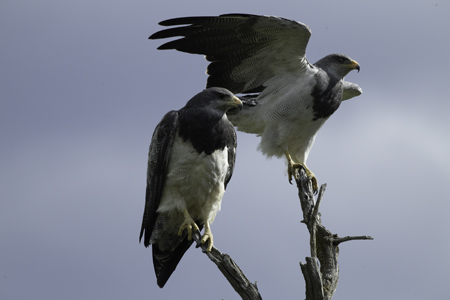 though, a Black-chested Buzzard Eagle was nesting, and we had wonderful opportunities for the birds perched on a snag and in flight, circling us. Terrific images. R and C had no luck initially in finding a cat, although they did spot a kill we missed earlier, probably done yesterday. As we drove we found a very cooperative Hognose Skunk and spent about 1.5 hours with it, a surprisingly challenging subject that seemingly never stopped moving.
though, a Black-chested Buzzard Eagle was nesting, and we had wonderful opportunities for the birds perched on a snag and in flight, circling us. Terrific images. R and C had no luck initially in finding a cat, although they did spot a kill we missed earlier, probably done yesterday. As we drove we found a very cooperative Hognose Skunk and spent about 1.5 hours with it, a surprisingly challenging subject that seemingly never stopped moving.
It was getting late and we started back to our lodge when Christina spotted another Puma (our 6th for the day) about ½ mile away. No shots, but it was wonderful to watch a relaxed cat move across the mountain slope in the intense, golden light of the end of the day.
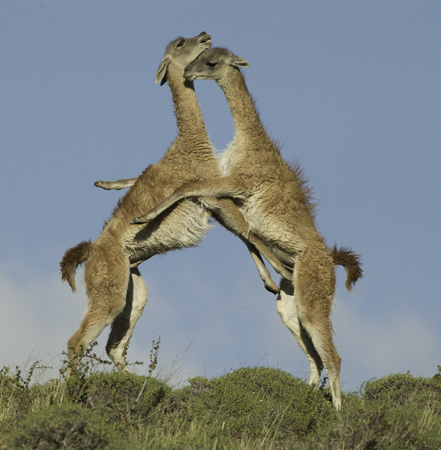
Day 3.
We left at our usual time, this time driving to a new overlook to get a view of the entire mountain mastiff, since the area was partly covered in clouds. To the east we had spectacular color, and I, too late, positioned Diego for a silhouette. Previously, as I posed with my tripod at a prominent spot, one of our shooters yelled, ‘you're in the shot!’, not recognizing that I WAS the shot! Afterwards, we drove back into the park to look for a Patagonian Gray Fox den, unsuccessfully, while our scouts found another den which we photographed from the road.
There, we had much frustration as several of us with new 7D Mark IIs, had focus sharpness issues. When we returned at lunch I did, for the first time, a Micro Adjustment on the camera, ending up at -.5 to hopefully compensate for the focus error.
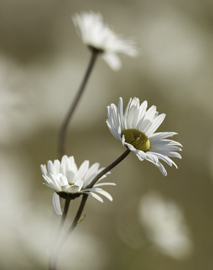 As of this writing, I had not yet checked the sharpness on the den shots, which had an adult and pups playing, wonderful shots, even if at a distance.
As of this writing, I had not yet checked the sharpness on the den shots, which had an adult and pups playing, wonderful shots, even if at a distance.
We headed towards the lodge but stopped at the Paine River Cascades where we spent about an hour photographing a family of Austral Negritos, a small songbird whose male we see everywhere but rarely get close to. Adult males are black with a rufous back, but the females and juveniles are brown, and the female here was feeding her fledged chicks mayfly adults she plucked from the river.
We took a two hour break, then returned to the same area at 5PM where we photographed Daisy Flowers at slow shutter speeds and with long telephotos, and distant shots of a colorful male Torrent Duck.
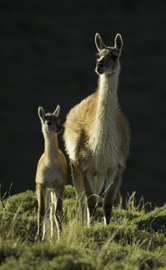
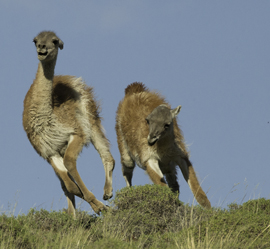
Afterwards we headed into the high country, and along the way Mary spotted, while driving, two Andean Condors perched on a ridge. They flew off when we neared, but we drove on ahead a few hundred yards and managed spectacular shots of an immature and adult female as they circled to gain height - the best shots I’ve ever made of Condors.
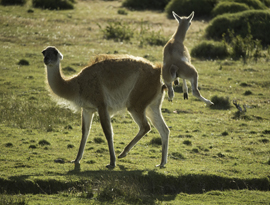
Continuing, we reached a large herd of Guanacos, with older juveniles fighting, rearing up on their hind legs against a blue sky background, and newborns running about, jumping, playing, and nursing. The light was the best we’ve had for an afternoon and we stayed until nearly 8:30PM, returning to the lodge only when wispy clouds began to mask the sun.
After dinner, at sunset – 10PM or so, we had great color on the clouds above the mastiff, which concluded a day without pumas, but a very successful day nonetheless.
Day 4.
We left early, at 4:30AM, to reach Nordensjold Lake overlook in time for sunrise. Although it did not look promising the light cooperated wonderfully and we had a great shoot. Meanwhile, R and C were scouting for puma and we received a radio-talk that they had a Puma that had just left a kill. We raced to the spot in time to see the male Puma from our first day appear, approaching the road. Angus, Steve, and I had to get out of the vehicle to get our gear and the cat hunkered down, then turned and crossed the road closer to Diego’s vehicle, where Judy, Don, Tom, and Bill shot from the windows. Mary thought that we probably spooked the cat – but we had little choice.
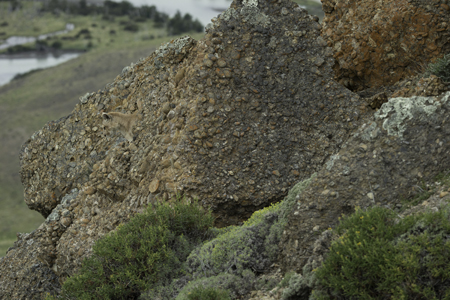
There is a Puma in this image. Look for the Puma head, left/center against
the large conglomerate rock on the upper left-center of the image.
We headed back deeper into the park and we missed the tailless Puma that apparently crossed the road and was, of course, spotted by R and C. We raced back in time to see the cat walking in full view along a cliff face of conglomerate rock.
Everyone piled out of the vehicles and joined R and C who were following along, paralleling the cat. We trailed behind, and I was last, since I took the time to attach my 200-400 (curtesy of my friend, Sam, who loaned me his since mine broke in Tanzania). I got a few brief shots before the cat disappeared over a rise in the rocks.
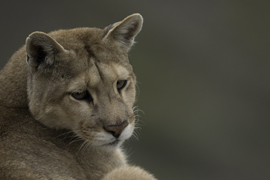 The cat followed the edge of the ridge line, and we walked beneath. Several times the cat paused for a few seconds for shots. At one point the cat disappeared and I climbed down a loose-rock talus slope with my heavy 800mm over my shoulder and hand-carrying the 200-400 with a Gura Gear pack on my back. It was iffy footing and the cat, I was told, had gone back up to a higher spot. I retraced my steps, this time taking the time to stick the 200-400 in my pack, and just after I cleared the chute and I rounded a bend – there she was. The Puma stepped out onto a ridge overlooking the Paine River valley and simply posed, an absolutely stunning view.
The cat followed the edge of the ridge line, and we walked beneath. Several times the cat paused for a few seconds for shots. At one point the cat disappeared and I climbed down a loose-rock talus slope with my heavy 800mm over my shoulder and hand-carrying the 200-400 with a Gura Gear pack on my back. It was iffy footing and the cat, I was told, had gone back up to a higher spot. I retraced my steps, this time taking the time to stick the 200-400 in my pack, and just after I cleared the chute and I rounded a bend – there she was. The Puma stepped out onto a ridge overlooking the Paine River valley and simply posed, an absolutely stunning view.
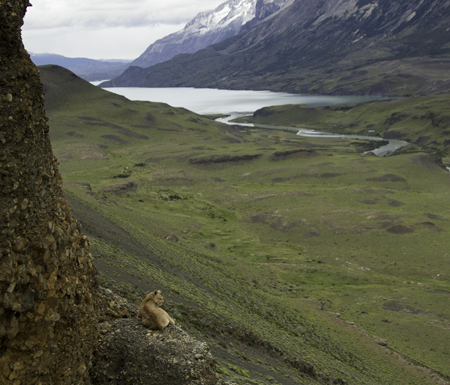 She stayed there for about an hour, switching eventually to give us a back view, and then finally dropping off the ledge and out of sight. Steve, Tom, and I backtracked, and had a brief glimpse of the cat, but it reversed itself again, and started walking at the base of the cliff edge. Rod and Angus were there, and followed the cat and Angus got some great shots of the Puma on a ledge or sitting, and peering, around the rocks. Beautiful shot.
She stayed there for about an hour, switching eventually to give us a back view, and then finally dropping off the ledge and out of sight. Steve, Tom, and I backtracked, and had a brief glimpse of the cat, but it reversed itself again, and started walking at the base of the cliff edge. Rod and Angus were there, and followed the cat and Angus got some great shots of the Puma on a ledge or sitting, and peering, around the rocks. Beautiful shot.
A male Andean Condor was perched further down the cliff and all of us shot it from a distance. Diego and I stalked closer, and putting a 2X on the 800 with the 7D Mark II I had frame-filling shots. Unfortunately, minus the 2X, the Condor eventually launched, and almost all of my shots with the 800 were soft. Very disappointing. Despite that disappointment, the Condor shooting was the 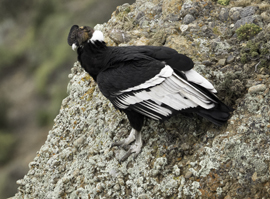 absolute best I ever had, even with the straight 800mm. As I write this, I haven’t checked for critical sharpness, but I trust that for the straight, perched shots, the 7D performed well.
absolute best I ever had, even with the straight 800mm. As I write this, I haven’t checked for critical sharpness, but I trust that for the straight, perched shots, the 7D performed well.
Angus was with Rod, who stayed behind to keep track of the Puma, while Angus climbed the talus and joined me on top where Christina informed us that the group was waiting for us at the vehicles.
We had a late breakfast, then headed down to where, yesterday, we found Porcelain Lilies. There was no wind, perfect for macro/flower work and we had about a half-hour of successful shooting before the wind kicked up, and we headed home for an on-time lunch.
At 4:30PM, exactly 12 hours later, we headed back out, first looking for Rheas which Angus and Steve shot from our car, and then heading back into the park where the male Puma had been spotted by R and C. My vehicle stopped for Condors and got to the site late, but those that were early were surprised when the tailless Puma emerged from the narrow cave where the male Puma was resting. Great shots, there. The tailless cat climbed on to the top of the rocks above the cave where she rested, and where Judy, Steve, Angus, and I climbed up to shoot her, while the others stayed back to wait for the male. Eventually she got up and 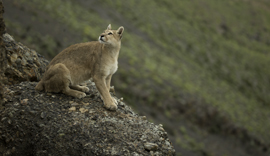 walked toward the cliffs, which she followed, before dropping onto a ridge line where she laid down, with the Torres del Paine towers in the background. Rod, in all the years, had never had an occasion where a Puma framed itself against the towers – magnificent! I had held back, since a Guanaco was moving down the ridge towards the male, but when I heard about the framing I got over as quickly as I could while still maintaining stealth as I negotiated the potentially noisy, loose conglomerate rock. I arrived in time for a couple of sequences before the cat moved again, finally coming to rest in the low vegetation.
walked toward the cliffs, which she followed, before dropping onto a ridge line where she laid down, with the Torres del Paine towers in the background. Rod, in all the years, had never had an occasion where a Puma framed itself against the towers – magnificent! I had held back, since a Guanaco was moving down the ridge towards the male, but when I heard about the framing I got over as quickly as I could while still maintaining stealth as I negotiated the potentially noisy, loose conglomerate rock. I arrived in time for a couple of sequences before the cat moved again, finally coming to rest in the low vegetation.
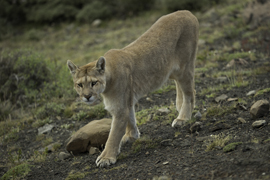 Steve, Judy, and I, and R and C, had the cat close and I radioed the others to say, ‘Get here!’ They arrived while the cat was in deep sleep and it was getting past dinner time, and it was time to leave. I said, "Let’s give it ten minutes.', and Diego radioed the lodge to tell them we would be late. A few minutes later the cat woke up, stared directly at us after doing a few roll-overs and tongue-licking grooming sessions and then walked right to us, passing within 10 feet of us and completely unconcerned. She almost immediately went into a stalk, spotting a European Hare some distance away, but Guanacos spotted her and whinnied their alarm and she stopped, sitting, then lying down, where we left her to go home.
Steve, Judy, and I, and R and C, had the cat close and I radioed the others to say, ‘Get here!’ They arrived while the cat was in deep sleep and it was getting past dinner time, and it was time to leave. I said, "Let’s give it ten minutes.', and Diego radioed the lodge to tell them we would be late. A few minutes later the cat woke up, stared directly at us after doing a few roll-overs and tongue-licking grooming sessions and then walked right to us, passing within 10 feet of us and completely unconcerned. She almost immediately went into a stalk, spotting a European Hare some distance away, but Guanacos spotted her and whinnied their alarm and she stopped, sitting, then lying down, where we left her to go home.
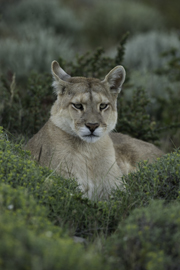
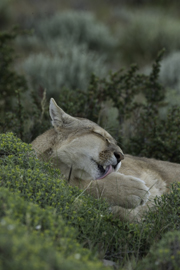
Day 5.
We planned on driving to Lago Gray, where the Gray Glacier terminates and where an Austral beech forest attracts an entirely new set of subjects. We slept in, until 5 or so, to get a bit of rest, then headed out in an extremely fierce wind. As we approached Nordskjord Overlook the far end of Lake Sarmiento was a white froth from the wind, with white caps etching the lake. Angus went down towards the shoreline for a shot, while I used the shelter of the vehicle to do some telephoto extractions.
We stopped at the Lake Pahoe campground where we hoped to find a Red Fox or Red Wolf, an entirely different species from either the North American fox or wolf. We had no luck, but did quite well with Flickers and Leaf-cutters, and scenics of the mastiff from the lake side.
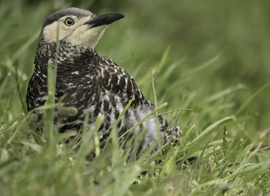
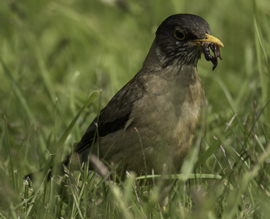
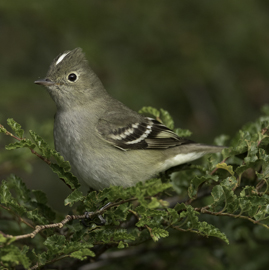
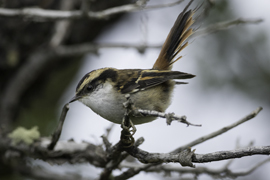
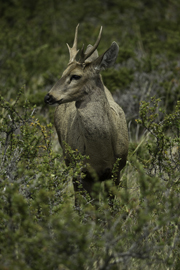 We continued on, where R and C had located a Huemul Deer, a big whitetail-deer like animal that also resembles an elk. They had spotted a buck and a collared doe and after a long walk through spikey brush along a narrow trail, and a steep climb to a plateau, we were with the deer. The wind was fierce, but the deer cooperated with the buck walking down the hill towards us and eventually grazing so close that we had to back off. With great shots ‘in the can’ we left the deer, hoping for more subjects.
We continued on, where R and C had located a Huemul Deer, a big whitetail-deer like animal that also resembles an elk. They had spotted a buck and a collared doe and after a long walk through spikey brush along a narrow trail, and a steep climb to a plateau, we were with the deer. The wind was fierce, but the deer cooperated with the buck walking down the hill towards us and eventually grazing so close that we had to back off. With great shots ‘in the can’ we left the deer, hoping for more subjects.
After lunch I heard and saw Austral Thrushes dive-bombing into a big beech tree and Angus spotted the target, an Austral Pigmy-Owl. I went to get the group to show them the bird but it flew off while I was gone. I found it again, and we raced for our camera gear, but when we returned the bird was gone, permanently. R and C were going to look for Magellanic Woodpeckers but within minutes found a pair of Torrent Ducks downstream. We hiked to the shoreline and pushed our way through the vegetation to get to the river’s edge and set up, and the birds cooperated by rather quickly swimming upriver, stopping periodically to rest on a rock. Eventually the birds came so close that I had too much lens with an 800mm 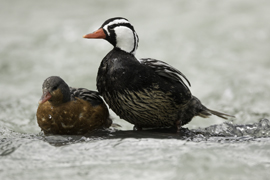 and 7D, although the rest, with a bit smaller glass, were perfect. The birds continued upriver, then swam down, and perched together on a rock towards the far shoreline. All of us tried slow shutter speeds to convey the fast water, although I’m not sure that we succeeded, with the birds moving often and the wind buffeting our cameras.
and 7D, although the rest, with a bit smaller glass, were perfect. The birds continued upriver, then swam down, and perched together on a rock towards the far shoreline. All of us tried slow shutter speeds to convey the fast water, although I’m not sure that we succeeded, with the birds moving often and the wind buffeting our cameras.
We headed towards home at 5, stopping at the campground for more birds – Tyranets, Leaf-cutters, Juncos, and Racquet-tails, and en route, for a beautiful pair of Speckled Teal. We watched for pumas as we drove through the area but only found another Hognose Skunk, and arrived back at our lodge at 7:30.
Day 6.
We left at 5, intending to do sunrise at the ‘stone hut,’ an old stone structure that was erected as a condor blind. Sunrise was a non-event. Although we had color on the eastern clouds the mastiff was dull and simply brightened. The wind was hammering and ferocious; too difficult to stand and too taxing to enjoy shooting. We were within 100 yards of where we photographed the pumas yesterday, but this dawn, shooting would have been impossible.
We returned to the vehicle and Diego suggested staying in the area, driving up the road a bit to keep in contact with R and C in case they spotted a puma. We were still talking about this when we got a radio call that they had the tailless Puma again. We headed out from there, marching directly toward the cat. The Puma was on the move, walking at about 4mph to the south. We were able to anticipate the cat’s direction and several times position ourselves so that the cat approached us,
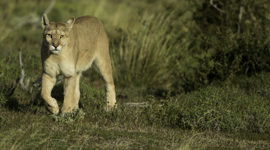
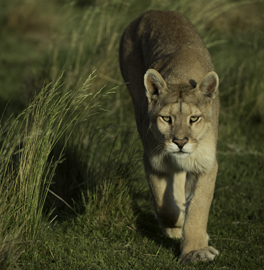
walking straight at us and passing closeby. At one point I had to back up, and in doing so stepped onto the muddy shoreline of the lake, promptly sinking to mid-calf in black mud. Luckily my pants leg covered my boot and my foot didn’t get wet, although it looked disgusting until it dried
.
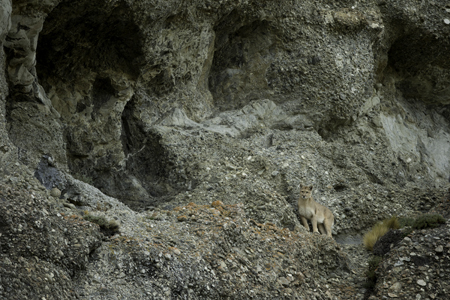
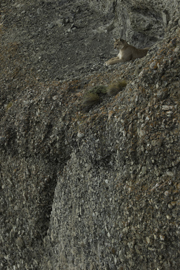 The Puma continued to one of the ‘Castle Cliffs,’ walking along unconcernedly until she almost walked out of sight. Something there spooked her and she raced along the base of the cliff, then climbed up to a ledge and cave that Diego said she frequented. There the Puma found another Puma already in the cave, but this Puma was shy and timid with the Tailless Puma, called ‘Mochita.’ The new Puma ran to the edge of the ledge, which dead-ended, and then she turned around. I expected the two to meet and greet, but instead the shy Puma raced down a shoot and bounded away, following the base of the cliff. Tom and Bill were low, and Tom got a wonderful series of shots as the Puma sprinted by, shooting at 1/125th so he had a GREAT pan.
The Puma continued to one of the ‘Castle Cliffs,’ walking along unconcernedly until she almost walked out of sight. Something there spooked her and she raced along the base of the cliff, then climbed up to a ledge and cave that Diego said she frequented. There the Puma found another Puma already in the cave, but this Puma was shy and timid with the Tailless Puma, called ‘Mochita.’ The new Puma ran to the edge of the ledge, which dead-ended, and then she turned around. I expected the two to meet and greet, but instead the shy Puma raced down a shoot and bounded away, following the base of the cliff. Tom and Bill were low, and Tom got a wonderful series of shots as the Puma sprinted by, shooting at 1/125th so he had a GREAT pan.
Meanwhile, Mochita simply sat or lay down or explored the ledge. Most of us climbed up to a knoll that was at the same elevation as the ledge, and from there we photographed the cat. After an hour or so the cat left the ledge, coming toward us and jumping down from the ledge to walk by us, and then the Puma continued back in the direction where we had started. Steve, Angus,
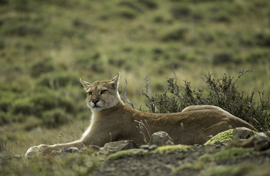 and I tried to keep ahead of her to keep her in sight, and worked our butts off crossing the terrain. Once, I spooked out a European Hare that ran straight at the puma, but she was looking away and never saw the hare. Had she, I’d suspect that she’d have gone for it. But she didn’t see it!
and I tried to keep ahead of her to keep her in sight, and worked our butts off crossing the terrain. Once, I spooked out a European Hare that ran straight at the puma, but she was looking away and never saw the hare. Had she, I’d suspect that she’d have gone for it. But she didn’t see it!
Eventually Mochita walked to the edge of the road where she nestled into a bush and disappeared, only a few yards from the road. We left her there, and
at 5PM we set up over-looking where she was resting. A Guanaco with a leg injury was nearby and at one point walked very close to where the Puma was hiding. It never made a move, although we were in a perfect position! At 7:30 the cat woke up and began to roam about. After enjoying her moving about we headed for home with a wind that kicked up and would have made shooting impossible.
Day 7.
The last day of the first tour and Steve would be leaving us to return to the US. Everyone else is stayed on for the second tour. All of us went out at 5:30AM for a final search (for Steve) for Pumas, and we headed into the park and the area where, yesterday, we had Mochita. We had nothing.
R and C went hiking while the rest of us had breakfast, and we decided to stay in the area to listen for Guanaco alarm calls and to see if R or C saw anything. I
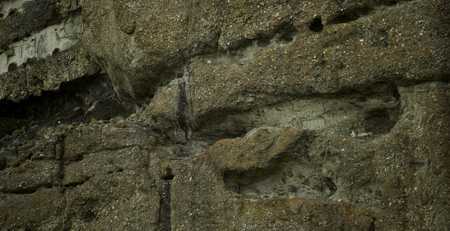
There is a puma in the right/center of this image, just to the left of the small cave.
headed out towards the Puma Castle, taking my 18X IS binocs to scan the rocks, and while I watched a long-tailed female Puma walked into view and settled in at a small cave above a ledge called ‘PacMan’, about 25 feet from the cave where we had the cats yesterday.
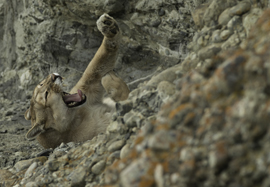 I radioed the group and Diego and Angus carried in my lens and tripod, respectively, and we approached to the nearest ridge. We were still too far away so I hiked up to yesterday’s overlook and found we still had an angle on the new cat and I radioed everyone in. Most everyone got shots but I’m not sure if it was the sister of Mochita or the skittish cat from yesterday.
I radioed the group and Diego and Angus carried in my lens and tripod, respectively, and we approached to the nearest ridge. We were still too far away so I hiked up to yesterday’s overlook and found we still had an angle on the new cat and I radioed everyone in. Most everyone got shots but I’m not sure if it was the sister of Mochita or the skittish cat from yesterday.
The cat was very relaxed when I was there but as more of our group arrived, unfortunately talking and moving about far too much for an unknown cat, the cat got up and walked down the 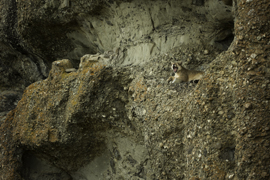 ledge and disappeared. Mary arrived late and only got a back end view, but had everyone been cautious, quiet, and stayed low – as I had done when I scouted the position – I think we’d have had success. At lunch I addressed this, explaining how we’ve had so many pumas (16-17 now) that we’re taking them for granted and treating these wild sightings like zoo animals, and if we’re greedy and more concerned with getting an immediate shot, rather than being patient, we will have less success. Everyone agreed.
ledge and disappeared. Mary arrived late and only got a back end view, but had everyone been cautious, quiet, and stayed low – as I had done when I scouted the position – I think we’d have had success. At lunch I addressed this, explaining how we’ve had so many pumas (16-17 now) that we’re taking them for granted and treating these wild sightings like zoo animals, and if we’re greedy and more concerned with getting an immediate shot, rather than being patient, we will have less success. Everyone agreed.
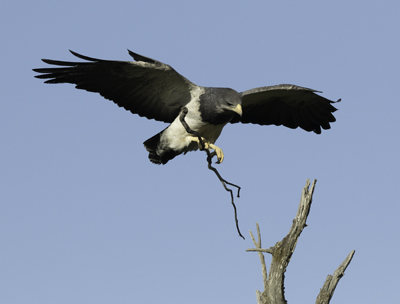
We returned about 11 so that Steve could pack and at noon he and Diego headed to Puerto Natales where Steve would meet the driver to return him to Punta Arenas for his journey home. The rest of us had a longer rest, and at 5 headed back out, hoping to find the puma again. We were unsuccessful.
Instead, we went to the Black-chested Buzzard Eagle nest where we had great opportunities as a bird returned repeatedly to a perch tree, sometimes carrying sticks. I tried using the 7D Mark II, but somehow the AF setting was on AI Focus, instead of AI Servo, and the camera DOES NOT follow focus. It fires, regardless of being in focus or not, and I shot some spectacular sequences, all blurred. I was not happy. The rest of the group, familiar with their gear, got great shots.
We left at 8 and went to the Torres Lodge for dinner, a break from our lodge and a pleasant evening. Clear skies, with beautiful pink-orange wispy clouds to the east, framed the mountains as we called it a day.
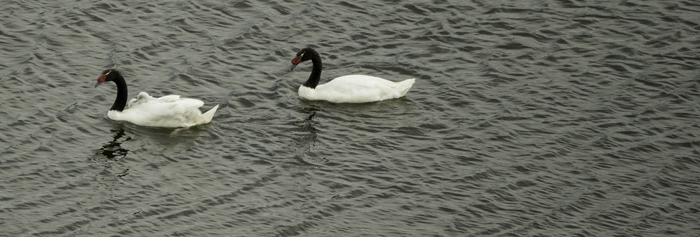 Day 8. The ‘Break Day’ between the two tours
Day 8. The ‘Break Day’ between the two tours
We left at 6AM to concentrate on pumas, although the eastern sky was clear and the light on the mastiff was orange and beautiful at sunrise. We headed directly to the puma castle area, and hiked out to a viewpoint to scan the cliffs. Mary thought she saw a cat in the cave, but to confirm we called Rod over who was most familiar with the landscape. The brown was just grass, but while he used my 18X binocs a tailed Puma climbed down the cliff and went into the cave! It didn’t stay long, reversing itself and jogging out, to settle on a ledge nearby. When the cat finally laid down it was impossible to discern as a cat – the white belly matched the cliff color perfectly.
We ate a quick breakfast and headed out to the cliff, but stupidly we didn’t keep an eye on the cat and it had moved off by the time we reached the cliff. We circled the area without luck, and moved on to the flamingo lagoon where Chilean Flamingos were feeding.

A large flock of ducks were in the lagoon as well, but when they flew, so did the flamingos, all of which flew to a nearby lagoon and not across the mountain face as we expected.
Afterwards we headed to the fox den but the pups were rather sleepy and the shooting 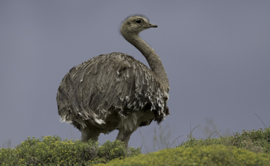 was marginal. En route, we photographed a Greater Rhea and little striped chicks, and later a Guanaco that was wading across the Coscoroba Swan lake. After leaving the den we returned to the lake where we had incredible sequences of fighting Guanacos chasing each other across the shallows, splashing water and biting at each other’s legs.
was marginal. En route, we photographed a Greater Rhea and little striped chicks, and later a Guanaco that was wading across the Coscoroba Swan lake. After leaving the den we returned to the lake where we had incredible sequences of fighting Guanacos chasing each other across the shallows, splashing water and biting at each other’s legs.
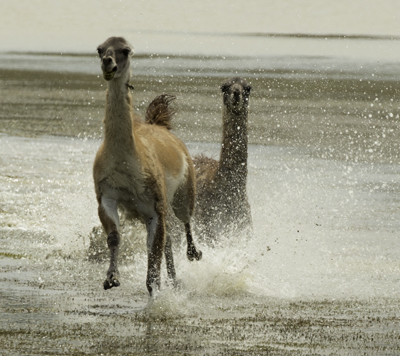
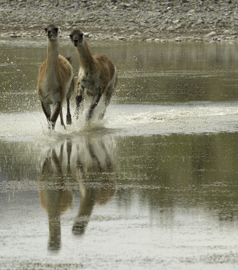
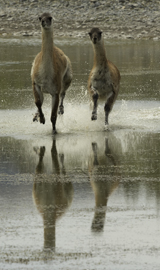
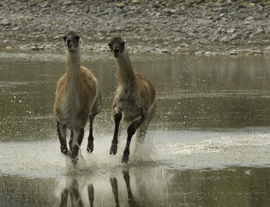
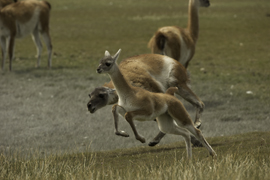
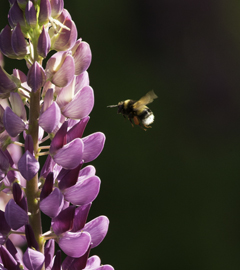 PM. Rick reached the lodge with our guide Diego, and soon after we headed to Laguana Azul for grebes, but they were not nesting. A White-Winged Coot was and we had wonderful shots of the male returning with grasses to add to the nest, which the female occupied. Chiloe Wigeons, Crested Ducks, and Silvery Grebes were on the pond as well. When we first arrived, we spent a good deal of time with Lupine Flowers and the Towers, for nice macro shots and landscapes.
PM. Rick reached the lodge with our guide Diego, and soon after we headed to Laguana Azul for grebes, but they were not nesting. A White-Winged Coot was and we had wonderful shots of the male returning with grasses to add to the nest, which the female occupied. Chiloe Wigeons, Crested Ducks, and Silvery Grebes were on the pond as well. When we first arrived, we spent a good deal of time with Lupine Flowers and the Towers, for nice macro shots and landscapes.
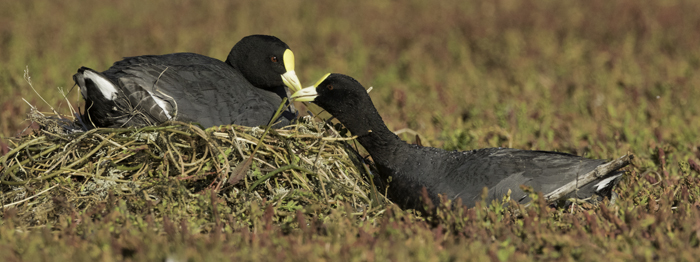
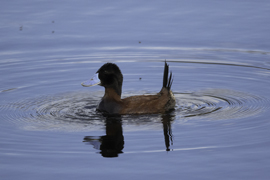 Day 9. The first official full day of the second tour
Day 9. The first official full day of the second tour
Our first day and we saw 5 different Pumas, while our scouts saw 3 more that we could have seen, for a total of 8 for the day! We started at Laguna Madre but low clouds to the east made for a rather dull sunrise and we headed towards Sarmiento where R and C spotted a mother Puma and large cub. They were a ‘tame’ pair, but they disappeared into the black brush and after waiting a while we drove on.
Not long after, we drove into the park to photograph Andean Ruddy Ducks, and Diego’s ex-girl friend, who was leading a group at the time, had a mother Puma with two cubs. We got to the location – just yards from the pond – and had more distant shots of the cubs and adult sticking their heads up above the reeds.
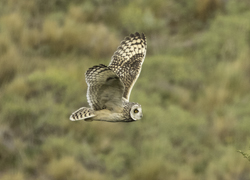
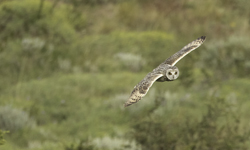
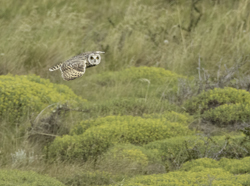
Additionally, a Short-eared Owl flew by several times, the first time we’ve had this owl in the park. The Ruddy Ducks were excellent too, with both males and females swimming close. Eventually the cats disappeared and we figured they were settled for the day and we moved on.
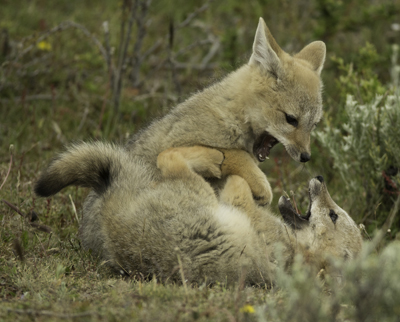 We headed to the Gray Foxes and had our best session yet with the cubs out of the den, wrestling and chasing one another and, hopefully, this time the 7D Mark II performed well, set at a micro adjustment of -5.
We headed to the Gray Foxes and had our best session yet with the cubs out of the den, wrestling and chasing one another and, hopefully, this time the 7D Mark II performed well, set at a micro adjustment of -5.
PM. We left at 4:30 to meet R and C who were already with our Pumas and we sat on a hillside overlooking where they were in hiding until around 6:30, when the mother awoke and casually walked by to join her cubs. They went to the water to drink, then reversed, and walked in a clearing in front of us before disappearing in the woods, to emerge on our right where the female walked across and the more timid cubs jogged, or ran, to another stretch of forest. They stayed in cover then.
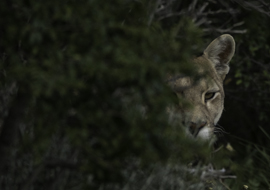
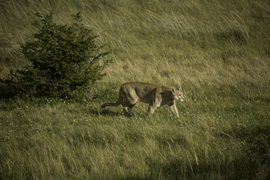

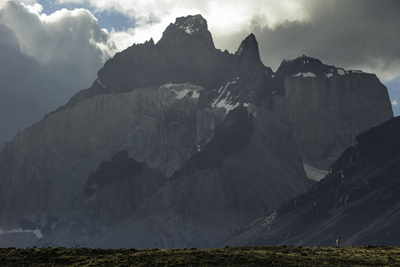 We started toward home, but another guide told us of a male Puma he spotted, and we drove there. We found a nursing female Puma, who walked off. We tried catching up, and I actually walked within ten feet of her without seeing her hunkered in the brush. Tom was following, and saw the cat dash out and run by – I never saw her until she started climbing up a hillside on the opposite side of the road!
We started toward home, but another guide told us of a male Puma he spotted, and we drove there. We found a nursing female Puma, who walked off. We tried catching up, and I actually walked within ten feet of her without seeing her hunkered in the brush. Tom was following, and saw the cat dash out and run by – I never saw her until she started climbing up a hillside on the opposite side of the road!
That was not the cat we were looking for! That was a male, which we found, but he was shy and ran off, ending in a small thicket where we left him at peace. We drove home and missed a radio call from R and C who had found the 8th cat for the day, another female that was resting at the base of a ledge.
The evening was capped by a Chilean alcedo barbeque of lamb, and we drank and ate to excess.
Day 10. The best day ever, in all the trips I’ve done to Torres del Paine!
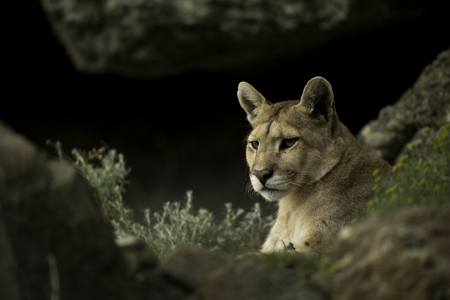 We started at 6, heading to the ‘stone house’ area to look for Mochita or her tailed sister. Our three vehicles spread out across likely looking area and just as my vehicle was about to move on Angus spotted Mochita walking up a slope beside the road. She is a very relaxed Puma and we knew that wherever she went we’d have a good chance of catching up with her.
We started at 6, heading to the ‘stone house’ area to look for Mochita or her tailed sister. Our three vehicles spread out across likely looking area and just as my vehicle was about to move on Angus spotted Mochita walking up a slope beside the road. She is a very relaxed Puma and we knew that wherever she went we’d have a good chance of catching up with her.
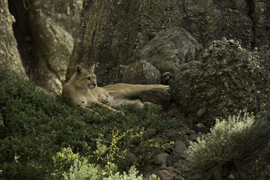
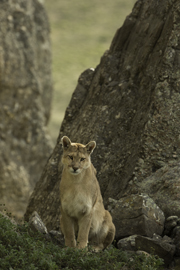
She didn’t go far, climbing up to a nearby ledge where she sat, then moved on to another cave where we were going to leave her undisturbed. Everyone had put away their gear and we were about to head out when she got up and walked directly to me, passing by, with my gear still in my bag! She walked to a new resting place where we positioned ourselves again, and where she posed nicely, and where we left her when she settled down to sleep.

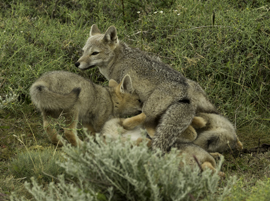

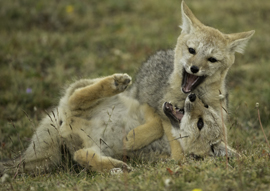
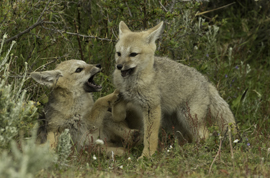
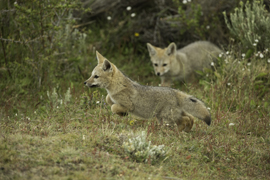
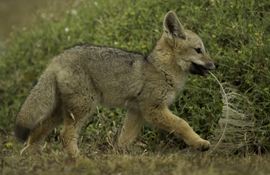
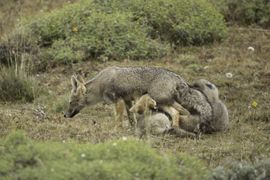
We headed out to the fox den and when we arrived all the foxes were sleeping. A cold front had moved in and we sat inside the vehicles watching the foxes in the distance, doing nothing. We were tempted to move on but the pups finally awoke and we moved in, with the pups and the mother completely oblivious to us. At one point several of the pups trotted to within ten feet of us, where they stood and watched us before moving back to the den. During the two hours or so they played, wrestled, chased one another, tossed dung balls and feathers, and did all of this close to us. Between the Puma and the Patagonian Gray Foxes I shot almost 2,000 frames. Mary’s back was killing her, and last night she gave herself a black eye when the microphone to our Walkie-Talkie sprang back and whacked her hard.
On the way back to the lodge we had a Hairy, or Yellow, Armadillo run across the road. This is so rare that R and C have only seen one! The Armadillo took shelter under the branch of a small shrub, and we were very close, but the shooting, unfortunately, was marginal.
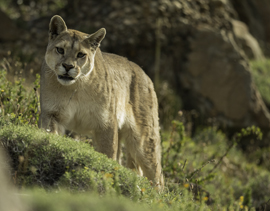 PM. We headed back to look for Mochita, and several vehicles were where we had left her, as she, and TWO other pumas, had been visible. We didn’t want to create a Yellowstone-like scene so we held back until the tourists left, when we headed into the rocks. R and C had located a ‘tailed’ Puma we assumed was the sister to Mochita, but we weren’t sure. When we found her, inside a cave, R and C thought the male was inside, too, but they didn’t really know. So, we waited, and sat for about an hour watching the cliff cave. During that time, a katabatic wind kicked up, with winds reaching about 60-70mph for about 5 minutes, beating against us. Then it stopped, and the air was calm again.
PM. We headed back to look for Mochita, and several vehicles were where we had left her, as she, and TWO other pumas, had been visible. We didn’t want to create a Yellowstone-like scene so we held back until the tourists left, when we headed into the rocks. R and C had located a ‘tailed’ Puma we assumed was the sister to Mochita, but we weren’t sure. When we found her, inside a cave, R and C thought the male was inside, too, but they didn’t really know. So, we waited, and sat for about an hour watching the cliff cave. During that time, a katabatic wind kicked up, with winds reaching about 60-70mph for about 5 minutes, beating against us. Then it stopped, and the air was calm again.
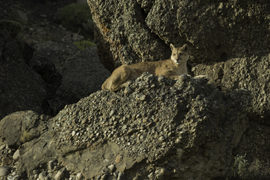
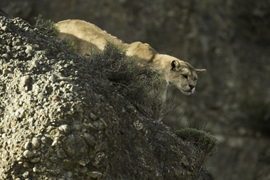
Soon after a Puma appeared, and as it turned out it was Mochita’s sister. She walked along the ridge, and at one point came right past me, continuing until she met up with Mochita. We were hoping for a neat interaction sequence but they were quite casual, bumping heads and rubbing and that was it. The ‘sister’ continued downhill, posing on top of a rock before moving down to a Guanaco kill a short distance from the road. There she fed, attracting some other tourists as she, and we, were quite visible.
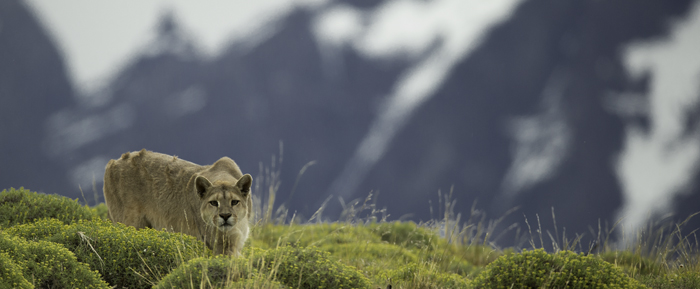
It was after 8 and we thought the shooting was finished when she left the kill. Diego, Mary, and I drove off to collect the other cars, and R and C started radioing us that the Sister was hunting. We didn’t quite get the message but Mary spotted the cat stalking and we did a quick U-turn and drove back, alerting everyone that a hunt was in progress!
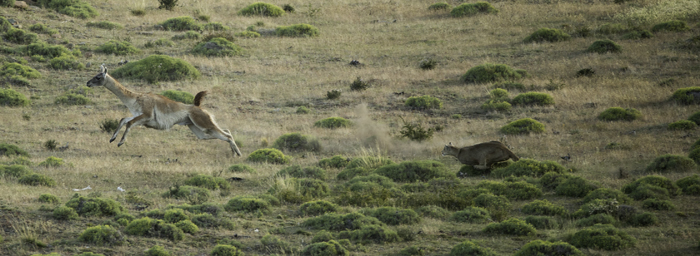
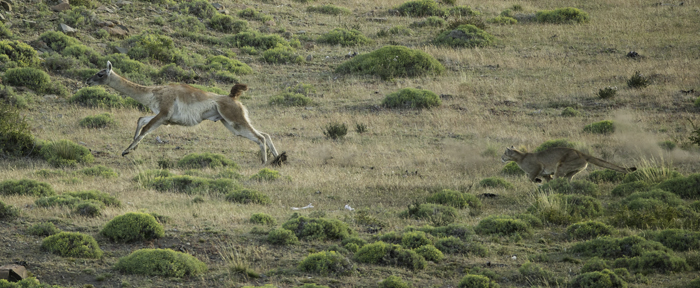

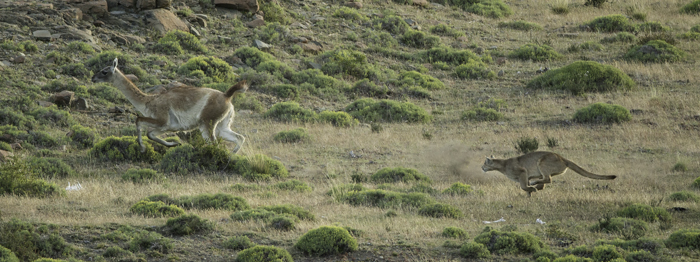
The ‘Sister’ stalked about 75 yards, completely in the open, as a lone Guanaco walked down the hill. The Puma hunkered down and the Guanaco walked in, getting to within 15 yards of the cat. Had the Puma waited for another two steps from the Guanaco she’d have caught it, but instead she charged, and we shot a great sequence as she bounded after the Guanaco. She missed, of course. Still, R and C had only seen this twice, and for Diego this was the first time – so the whole experience was absolutely precious.
Meanwhile, Mochita walked down from the cliffs and passed within an extremely short distance from R, while ‘tourists’ worried he was about to be killed. The Puma continued on to the kill, and we passed on the shooting – the light was low, and we had already shot incredible shots!
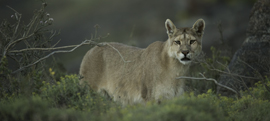 Day 11.
Day 11.
We intended to work on Puma so we left at 6 and right at the park entrance R and C had located Mochita, high on a ridge above HDQ. We waited, and at 6:20 she appeared on the edge of a ledge, then climbed down and approached the road before turning and following the cliff base where, at 6:40 she entered a cave and stayed there.
Meanwhile, Christina had found the Sister and we headed there. Rod was there by then, too, since we took a break for breakfast, and he said a Guanaco was approaching and the Puma was hunting. We power walked across the terrain, but the hunt was aborted. The puma stepped into a cave-ledge as I reached the cat and the shooting was marginal, but Guanacos were in the area so we waited. Bill, Don, and Rick went back for lunch while I walked back to the vehicle to get the remainders from breakfast for our lunch. While I was there, a pair of fighting
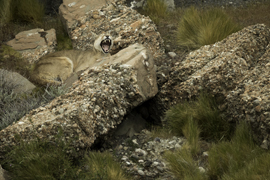
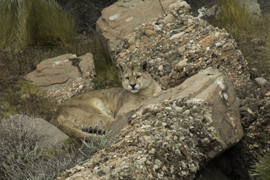
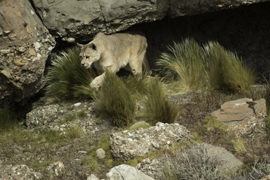
Guanacos raced down the slope between the photographers, another Guanaco climbed the ledge above the Puma to investigate, finally running off in alarm, and two other Guanacos passed right by her – but she fell asleep and missed it! Needless to say, I could have missed a spectacular show in the 40 minutes it took to hike the .55 mile to the car and back.
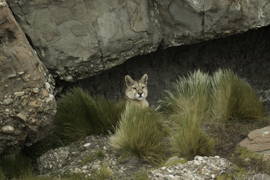 We stayed through the afternoon, suffering through wind and a light rain, and respites where the sun shone and the wind stopped. The Sister eventually emerged and groomed, and around 4:30 got up and started walking. We followed, and had the Puma stalking a Guanaco, walking straight at us as she hunted. All of the Guanacos saw her and gave alarm whinnies, and we left her, at 7PM walking towards the cliffs, as mist and rain shrouded the mastiff and a stiff, cold wind sprinkled us with erratic drops.
We stayed through the afternoon, suffering through wind and a light rain, and respites where the sun shone and the wind stopped. The Sister eventually emerged and groomed, and around 4:30 got up and started walking. We followed, and had the Puma stalking a Guanaco, walking straight at us as she hunted. All of the Guanacos saw her and gave alarm whinnies, and we left her, at 7PM walking towards the cliffs, as mist and rain shrouded the mastiff and a stiff, cold wind sprinkled us with erratic drops.
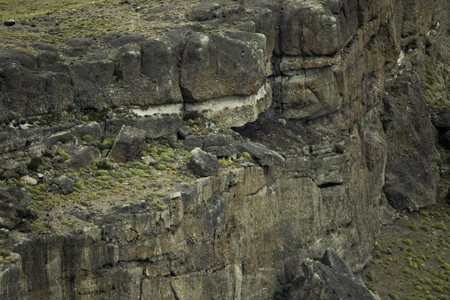
Look very carefully in the exact center of this image and you'll see a tiny pair of brown spots -- another Puma we spotted, nearly 1/2 mile away. Since we were already with one puma we did not follow up on this further one.
Day 12.
We left at 6:30, anticipating poor weather and intending to look for puma. Winds were too strong around Sarmiento for us to go there and as we rearranged our plans R and C found the mother Puma and the two cubs (from our first day of this trip) close to where we had them on our first encounter. This time, they were literally beside the road in a small stand of beech trees, although they were nearly completely hidden from view. I got out of the car with Don and Judy to look closer, and we could clearly see the cats about 20 feet away, looking at us, unconcerned. Judy and Angus set up on a ridge hoping to get the cats when they left the bushes, braving strong winds and rain, but the cats stayed hidden. Eventually, R and C spotted another Puma, Mochita, close by, sitting on a ridge overlooking the road.
We knew she wouldn’t go far so we took the time to have breakfast along the road, then the group headed uphill but they couldn’t find her. I was watching from the car – I hadn’t tried for the first cat, either, but I joined Diego in searching for the 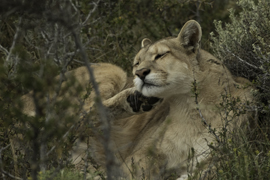 puma. Meanwhile, Rod walked up the hill and found her where he had left her, but in the interim she had curled up into a ball and was asleep. We joined Mochita there, and took several shots whenever she awoke and looked around, but it appeared as if she was settled in for the day and we left. Had this been our first cat – and it was frame-filling, we probably would have stayed all day, enduring the miserable weather. But now, after more than 20 sightings and well over a dozen shoots, we can be discriminating and sane.
puma. Meanwhile, Rod walked up the hill and found her where he had left her, but in the interim she had curled up into a ball and was asleep. We joined Mochita there, and took several shots whenever she awoke and looked around, but it appeared as if she was settled in for the day and we left. Had this been our first cat – and it was frame-filling, we probably would have stayed all day, enduring the miserable weather. But now, after more than 20 sightings and well over a dozen shoots, we can be discriminating and sane.
It was nearly 11:30 by the time we left the Puma and we headed back for the lodge, arriving around noon. After lunch Mary worked on post-trip memos while I slept. Whether I was exhausted from nearly two weeks of constant hiking and activity, or the lack of sleep due to a rotator-cuff injury for the last three days, or the over-compensating for the shoulder, or the mega-dose of sleep and pain pills I took last night, I was beat. I had slept soundly for once, and did the same throughout the afternoon.
PM. At 4:30 we headed up the Paine River to the cascades where everyone took some scenics, before continuing toward the foxes. Tom did a great pano-shot of Greater Rheas and chicks that were moving up the road, a brilliant shot that really told the story while the rest of us simply shot portraits. We continued on to a Guanaco herd while R and C looked for pigmy owls, and with the weather appearing to improve we headed for the Black-Chested Buzzard Eagles.
We arrived just as one of the birds flew to one of its favorite perches where it remained for portraits, then flew off, circled, and was gone. Angus left to work a swamp and got a great Snipe photo, and the weather cleared enough for the Towers to be visible, now wreathed in snow.
Today it was cold, all day, and most of the time the mountains were hidden. Those slopes visible had a veil of snow, and distant ridges looked completely covered. At dinner the weather cleared for a short time and the Towers themselves were etched in white, with each ridge and crevice catching a line of snow. By dinner’s conclusion they were covered again, and as I write this minutes before turning in for bed it is raining.
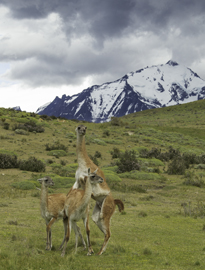
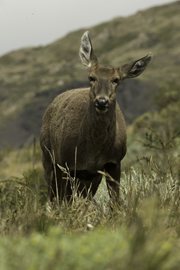
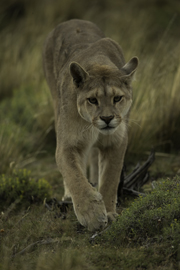
Day 13.
We left at 8, nearly 3 hours later than our average departure. We awoke to nearly frigid conditions, as it had rained the night before and a cold front moved through, coating the mountain and the lower slopes in snow. We had breakfast in the lodge at 7:30AM, our first and only cooked breakfast of the trip. At 8, when we headed into slightly higher country, small pockets of snow still lingered in the shade of low shrubs, while across the Rio Paine the forest was still snow covered. It was beautiful.
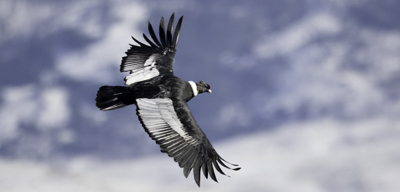 We stopped near the Stone House where 5 Andean Condors were soaring about, and with an 800mm and the 7D I had frame-fillers. An adult male and female, and three immatures soared around below and at our level, making a spectacular shooting opportunity.
We stopped near the Stone House where 5 Andean Condors were soaring about, and with an 800mm and the 7D I had frame-fillers. An adult male and female, and three immatures soared around below and at our level, making a spectacular shooting opportunity.
We continued towards Lago Gray, stopping several times for scenics, including at the Cascades, and we had lunch at the campground area. At the Explora Club hotel we had a great doe Huemel (deer) that was extremely tame. We were driving towards Lago Gray when R and C radioed that it was raining hard there, so we did a U-turn and headed back towards the campground area.
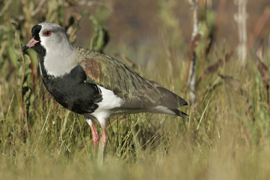
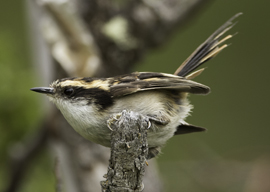
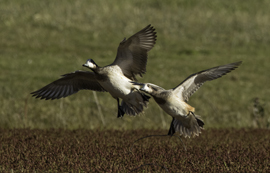
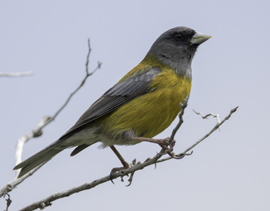

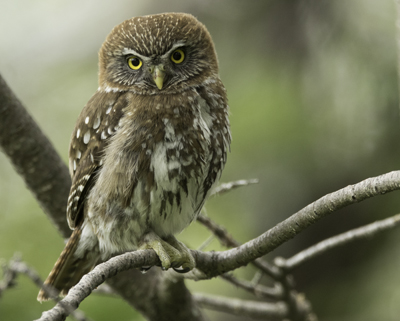
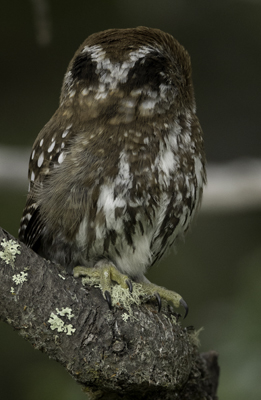
Austral Pigmy Owl. This small owl has false eye-spots on the back of its head
that may protect it from attack or harassment when perched.
There, in looking for a Magellanic Woodpecker, we found an extremely cooperative Austral Pigmy Owl, the first one of this species I’ve ever photographed. Our day concluded with more landscape shots and a visit to the Buzzard-Eagle, where we had modest success.
Day 14.
We planned on leaving at 5 but the eastern sky was soup and the mountains were shrouded in clouds. We left at 6 instead, and stopped at several locations for pumas. Close to the Sarmiento Gate I saw a Guanaco that looked alert and we stopped and rolled down the car windows to listen, and as I did so we saw Mochita, the Puma, walking across the road. Diego’s vehicle was far away so we piled out of our’s, and I raced uphill to intercept the puma, and fortunately saw her before she settled down in vegetation where she eventually went to sleep. Although the cat was close to the road she was invisible, and had I not seen her before she laid down we’d have completely missed her. We circled around a small ridge where we could look down upon the unconcerned cat, and photographed her until she fell asleep. Some Chilean students spotted us and climbed the hill to take a quick peek at the Puma, and of course they were thrilled.
We left her and headed toward the Foxes, and along the way shot Oystercatchers, Crested Ducks, and Rheas. The foxes were fairly cooperative, and we stayed at the den until 1PM before returning to the lodge.
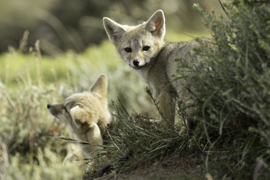 PM. Angus, Rick, and I did a final afternoon at the Foxes and did well. Most of the time the pups simply slept, but on several occasions they awoke and walked around us. I shot from a low angle for a different look, and in hindsight I wish I’d done so more often. Rick and I left the den early to return to the lodge to pack, and we encountered a pair of Hognosed Skunks along the way home. We thought it was a mother/pup pair, but as we watched it appeared as if the larger was trying to mate with the smaller – although they were shy and headed into the brush, so no photos.
PM. Angus, Rick, and I did a final afternoon at the Foxes and did well. Most of the time the pups simply slept, but on several occasions they awoke and walked around us. I shot from a low angle for a different look, and in hindsight I wish I’d done so more often. Rick and I left the den early to return to the lodge to pack, and we encountered a pair of Hognosed Skunks along the way home. We thought it was a mother/pup pair, but as we watched it appeared as if the larger was trying to mate with the smaller – although they were shy and headed into the brush, so no photos.
Our last evening was riotous and funny, filled with anecdotes and stories, and a great way to end a truly spectacular trip. Of course, the Pumas were the trip highlights, but great landscapes, birds, and mammals were also noted as well.
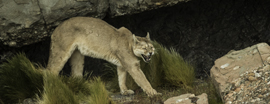 Regarding equipment, I used the new Canon 200-400mm zoom lens, which I borrowed from my friend, Sam Maglione. My lens was in for repair at CPS, as the rotating lens collar jammed, or stuck, for no reason, and did so with the lens foot basically upside down! I also used a Canon 800mm, which I used mainly for birds. We bought a new 7D Mark II right before the trip and our first shoots with it were very disappointing. The camera focused behind the
Regarding equipment, I used the new Canon 200-400mm zoom lens, which I borrowed from my friend, Sam Maglione. My lens was in for repair at CPS, as the rotating lens collar jammed, or stuck, for no reason, and did so with the lens foot basically upside down! I also used a Canon 800mm, which I used mainly for birds. We bought a new 7D Mark II right before the trip and our first shoots with it were very disappointing. The camera focused behind the 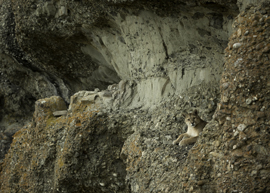 subject, and Mary's first shots of a Puma along a lake were useless. Later, I corrected the lens by using the micro adjustment, but I've been told that this new camera has had issues where that adjustment was not effective.
subject, and Mary's first shots of a Puma along a lake were useless. Later, I corrected the lens by using the micro adjustment, but I've been told that this new camera has had issues where that adjustment was not effective.
We carried our gear in our Gura Gear Bataflae bags, which are light weight and very water resistant, and extremely durable. In our vehicle I used a Vertex Long Lens Bag-- the same bag I use on safari and that I helped design. This bag was deep enough so that I could have the 800mm with the hood attached, and a camera body mounted, inside the bag and completely protected. On occasion I even hiked with that bag (it has shoulder straps) when I knew I'd only be using the 800mm. We used our Wimberley Gimbal Heads with our long lenses, and a Really Right Stuff BH40 for our landscape work. This year we mounted our heads on the following RRS clamps and plates:
TA-LBC: Round lever-release clamp
Round lever-release style quick-release clamp
TH-DVTL-55: Round Dovetail Plate
Round Dovetail Plate
TH-DVTL-40: Round Dovetail Plate
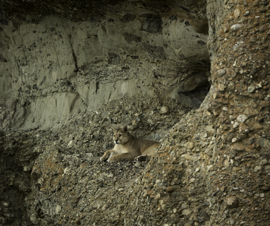
Round Dovetail Plate

This allowed us to quickly switch from our Wimberley to our BH40 without having to unscrew the heads. With the TA-LBC a simple move with the clamp and I had one head off, and a second later the other head on. This is a huge time-saver but also lessens the chance of stripping the 3/8th bolt of the tripod.
Both Mary and I, and most of our participants, used Hoodman CF cards. I was using 64gb cards, and using the firmware upgrade for their Steel 3.0 card reader I could download a full card in only a few minutes. The Hoodman cards have never failed me!
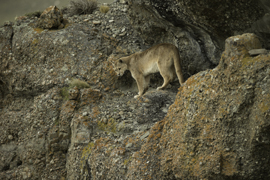 Because of scheduling conflicts with our guides and our own schedule, we will not be able to do this trip in 2015. However, we will be doing this trip in January, April, and possibly December of 2016. In April the days will be much shorter -- it is late fall here, and the fall color could be spectacular, but the attraction then is cubs. Puma cubs are born in January, usually, and by April will be out. Of course there is no guarantee we'll see cubs, but the shorter days, and the necessity of only hunting guanacos, makes this enticing! January will have a mix of subjects, and in December, birds will still be breeding and foxes denning.
Because of scheduling conflicts with our guides and our own schedule, we will not be able to do this trip in 2015. However, we will be doing this trip in January, April, and possibly December of 2016. In April the days will be much shorter -- it is late fall here, and the fall color could be spectacular, but the attraction then is cubs. Puma cubs are born in January, usually, and by April will be out. Of course there is no guarantee we'll see cubs, but the shorter days, and the necessity of only hunting guanacos, makes this enticing! January will have a mix of subjects, and in December, birds will still be breeding and foxes denning.
Details will be available in early 2015, but this will at least get you started. If you are interested, contact our office ASAP!
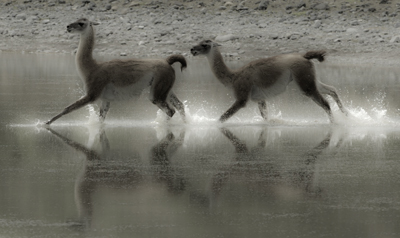
I can assure you no one offers anything approaching our trip. With three expert, experienced guides, and Mary and I, we have the best guide/participant ratio possible, 5:6, and we know what we're doing. Hopefully, the images in this report support that claim!
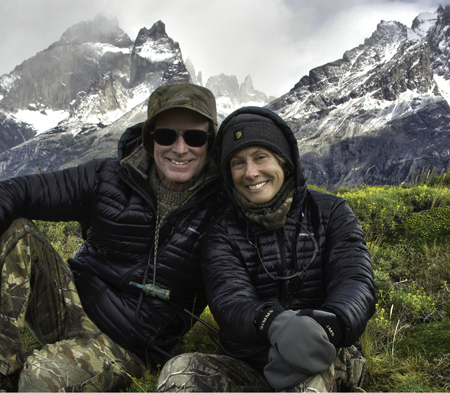
Trip Report/2016 Brochure
We will have a brochure available
for this Trip shortly. However, this report
will give you a great idea of the subjects we'll
be shooting and what we do.
Quest for the Puma
Torres Del Paine
Photo Safari-Tour
2014

Truly, this tour-photo safari is the culmination of a Quest that started around 12 years ago when I saw, but failed to photograph, my first Puma in Torres del Paine National Park. The guest of two Chilean friends, Alex and Gustavo Furman, I had seen and followed a Puma in the pre-dawn light, and at times I was within 25 yards of the unfazed cat. I'd started in the near-dark and had not expected to get anything more than a view of the Puma, so I didn't bother carrying gear. That experience, however, convinced me that photographing wild Pumas was possible, and over the following years I made several trips.

 In minutes the landscape changes as the sun rises, and dull gray clouds and steely mountaintops transform to fiery peaks and colorful clouds.
In minutes the landscape changes as the sun rises, and dull gray clouds and steely mountaintops transform to fiery peaks and colorful clouds.
Last year (see Scouting Report), I had the chance to meet Alex and his guide, Diego Arraya, that I've known as a friend since my second trip to Chile. Diego is twenty years younger than me and we call him 'son,' and he calls Mary and me 'Mommy and Daddy,' and we're like family. Diego had a group, but Mary and I were invited to join them at a Puma encounter where I had a chance to see how a group would work in photographing the cats. That experience confirmed my belief, and this year, for the first time, we did a trip with the main objective to photograph Pumas! We were wildly successful.
 In the trip report that follows I have not divided the two tours into two separate accounts since 5 of our 6 participants did both trips. Bill Sailer, Tom Wester, Don Lewis and Judy Johnson, and Angus Fraser did both trips, and our friends Steve Berkowitz and Rick Cover filled out the tours, respectively, and enjoyed incredible luck. How much luck? Between what our two guides saw (and that we may have
In the trip report that follows I have not divided the two tours into two separate accounts since 5 of our 6 participants did both trips. Bill Sailer, Tom Wester, Don Lewis and Judy Johnson, and Angus Fraser did both trips, and our friends Steve Berkowitz and Rick Cover filled out the tours, respectively, and enjoyed incredible luck. How much luck? Between what our two guides saw (and that we may have  missed) we had at least 16 different Pumas, and we had, in the two weeks of shooting, 32 sightings or photography sessions. Some of the cats we saw more than once, but we counted each as a session if we had taken a mid-day break, since we had to find the cats once again. On the few times we stayed with the cats all day we counted the encounters as only one session.
missed) we had at least 16 different Pumas, and we had, in the two weeks of shooting, 32 sightings or photography sessions. Some of the cats we saw more than once, but we counted each as a session if we had taken a mid-day break, since we had to find the cats once again. On the few times we stayed with the cats all day we counted the encounters as only one session.
Honestly, I don't think I've enjoyed a photo safari or tour more. It is such a thrill to be ON FOOT with a big, wild cat that went about its business unconcerned by our presence. We had two different Pumas stalk right past us, and we photographed an unsuccessful hunt/chase with one Puma, and just missed another by seconds. Our friend, Diego, has a wit and sense of humor that is, perhaps sadly, in synchrony with mine, and we simply had fun. Our two 'Trackers,' naturalist-photographer friends of Diego, Christina and Rodrigo, worked their butts off to find cats for us, and their efforts were extremely successful. With Mary, me, Diego, and our two trackers, we had a Guide Ratio of 5:6, and our combined spotting I think really paid off.

In addition to Pumas we photographed a great Patagonian Gray Fox den, Andean Condors, Guanacos doing everything, landscapes, and numerous birds. Our days were long -- we started between 4:30 and 5:30 most days, breaking at mid-day for a few hours rest and down-loading session, and another field session at 4:30 until ... whenever. Sometimes we didn't return back to our lodge until 9PM.

We'd start, usually, by seeking a dawn landscape while our Trackers searched for pumas. Usually we'd get a shoot in before going for Pumas, although on some days we went directly to the cats, and on two days we did not see a cat. On two days, one each tour, we didn't even look -- heading to a different part of the Park for landscapes, a rare and endangered species of Deer called a Huemul, and birds. Our average, for Pumas, was over 2 per day despite this!
 Unlike all of our other big cat photography, we photographed ALL of our Pumas while we were on foot, and not from a vehicle. Many of our cats were, at some point, stationary, but we did a lot of walking and we really worked hard. Pumas probably walk around 6mph, and a good human walking pace is around 3.5mph, so we really were working at times to keep up or to get ahead of a cat to position ourselves for a great shot. Although our walking speeds differed I don't think anyone ever missed a cat. Some were 'there' early, but everyone got there!
Unlike all of our other big cat photography, we photographed ALL of our Pumas while we were on foot, and not from a vehicle. Many of our cats were, at some point, stationary, but we did a lot of walking and we really worked hard. Pumas probably walk around 6mph, and a good human walking pace is around 3.5mph, so we really were working at times to keep up or to get ahead of a cat to position ourselves for a great shot. Although our walking speeds differed I don't think anyone ever missed a cat. Some were 'there' early, but everyone got there!
Still, it was a physical trip. My Cabela's boots failed, with a boot sole beginning to peel off, but luckily Diego had rubber glue that provided first-aid for the boot. I only mention this because in Rwanda the same style of boot did the exact same thing, with the sole peeling off. Both sets were new, so I was very annoyed. Both Mary and I had had back surgery this year, and Mary had her second total knee replacement, but we did well despite this. At the beginning of the second tour I either tore, irritated, or otherwise damaged my shoulder's rotator cuff, and for most of the second tour I couldn't lift my left arm higher than my chest. I often used a Canon 200-400mm zoom, loaned to me by my good friend Sam Maglione since my own lens' tripod collar had jammed in Tanzania and Canon's CPS would not loan me a lens while the other was being repaired. Last year I only took an 800mm lens, and I did take that lens this year, too, and used it mostly for birds. I rarely needed anything more than the big zoom (sometimes with the built-in converter) for the Puma shots.
If you don't bother to read the entire report, please skip to the end of the report for information about our next trips for the wild Pumas! Here's the report:



Our first puma, quite literally 5 minutes after we left our lodge to start
our photo
tour/safari on our Quest for the Puma!
Day 1. Our quest for the puma was satisfied in the first ten minutes of our trip. We had over-nighted in Punta Arenas, met a transit driver at 9, and proceeded to Porta Natales where we’d meet Diego, our outfitter who owns Wild Patagonia. I’ve known Diego for over 12 years when he had just begun his life centered around Torres del Paine, and since those days he’s built a nice little tour company.
When we arrived at the estancia where we’d be based for the next 12 days Diego radioed our spotters, Rod and Christina, and we learned they had a Puma! We could see their vehicle from the window of our lodge, and after a little looking we could see the Puma, too!
We had a meeting at 5, prepping the group on protocol, and began packing. While we were loading I saw a Guanaco walking across the hillside, seemingly straight at the Puma! We loaded as quickly as we could and raced the half mile to the cat but by the time we arrived everything was over.
Here’s what happened:
From their position, Rod and Christina could see the cat, which was lying facing away from the road. When the Guanaco approached, the cat reversed itself and flattened, and then disappeared. They were only about ten yards away from the Guanaco when the cat leaped from cover, having covered about thirty yards completely unseen by the two. The cat grabbed the back of the Guanaco and shifted to grab the neck, while the adult Guanaco ran down hill and started crossing the road. At that point, either the cat lost its grip or it lost its nerve and slid off, and the Guanaco ran to safety.
We arrived within a minute or two of this, and saw the Puma as it disappeared in thick brush less than thirty yards from the road. We walked uphill and got ourselves into position, and as R and C moved closer to find the cat it jumped out and ran uphill. They followed, and finally located the cat again.
 We hiked 100-200 yards up the steep hill and got into position, and a few minutes later the cat left cover and ran further up the hill. I was using an 800mm and I was too close for nearly all the shots, while those using a 200-400 had almost perfect composition as the cat ran by, fully in the open and in great light. It ran about 100 yards and stopped, and then leisurely walked further up hill and disappeared over a ridge.
We hiked 100-200 yards up the steep hill and got into position, and a few minutes later the cat left cover and ran further up the hill. I was using an 800mm and I was too close for nearly all the shots, while those using a 200-400 had almost perfect composition as the cat ran by, fully in the open and in great light. It ran about 100 yards and stopped, and then leisurely walked further up hill and disappeared over a ridge.
It was around 6:30PM and extremely windy, so we headed back to our lodge for a 7:30PM dinner. As we ate the gray clouds hanging over the mastiff moved in, slapping the windows with rain. The wind was fierce, and actually flapped the floor boards of the Restaurant, causing the chairs to rise up and down and move, as if haunted.
It was a great first afternoon and everyone got wonderful shots. If we did not see another Puma I think everyone would be satisfied – but hopefully there will be many more to come.
Day 2. Our first full day in the Park.
We left 4:45AM, hoping to do a sunrise of the mastiff, but it was shrouded in rain clouds. We drove to a spot where there would have been a reflection, had there been a mountain and had there been a quiet morning, but a gale-like wind made the reflection pond a cracked mirror of waves. We abandoned that location and headed west, to another overlook that encompassed the … River. Pink color was beginning to tint the clouds and the mountain mastiff revealed a bit more of itself, while a full arch of a rainbow spread across the southern edge. We photographed the scene until the rainbow disappeared and with it the enticing light.
We drove on looking for pumas. We did find a fresh Guanaco kill, with fresh, wet stomach contents and damp meat, with sticky blood on the fur. Mary dropped me off and I hiked to the top of a rocky ridge to look for the puma, while Rod and  Christina scoped on the opposite side looking for one on the lake-side of the road. I had a fox sneak up from behind, and I spooked it when I stood, but otherwise, no predators.
Christina scoped on the opposite side looking for one on the lake-side of the road. I had a fox sneak up from behind, and I spooked it when I stood, but otherwise, no predators.
Mary and Diego cruised the roads, stopping to photograph Magellanic Oystercatchers and ducks, and eventually stopping at the road below my rock outcrop where a group of Guanacos had gathered. I slowly made my way down, and for the rest of the morning we photographed the Guanacos as they ran about, chasing one another or grazing, sometimes within only a few yards of where we stood. I did a lot of slow-shutter speed shots, at 1/50th sec, to capture motion blur as the Guanacos ran by, which worked well.
 We took a mid-day break after lunch, and at 4:30 in a light rain headed back out. We were hoping to find Guanaco males that might be fighting, but they all were relaxed.
We took a mid-day break after lunch, and at 4:30 in a light rain headed back out. We were hoping to find Guanaco males that might be fighting, but they all were relaxed.
We continued to where Coscoroba Swans were swimming at a road-side lake. They then flew parallel to us, while Diego’s group did a nestling Crested Caracara. We got a radio call from Rod and Christina that they had spotted two pumas, and we raced to the area. One ended up being a shy collared female that eventually bolted from cover and ran right by Bill and Tom. Several others saw one of her cubs, but no shots. Mary spotted the female as it ran across the road and went following it but never got a chance to take a shot. By then it was past 8PM and time for dinner, with the light failing as we drove back to our lodge.
Day 3. Our Second Full day in the Park.
We awoke to clear skies and a light wind and headed to the ‘reflection’ lake where we photographed the sunrise. There was enough of a breeze to create chop, so we had no reflections, but wonderful light on the Towers. We thought we had finished and most of us had put away our gear when a second burst of wonderful color had us unpacking again and shooting more landscapes.
Rod and Christina were out scouting and found another pair of Pumas, close to where we had a cat yesterday. The two were visible but partially hidden in the vegetation, and when we positioned ourselves both got up, one at a time, and crossed into an opening before walking off, rounding a distant slope. Our two trackers, R and C, followed and Rod found the female by the lake, sitting on a rock by the shore. Unfortunately we had the directions wrong and when we crept to the edge we were facing the wrong way, straight ahead but with the cat to our extreme left and we missed it until it started walking away. The cat took shelter in the rocks, and because Steve only has the first week with us, we had him move in first. The cat got up and Steve got a great frame-filling shot of the Puma standing amongst the rocks. The puma continued up along the lake shore, away from where Angus, Tom, and I positioned ourselves, but Mary and Bill were overlooking the area and got great shots as the female went by. Rod followed and discovered the cat hooking up with another male.
Meanwhile, within sight of us, Christina was sitting, watching the first male. We positioned ourselves and after about an hour the male got up and walked away. Unfortunately, we had a line of our shooters paralleling the ridge and the message: ‘the cat is under THAT bush’ wasn’t properly conveyed down the line, and the folks in the back were looking further uphill and didn’t see the cat until it walked off.
We started hiking back to the vehicles but a large herd of Guanacos were feeding, running about, fighting viciously, and shepherding their newborn babies in the meadow before us. One male was nearly missing its entire lower jaw, and Diego got a shot where two males reared, spewing blood as they fought each other. We stayed there until nearly lunch, then did a quick circuit by the Swan Lake for more scenics, although I was so tired I was oddly unmotivated to shoot the mountain.
We had a break from 2 until 4:30, then headed out to look for cats. We stopped, first, to look for Austral Pigmy Owls, but were unsuccessful. In the same area,  though, a Black-chested Buzzard Eagle was nesting, and we had wonderful opportunities for the birds perched on a snag and in flight, circling us. Terrific images. R and C had no luck initially in finding a cat, although they did spot a kill we missed earlier, probably done yesterday. As we drove we found a very cooperative Hognose Skunk and spent about 1.5 hours with it, a surprisingly challenging subject that seemingly never stopped moving.
though, a Black-chested Buzzard Eagle was nesting, and we had wonderful opportunities for the birds perched on a snag and in flight, circling us. Terrific images. R and C had no luck initially in finding a cat, although they did spot a kill we missed earlier, probably done yesterday. As we drove we found a very cooperative Hognose Skunk and spent about 1.5 hours with it, a surprisingly challenging subject that seemingly never stopped moving.
It was getting late and we started back to our lodge when Christina spotted another Puma (our 6th for the day) about ½ mile away. No shots, but it was wonderful to watch a relaxed cat move across the mountain slope in the intense, golden light of the end of the day.

Day 3.
We left at our usual time, this time driving to a new overlook to get a view of the entire mountain mastiff, since the area was partly covered in clouds. To the east we had spectacular color, and I, too late, positioned Diego for a silhouette. Previously, as I posed with my tripod at a prominent spot, one of our shooters yelled, ‘you're in the shot!’, not recognizing that I WAS the shot! Afterwards, we drove back into the park to look for a Patagonian Gray Fox den, unsuccessfully, while our scouts found another den which we photographed from the road.
There, we had much frustration as several of us with new 7D Mark IIs, had focus sharpness issues. When we returned at lunch I did, for the first time, a Micro Adjustment on the camera, ending up at -.5 to hopefully compensate for the focus error.
 As of this writing, I had not yet checked the sharpness on the den shots, which had an adult and pups playing, wonderful shots, even if at a distance.
As of this writing, I had not yet checked the sharpness on the den shots, which had an adult and pups playing, wonderful shots, even if at a distance.
We headed towards the lodge but stopped at the Paine River Cascades where we spent about an hour photographing a family of Austral Negritos, a small songbird whose male we see everywhere but rarely get close to. Adult males are black with a rufous back, but the females and juveniles are brown, and the female here was feeding her fledged chicks mayfly adults she plucked from the river.
We took a two hour break, then returned to the same area at 5PM where we photographed Daisy Flowers at slow shutter speeds and with long telephotos, and distant shots of a colorful male Torrent Duck.


Afterwards we headed into the high country, and along the way Mary spotted, while driving, two Andean Condors perched on a ridge. They flew off when we neared, but we drove on ahead a few hundred yards and managed spectacular shots of an immature and adult female as they circled to gain height - the best shots I’ve ever made of Condors.

Continuing, we reached a large herd of Guanacos, with older juveniles fighting, rearing up on their hind legs against a blue sky background, and newborns running about, jumping, playing, and nursing. The light was the best we’ve had for an afternoon and we stayed until nearly 8:30PM, returning to the lodge only when wispy clouds began to mask the sun.
After dinner, at sunset – 10PM or so, we had great color on the clouds above the mastiff, which concluded a day without pumas, but a very successful day nonetheless.
Day 4.
We left early, at 4:30AM, to reach Nordensjold Lake overlook in time for sunrise. Although it did not look promising the light cooperated wonderfully and we had a great shoot. Meanwhile, R and C were scouting for puma and we received a radio-talk that they had a Puma that had just left a kill. We raced to the spot in time to see the male Puma from our first day appear, approaching the road. Angus, Steve, and I had to get out of the vehicle to get our gear and the cat hunkered down, then turned and crossed the road closer to Diego’s vehicle, where Judy, Don, Tom, and Bill shot from the windows. Mary thought that we probably spooked the cat – but we had little choice.

There is a Puma in this image. Look for the Puma head, left/center against
the large conglomerate rock on the upper left-center of the image.
We headed back deeper into the park and we missed the tailless Puma that apparently crossed the road and was, of course, spotted by R and C. We raced back in time to see the cat walking in full view along a cliff face of conglomerate rock.
Everyone piled out of the vehicles and joined R and C who were following along, paralleling the cat. We trailed behind, and I was last, since I took the time to attach my 200-400 (curtesy of my friend, Sam, who loaned me his since mine broke in Tanzania). I got a few brief shots before the cat disappeared over a rise in the rocks.
 The cat followed the edge of the ridge line, and we walked beneath. Several times the cat paused for a few seconds for shots. At one point the cat disappeared and I climbed down a loose-rock talus slope with my heavy 800mm over my shoulder and hand-carrying the 200-400 with a Gura Gear pack on my back. It was iffy footing and the cat, I was told, had gone back up to a higher spot. I retraced my steps, this time taking the time to stick the 200-400 in my pack, and just after I cleared the chute and I rounded a bend – there she was. The Puma stepped out onto a ridge overlooking the Paine River valley and simply posed, an absolutely stunning view.
The cat followed the edge of the ridge line, and we walked beneath. Several times the cat paused for a few seconds for shots. At one point the cat disappeared and I climbed down a loose-rock talus slope with my heavy 800mm over my shoulder and hand-carrying the 200-400 with a Gura Gear pack on my back. It was iffy footing and the cat, I was told, had gone back up to a higher spot. I retraced my steps, this time taking the time to stick the 200-400 in my pack, and just after I cleared the chute and I rounded a bend – there she was. The Puma stepped out onto a ridge overlooking the Paine River valley and simply posed, an absolutely stunning view.
 She stayed there for about an hour, switching eventually to give us a back view, and then finally dropping off the ledge and out of sight. Steve, Tom, and I backtracked, and had a brief glimpse of the cat, but it reversed itself again, and started walking at the base of the cliff edge. Rod and Angus were there, and followed the cat and Angus got some great shots of the Puma on a ledge or sitting, and peering, around the rocks. Beautiful shot.
She stayed there for about an hour, switching eventually to give us a back view, and then finally dropping off the ledge and out of sight. Steve, Tom, and I backtracked, and had a brief glimpse of the cat, but it reversed itself again, and started walking at the base of the cliff edge. Rod and Angus were there, and followed the cat and Angus got some great shots of the Puma on a ledge or sitting, and peering, around the rocks. Beautiful shot.
A male Andean Condor was perched further down the cliff and all of us shot it from a distance. Diego and I stalked closer, and putting a 2X on the 800 with the 7D Mark II I had frame-filling shots. Unfortunately, minus the 2X, the Condor eventually launched, and almost all of my shots with the 800 were soft. Very disappointing. Despite that disappointment, the Condor shooting was the  absolute best I ever had, even with the straight 800mm. As I write this, I haven’t checked for critical sharpness, but I trust that for the straight, perched shots, the 7D performed well.
absolute best I ever had, even with the straight 800mm. As I write this, I haven’t checked for critical sharpness, but I trust that for the straight, perched shots, the 7D performed well.
Angus was with Rod, who stayed behind to keep track of the Puma, while Angus climbed the talus and joined me on top where Christina informed us that the group was waiting for us at the vehicles.
We had a late breakfast, then headed down to where, yesterday, we found Porcelain Lilies. There was no wind, perfect for macro/flower work and we had about a half-hour of successful shooting before the wind kicked up, and we headed home for an on-time lunch.
At 4:30PM, exactly 12 hours later, we headed back out, first looking for Rheas which Angus and Steve shot from our car, and then heading back into the park where the male Puma had been spotted by R and C. My vehicle stopped for Condors and got to the site late, but those that were early were surprised when the tailless Puma emerged from the narrow cave where the male Puma was resting. Great shots, there. The tailless cat climbed on to the top of the rocks above the cave where she rested, and where Judy, Steve, Angus, and I climbed up to shoot her, while the others stayed back to wait for the male. Eventually she got up and  walked toward the cliffs, which she followed, before dropping onto a ridge line where she laid down, with the Torres del Paine towers in the background. Rod, in all the years, had never had an occasion where a Puma framed itself against the towers – magnificent! I had held back, since a Guanaco was moving down the ridge towards the male, but when I heard about the framing I got over as quickly as I could while still maintaining stealth as I negotiated the potentially noisy, loose conglomerate rock. I arrived in time for a couple of sequences before the cat moved again, finally coming to rest in the low vegetation.
walked toward the cliffs, which she followed, before dropping onto a ridge line where she laid down, with the Torres del Paine towers in the background. Rod, in all the years, had never had an occasion where a Puma framed itself against the towers – magnificent! I had held back, since a Guanaco was moving down the ridge towards the male, but when I heard about the framing I got over as quickly as I could while still maintaining stealth as I negotiated the potentially noisy, loose conglomerate rock. I arrived in time for a couple of sequences before the cat moved again, finally coming to rest in the low vegetation.
 Steve, Judy, and I, and R and C, had the cat close and I radioed the others to say, ‘Get here!’ They arrived while the cat was in deep sleep and it was getting past dinner time, and it was time to leave. I said, "Let’s give it ten minutes.', and Diego radioed the lodge to tell them we would be late. A few minutes later the cat woke up, stared directly at us after doing a few roll-overs and tongue-licking grooming sessions and then walked right to us, passing within 10 feet of us and completely unconcerned. She almost immediately went into a stalk, spotting a European Hare some distance away, but Guanacos spotted her and whinnied their alarm and she stopped, sitting, then lying down, where we left her to go home.
Steve, Judy, and I, and R and C, had the cat close and I radioed the others to say, ‘Get here!’ They arrived while the cat was in deep sleep and it was getting past dinner time, and it was time to leave. I said, "Let’s give it ten minutes.', and Diego radioed the lodge to tell them we would be late. A few minutes later the cat woke up, stared directly at us after doing a few roll-overs and tongue-licking grooming sessions and then walked right to us, passing within 10 feet of us and completely unconcerned. She almost immediately went into a stalk, spotting a European Hare some distance away, but Guanacos spotted her and whinnied their alarm and she stopped, sitting, then lying down, where we left her to go home.


Day 5.
We planned on driving to Lago Gray, where the Gray Glacier terminates and where an Austral beech forest attracts an entirely new set of subjects. We slept in, until 5 or so, to get a bit of rest, then headed out in an extremely fierce wind. As we approached Nordskjord Overlook the far end of Lake Sarmiento was a white froth from the wind, with white caps etching the lake. Angus went down towards the shoreline for a shot, while I used the shelter of the vehicle to do some telephoto extractions.
We stopped at the Lake Pahoe campground where we hoped to find a Red Fox or Red Wolf, an entirely different species from either the North American fox or wolf. We had no luck, but did quite well with Flickers and Leaf-cutters, and scenics of the mastiff from the lake side.




 We continued on, where R and C had located a Huemul Deer, a big whitetail-deer like animal that also resembles an elk. They had spotted a buck and a collared doe and after a long walk through spikey brush along a narrow trail, and a steep climb to a plateau, we were with the deer. The wind was fierce, but the deer cooperated with the buck walking down the hill towards us and eventually grazing so close that we had to back off. With great shots ‘in the can’ we left the deer, hoping for more subjects.
We continued on, where R and C had located a Huemul Deer, a big whitetail-deer like animal that also resembles an elk. They had spotted a buck and a collared doe and after a long walk through spikey brush along a narrow trail, and a steep climb to a plateau, we were with the deer. The wind was fierce, but the deer cooperated with the buck walking down the hill towards us and eventually grazing so close that we had to back off. With great shots ‘in the can’ we left the deer, hoping for more subjects.
After lunch I heard and saw Austral Thrushes dive-bombing into a big beech tree and Angus spotted the target, an Austral Pigmy-Owl. I went to get the group to show them the bird but it flew off while I was gone. I found it again, and we raced for our camera gear, but when we returned the bird was gone, permanently. R and C were going to look for Magellanic Woodpeckers but within minutes found a pair of Torrent Ducks downstream. We hiked to the shoreline and pushed our way through the vegetation to get to the river’s edge and set up, and the birds cooperated by rather quickly swimming upriver, stopping periodically to rest on a rock. Eventually the birds came so close that I had too much lens with an 800mm  and 7D, although the rest, with a bit smaller glass, were perfect. The birds continued upriver, then swam down, and perched together on a rock towards the far shoreline. All of us tried slow shutter speeds to convey the fast water, although I’m not sure that we succeeded, with the birds moving often and the wind buffeting our cameras.
and 7D, although the rest, with a bit smaller glass, were perfect. The birds continued upriver, then swam down, and perched together on a rock towards the far shoreline. All of us tried slow shutter speeds to convey the fast water, although I’m not sure that we succeeded, with the birds moving often and the wind buffeting our cameras.
We headed towards home at 5, stopping at the campground for more birds – Tyranets, Leaf-cutters, Juncos, and Racquet-tails, and en route, for a beautiful pair of Speckled Teal. We watched for pumas as we drove through the area but only found another Hognose Skunk, and arrived back at our lodge at 7:30.
Day 6.
We left at 5, intending to do sunrise at the ‘stone hut,’ an old stone structure that was erected as a condor blind. Sunrise was a non-event. Although we had color on the eastern clouds the mastiff was dull and simply brightened. The wind was hammering and ferocious; too difficult to stand and too taxing to enjoy shooting. We were within 100 yards of where we photographed the pumas yesterday, but this dawn, shooting would have been impossible.
We returned to the vehicle and Diego suggested staying in the area, driving up the road a bit to keep in contact with R and C in case they spotted a puma. We were still talking about this when we got a radio call that they had the tailless Puma again. We headed out from there, marching directly toward the cat. The Puma was on the move, walking at about 4mph to the south. We were able to anticipate the cat’s direction and several times position ourselves so that the cat approached us,


walking straight at us and passing closeby. At one point I had to back up, and in doing so stepped onto the muddy shoreline of the lake, promptly sinking to mid-calf in black mud. Luckily my pants leg covered my boot and my foot didn’t get wet, although it looked disgusting until it dried
.

 The Puma continued to one of the ‘Castle Cliffs,’ walking along unconcernedly until she almost walked out of sight. Something there spooked her and she raced along the base of the cliff, then climbed up to a ledge and cave that Diego said she frequented. There the Puma found another Puma already in the cave, but this Puma was shy and timid with the Tailless Puma, called ‘Mochita.’ The new Puma ran to the edge of the ledge, which dead-ended, and then she turned around. I expected the two to meet and greet, but instead the shy Puma raced down a shoot and bounded away, following the base of the cliff. Tom and Bill were low, and Tom got a wonderful series of shots as the Puma sprinted by, shooting at 1/125th so he had a GREAT pan.
The Puma continued to one of the ‘Castle Cliffs,’ walking along unconcernedly until she almost walked out of sight. Something there spooked her and she raced along the base of the cliff, then climbed up to a ledge and cave that Diego said she frequented. There the Puma found another Puma already in the cave, but this Puma was shy and timid with the Tailless Puma, called ‘Mochita.’ The new Puma ran to the edge of the ledge, which dead-ended, and then she turned around. I expected the two to meet and greet, but instead the shy Puma raced down a shoot and bounded away, following the base of the cliff. Tom and Bill were low, and Tom got a wonderful series of shots as the Puma sprinted by, shooting at 1/125th so he had a GREAT pan.
Meanwhile, Mochita simply sat or lay down or explored the ledge. Most of us climbed up to a knoll that was at the same elevation as the ledge, and from there we photographed the cat. After an hour or so the cat left the ledge, coming toward us and jumping down from the ledge to walk by us, and then the Puma continued back in the direction where we had started. Steve, Angus,
 and I tried to keep ahead of her to keep her in sight, and worked our butts off crossing the terrain. Once, I spooked out a European Hare that ran straight at the puma, but she was looking away and never saw the hare. Had she, I’d suspect that she’d have gone for it. But she didn’t see it!
and I tried to keep ahead of her to keep her in sight, and worked our butts off crossing the terrain. Once, I spooked out a European Hare that ran straight at the puma, but she was looking away and never saw the hare. Had she, I’d suspect that she’d have gone for it. But she didn’t see it!
Eventually Mochita walked to the edge of the road where she nestled into a bush and disappeared, only a few yards from the road. We left her there, and
at 5PM we set up over-looking where she was resting. A Guanaco with a leg injury was nearby and at one point walked very close to where the Puma was hiding. It never made a move, although we were in a perfect position! At 7:30 the cat woke up and began to roam about. After enjoying her moving about we headed for home with a wind that kicked up and would have made shooting impossible.
Day 7.
The last day of the first tour and Steve would be leaving us to return to the US. Everyone else is stayed on for the second tour. All of us went out at 5:30AM for a final search (for Steve) for Pumas, and we headed into the park and the area where, yesterday, we had Mochita. We had nothing.
R and C went hiking while the rest of us had breakfast, and we decided to stay in the area to listen for Guanaco alarm calls and to see if R or C saw anything. I

There is a puma in the right/center of this image, just to the left of the small cave.
headed out towards the Puma Castle, taking my 18X IS binocs to scan the rocks, and while I watched a long-tailed female Puma walked into view and settled in at a small cave above a ledge called ‘PacMan’, about 25 feet from the cave where we had the cats yesterday.
 I radioed the group and Diego and Angus carried in my lens and tripod, respectively, and we approached to the nearest ridge. We were still too far away so I hiked up to yesterday’s overlook and found we still had an angle on the new cat and I radioed everyone in. Most everyone got shots but I’m not sure if it was the sister of Mochita or the skittish cat from yesterday.
I radioed the group and Diego and Angus carried in my lens and tripod, respectively, and we approached to the nearest ridge. We were still too far away so I hiked up to yesterday’s overlook and found we still had an angle on the new cat and I radioed everyone in. Most everyone got shots but I’m not sure if it was the sister of Mochita or the skittish cat from yesterday.
The cat was very relaxed when I was there but as more of our group arrived, unfortunately talking and moving about far too much for an unknown cat, the cat got up and walked down the  ledge and disappeared. Mary arrived late and only got a back end view, but had everyone been cautious, quiet, and stayed low – as I had done when I scouted the position – I think we’d have had success. At lunch I addressed this, explaining how we’ve had so many pumas (16-17 now) that we’re taking them for granted and treating these wild sightings like zoo animals, and if we’re greedy and more concerned with getting an immediate shot, rather than being patient, we will have less success. Everyone agreed.
ledge and disappeared. Mary arrived late and only got a back end view, but had everyone been cautious, quiet, and stayed low – as I had done when I scouted the position – I think we’d have had success. At lunch I addressed this, explaining how we’ve had so many pumas (16-17 now) that we’re taking them for granted and treating these wild sightings like zoo animals, and if we’re greedy and more concerned with getting an immediate shot, rather than being patient, we will have less success. Everyone agreed.

We returned about 11 so that Steve could pack and at noon he and Diego headed to Puerto Natales where Steve would meet the driver to return him to Punta Arenas for his journey home. The rest of us had a longer rest, and at 5 headed back out, hoping to find the puma again. We were unsuccessful.
Instead, we went to the Black-chested Buzzard Eagle nest where we had great opportunities as a bird returned repeatedly to a perch tree, sometimes carrying sticks. I tried using the 7D Mark II, but somehow the AF setting was on AI Focus, instead of AI Servo, and the camera DOES NOT follow focus. It fires, regardless of being in focus or not, and I shot some spectacular sequences, all blurred. I was not happy. The rest of the group, familiar with their gear, got great shots.
We left at 8 and went to the Torres Lodge for dinner, a break from our lodge and a pleasant evening. Clear skies, with beautiful pink-orange wispy clouds to the east, framed the mountains as we called it a day.
 Day 8. The ‘Break Day’ between the two tours
Day 8. The ‘Break Day’ between the two tours
We left at 6AM to concentrate on pumas, although the eastern sky was clear and the light on the mastiff was orange and beautiful at sunrise. We headed directly to the puma castle area, and hiked out to a viewpoint to scan the cliffs. Mary thought she saw a cat in the cave, but to confirm we called Rod over who was most familiar with the landscape. The brown was just grass, but while he used my 18X binocs a tailed Puma climbed down the cliff and went into the cave! It didn’t stay long, reversing itself and jogging out, to settle on a ledge nearby. When the cat finally laid down it was impossible to discern as a cat – the white belly matched the cliff color perfectly.
We ate a quick breakfast and headed out to the cliff, but stupidly we didn’t keep an eye on the cat and it had moved off by the time we reached the cliff. We circled the area without luck, and moved on to the flamingo lagoon where Chilean Flamingos were feeding.

A large flock of ducks were in the lagoon as well, but when they flew, so did the flamingos, all of which flew to a nearby lagoon and not across the mountain face as we expected.
Afterwards we headed to the fox den but the pups were rather sleepy and the shooting  was marginal. En route, we photographed a Greater Rhea and little striped chicks, and later a Guanaco that was wading across the Coscoroba Swan lake. After leaving the den we returned to the lake where we had incredible sequences of fighting Guanacos chasing each other across the shallows, splashing water and biting at each other’s legs.
was marginal. En route, we photographed a Greater Rhea and little striped chicks, and later a Guanaco that was wading across the Coscoroba Swan lake. After leaving the den we returned to the lake where we had incredible sequences of fighting Guanacos chasing each other across the shallows, splashing water and biting at each other’s legs.





 PM. Rick reached the lodge with our guide Diego, and soon after we headed to Laguana Azul for grebes, but they were not nesting. A White-Winged Coot was and we had wonderful shots of the male returning with grasses to add to the nest, which the female occupied. Chiloe Wigeons, Crested Ducks, and Silvery Grebes were on the pond as well. When we first arrived, we spent a good deal of time with Lupine Flowers and the Towers, for nice macro shots and landscapes.
PM. Rick reached the lodge with our guide Diego, and soon after we headed to Laguana Azul for grebes, but they were not nesting. A White-Winged Coot was and we had wonderful shots of the male returning with grasses to add to the nest, which the female occupied. Chiloe Wigeons, Crested Ducks, and Silvery Grebes were on the pond as well. When we first arrived, we spent a good deal of time with Lupine Flowers and the Towers, for nice macro shots and landscapes.

 Day 9. The first official full day of the second tour
Day 9. The first official full day of the second tour
Our first day and we saw 5 different Pumas, while our scouts saw 3 more that we could have seen, for a total of 8 for the day! We started at Laguna Madre but low clouds to the east made for a rather dull sunrise and we headed towards Sarmiento where R and C spotted a mother Puma and large cub. They were a ‘tame’ pair, but they disappeared into the black brush and after waiting a while we drove on.
Not long after, we drove into the park to photograph Andean Ruddy Ducks, and Diego’s ex-girl friend, who was leading a group at the time, had a mother Puma with two cubs. We got to the location – just yards from the pond – and had more distant shots of the cubs and adult sticking their heads up above the reeds.



Additionally, a Short-eared Owl flew by several times, the first time we’ve had this owl in the park. The Ruddy Ducks were excellent too, with both males and females swimming close. Eventually the cats disappeared and we figured they were settled for the day and we moved on.
 We headed to the Gray Foxes and had our best session yet with the cubs out of the den, wrestling and chasing one another and, hopefully, this time the 7D Mark II performed well, set at a micro adjustment of -5.
We headed to the Gray Foxes and had our best session yet with the cubs out of the den, wrestling and chasing one another and, hopefully, this time the 7D Mark II performed well, set at a micro adjustment of -5.
PM. We left at 4:30 to meet R and C who were already with our Pumas and we sat on a hillside overlooking where they were in hiding until around 6:30, when the mother awoke and casually walked by to join her cubs. They went to the water to drink, then reversed, and walked in a clearing in front of us before disappearing in the woods, to emerge on our right where the female walked across and the more timid cubs jogged, or ran, to another stretch of forest. They stayed in cover then.



 We started toward home, but another guide told us of a male Puma he spotted, and we drove there. We found a nursing female Puma, who walked off. We tried catching up, and I actually walked within ten feet of her without seeing her hunkered in the brush. Tom was following, and saw the cat dash out and run by – I never saw her until she started climbing up a hillside on the opposite side of the road!
We started toward home, but another guide told us of a male Puma he spotted, and we drove there. We found a nursing female Puma, who walked off. We tried catching up, and I actually walked within ten feet of her without seeing her hunkered in the brush. Tom was following, and saw the cat dash out and run by – I never saw her until she started climbing up a hillside on the opposite side of the road!
That was not the cat we were looking for! That was a male, which we found, but he was shy and ran off, ending in a small thicket where we left him at peace. We drove home and missed a radio call from R and C who had found the 8th cat for the day, another female that was resting at the base of a ledge.
The evening was capped by a Chilean alcedo barbeque of lamb, and we drank and ate to excess.
Day 10. The best day ever, in all the trips I’ve done to Torres del Paine!
 We started at 6, heading to the ‘stone house’ area to look for Mochita or her tailed sister. Our three vehicles spread out across likely looking area and just as my vehicle was about to move on Angus spotted Mochita walking up a slope beside the road. She is a very relaxed Puma and we knew that wherever she went we’d have a good chance of catching up with her.
We started at 6, heading to the ‘stone house’ area to look for Mochita or her tailed sister. Our three vehicles spread out across likely looking area and just as my vehicle was about to move on Angus spotted Mochita walking up a slope beside the road. She is a very relaxed Puma and we knew that wherever she went we’d have a good chance of catching up with her.


She didn’t go far, climbing up to a nearby ledge where she sat, then moved on to another cave where we were going to leave her undisturbed. Everyone had put away their gear and we were about to head out when she got up and walked directly to me, passing by, with my gear still in my bag! She walked to a new resting place where we positioned ourselves again, and where she posed nicely, and where we left her when she settled down to sleep.








We headed out to the fox den and when we arrived all the foxes were sleeping. A cold front had moved in and we sat inside the vehicles watching the foxes in the distance, doing nothing. We were tempted to move on but the pups finally awoke and we moved in, with the pups and the mother completely oblivious to us. At one point several of the pups trotted to within ten feet of us, where they stood and watched us before moving back to the den. During the two hours or so they played, wrestled, chased one another, tossed dung balls and feathers, and did all of this close to us. Between the Puma and the Patagonian Gray Foxes I shot almost 2,000 frames. Mary’s back was killing her, and last night she gave herself a black eye when the microphone to our Walkie-Talkie sprang back and whacked her hard.
On the way back to the lodge we had a Hairy, or Yellow, Armadillo run across the road. This is so rare that R and C have only seen one! The Armadillo took shelter under the branch of a small shrub, and we were very close, but the shooting, unfortunately, was marginal.
 PM. We headed back to look for Mochita, and several vehicles were where we had left her, as she, and TWO other pumas, had been visible. We didn’t want to create a Yellowstone-like scene so we held back until the tourists left, when we headed into the rocks. R and C had located a ‘tailed’ Puma we assumed was the sister to Mochita, but we weren’t sure. When we found her, inside a cave, R and C thought the male was inside, too, but they didn’t really know. So, we waited, and sat for about an hour watching the cliff cave. During that time, a katabatic wind kicked up, with winds reaching about 60-70mph for about 5 minutes, beating against us. Then it stopped, and the air was calm again.
PM. We headed back to look for Mochita, and several vehicles were where we had left her, as she, and TWO other pumas, had been visible. We didn’t want to create a Yellowstone-like scene so we held back until the tourists left, when we headed into the rocks. R and C had located a ‘tailed’ Puma we assumed was the sister to Mochita, but we weren’t sure. When we found her, inside a cave, R and C thought the male was inside, too, but they didn’t really know. So, we waited, and sat for about an hour watching the cliff cave. During that time, a katabatic wind kicked up, with winds reaching about 60-70mph for about 5 minutes, beating against us. Then it stopped, and the air was calm again.


Soon after a Puma appeared, and as it turned out it was Mochita’s sister. She walked along the ridge, and at one point came right past me, continuing until she met up with Mochita. We were hoping for a neat interaction sequence but they were quite casual, bumping heads and rubbing and that was it. The ‘sister’ continued downhill, posing on top of a rock before moving down to a Guanaco kill a short distance from the road. There she fed, attracting some other tourists as she, and we, were quite visible.

It was after 8 and we thought the shooting was finished when she left the kill. Diego, Mary, and I drove off to collect the other cars, and R and C started radioing us that the Sister was hunting. We didn’t quite get the message but Mary spotted the cat stalking and we did a quick U-turn and drove back, alerting everyone that a hunt was in progress!




The ‘Sister’ stalked about 75 yards, completely in the open, as a lone Guanaco walked down the hill. The Puma hunkered down and the Guanaco walked in, getting to within 15 yards of the cat. Had the Puma waited for another two steps from the Guanaco she’d have caught it, but instead she charged, and we shot a great sequence as she bounded after the Guanaco. She missed, of course. Still, R and C had only seen this twice, and for Diego this was the first time – so the whole experience was absolutely precious.
Meanwhile, Mochita walked down from the cliffs and passed within an extremely short distance from R, while ‘tourists’ worried he was about to be killed. The Puma continued on to the kill, and we passed on the shooting – the light was low, and we had already shot incredible shots!
 Day 11.
Day 11.
We intended to work on Puma so we left at 6 and right at the park entrance R and C had located Mochita, high on a ridge above HDQ. We waited, and at 6:20 she appeared on the edge of a ledge, then climbed down and approached the road before turning and following the cliff base where, at 6:40 she entered a cave and stayed there.
Meanwhile, Christina had found the Sister and we headed there. Rod was there by then, too, since we took a break for breakfast, and he said a Guanaco was approaching and the Puma was hunting. We power walked across the terrain, but the hunt was aborted. The puma stepped into a cave-ledge as I reached the cat and the shooting was marginal, but Guanacos were in the area so we waited. Bill, Don, and Rick went back for lunch while I walked back to the vehicle to get the remainders from breakfast for our lunch. While I was there, a pair of fighting



Guanacos raced down the slope between the photographers, another Guanaco climbed the ledge above the Puma to investigate, finally running off in alarm, and two other Guanacos passed right by her – but she fell asleep and missed it! Needless to say, I could have missed a spectacular show in the 40 minutes it took to hike the .55 mile to the car and back.
 We stayed through the afternoon, suffering through wind and a light rain, and respites where the sun shone and the wind stopped. The Sister eventually emerged and groomed, and around 4:30 got up and started walking. We followed, and had the Puma stalking a Guanaco, walking straight at us as she hunted. All of the Guanacos saw her and gave alarm whinnies, and we left her, at 7PM walking towards the cliffs, as mist and rain shrouded the mastiff and a stiff, cold wind sprinkled us with erratic drops.
We stayed through the afternoon, suffering through wind and a light rain, and respites where the sun shone and the wind stopped. The Sister eventually emerged and groomed, and around 4:30 got up and started walking. We followed, and had the Puma stalking a Guanaco, walking straight at us as she hunted. All of the Guanacos saw her and gave alarm whinnies, and we left her, at 7PM walking towards the cliffs, as mist and rain shrouded the mastiff and a stiff, cold wind sprinkled us with erratic drops.

Look very carefully in the exact center of this image and you'll see a tiny pair of brown spots -- another Puma we spotted, nearly 1/2 mile away. Since we were already with one puma we did not follow up on this further one.
Day 12.
We left at 6:30, anticipating poor weather and intending to look for puma. Winds were too strong around Sarmiento for us to go there and as we rearranged our plans R and C found the mother Puma and the two cubs (from our first day of this trip) close to where we had them on our first encounter. This time, they were literally beside the road in a small stand of beech trees, although they were nearly completely hidden from view. I got out of the car with Don and Judy to look closer, and we could clearly see the cats about 20 feet away, looking at us, unconcerned. Judy and Angus set up on a ridge hoping to get the cats when they left the bushes, braving strong winds and rain, but the cats stayed hidden. Eventually, R and C spotted another Puma, Mochita, close by, sitting on a ridge overlooking the road.
We knew she wouldn’t go far so we took the time to have breakfast along the road, then the group headed uphill but they couldn’t find her. I was watching from the car – I hadn’t tried for the first cat, either, but I joined Diego in searching for the  puma. Meanwhile, Rod walked up the hill and found her where he had left her, but in the interim she had curled up into a ball and was asleep. We joined Mochita there, and took several shots whenever she awoke and looked around, but it appeared as if she was settled in for the day and we left. Had this been our first cat – and it was frame-filling, we probably would have stayed all day, enduring the miserable weather. But now, after more than 20 sightings and well over a dozen shoots, we can be discriminating and sane.
puma. Meanwhile, Rod walked up the hill and found her where he had left her, but in the interim she had curled up into a ball and was asleep. We joined Mochita there, and took several shots whenever she awoke and looked around, but it appeared as if she was settled in for the day and we left. Had this been our first cat – and it was frame-filling, we probably would have stayed all day, enduring the miserable weather. But now, after more than 20 sightings and well over a dozen shoots, we can be discriminating and sane.
It was nearly 11:30 by the time we left the Puma and we headed back for the lodge, arriving around noon. After lunch Mary worked on post-trip memos while I slept. Whether I was exhausted from nearly two weeks of constant hiking and activity, or the lack of sleep due to a rotator-cuff injury for the last three days, or the over-compensating for the shoulder, or the mega-dose of sleep and pain pills I took last night, I was beat. I had slept soundly for once, and did the same throughout the afternoon.
PM. At 4:30 we headed up the Paine River to the cascades where everyone took some scenics, before continuing toward the foxes. Tom did a great pano-shot of Greater Rheas and chicks that were moving up the road, a brilliant shot that really told the story while the rest of us simply shot portraits. We continued on to a Guanaco herd while R and C looked for pigmy owls, and with the weather appearing to improve we headed for the Black-Chested Buzzard Eagles.
We arrived just as one of the birds flew to one of its favorite perches where it remained for portraits, then flew off, circled, and was gone. Angus left to work a swamp and got a great Snipe photo, and the weather cleared enough for the Towers to be visible, now wreathed in snow.
Today it was cold, all day, and most of the time the mountains were hidden. Those slopes visible had a veil of snow, and distant ridges looked completely covered. At dinner the weather cleared for a short time and the Towers themselves were etched in white, with each ridge and crevice catching a line of snow. By dinner’s conclusion they were covered again, and as I write this minutes before turning in for bed it is raining.



Day 13.
We left at 8, nearly 3 hours later than our average departure. We awoke to nearly frigid conditions, as it had rained the night before and a cold front moved through, coating the mountain and the lower slopes in snow. We had breakfast in the lodge at 7:30AM, our first and only cooked breakfast of the trip. At 8, when we headed into slightly higher country, small pockets of snow still lingered in the shade of low shrubs, while across the Rio Paine the forest was still snow covered. It was beautiful.
 We stopped near the Stone House where 5 Andean Condors were soaring about, and with an 800mm and the 7D I had frame-fillers. An adult male and female, and three immatures soared around below and at our level, making a spectacular shooting opportunity.
We stopped near the Stone House where 5 Andean Condors were soaring about, and with an 800mm and the 7D I had frame-fillers. An adult male and female, and three immatures soared around below and at our level, making a spectacular shooting opportunity.
We continued towards Lago Gray, stopping several times for scenics, including at the Cascades, and we had lunch at the campground area. At the Explora Club hotel we had a great doe Huemel (deer) that was extremely tame. We were driving towards Lago Gray when R and C radioed that it was raining hard there, so we did a U-turn and headed back towards the campground area.







Austral Pigmy Owl. This small owl has false eye-spots on the back of its head
that may protect it from attack or harassment when perched.
There, in looking for a Magellanic Woodpecker, we found an extremely cooperative Austral Pigmy Owl, the first one of this species I’ve ever photographed. Our day concluded with more landscape shots and a visit to the Buzzard-Eagle, where we had modest success.
Day 14.
We planned on leaving at 5 but the eastern sky was soup and the mountains were shrouded in clouds. We left at 6 instead, and stopped at several locations for pumas. Close to the Sarmiento Gate I saw a Guanaco that looked alert and we stopped and rolled down the car windows to listen, and as I did so we saw Mochita, the Puma, walking across the road. Diego’s vehicle was far away so we piled out of our’s, and I raced uphill to intercept the puma, and fortunately saw her before she settled down in vegetation where she eventually went to sleep. Although the cat was close to the road she was invisible, and had I not seen her before she laid down we’d have completely missed her. We circled around a small ridge where we could look down upon the unconcerned cat, and photographed her until she fell asleep. Some Chilean students spotted us and climbed the hill to take a quick peek at the Puma, and of course they were thrilled.
We left her and headed toward the Foxes, and along the way shot Oystercatchers, Crested Ducks, and Rheas. The foxes were fairly cooperative, and we stayed at the den until 1PM before returning to the lodge.
 PM. Angus, Rick, and I did a final afternoon at the Foxes and did well. Most of the time the pups simply slept, but on several occasions they awoke and walked around us. I shot from a low angle for a different look, and in hindsight I wish I’d done so more often. Rick and I left the den early to return to the lodge to pack, and we encountered a pair of Hognosed Skunks along the way home. We thought it was a mother/pup pair, but as we watched it appeared as if the larger was trying to mate with the smaller – although they were shy and headed into the brush, so no photos.
PM. Angus, Rick, and I did a final afternoon at the Foxes and did well. Most of the time the pups simply slept, but on several occasions they awoke and walked around us. I shot from a low angle for a different look, and in hindsight I wish I’d done so more often. Rick and I left the den early to return to the lodge to pack, and we encountered a pair of Hognosed Skunks along the way home. We thought it was a mother/pup pair, but as we watched it appeared as if the larger was trying to mate with the smaller – although they were shy and headed into the brush, so no photos.
Our last evening was riotous and funny, filled with anecdotes and stories, and a great way to end a truly spectacular trip. Of course, the Pumas were the trip highlights, but great landscapes, birds, and mammals were also noted as well.
 Regarding equipment, I used the new Canon 200-400mm zoom lens, which I borrowed from my friend, Sam Maglione. My lens was in for repair at CPS, as the rotating lens collar jammed, or stuck, for no reason, and did so with the lens foot basically upside down! I also used a Canon 800mm, which I used mainly for birds. We bought a new 7D Mark II right before the trip and our first shoots with it were very disappointing. The camera focused behind the
Regarding equipment, I used the new Canon 200-400mm zoom lens, which I borrowed from my friend, Sam Maglione. My lens was in for repair at CPS, as the rotating lens collar jammed, or stuck, for no reason, and did so with the lens foot basically upside down! I also used a Canon 800mm, which I used mainly for birds. We bought a new 7D Mark II right before the trip and our first shoots with it were very disappointing. The camera focused behind the  subject, and Mary's first shots of a Puma along a lake were useless. Later, I corrected the lens by using the micro adjustment, but I've been told that this new camera has had issues where that adjustment was not effective.
subject, and Mary's first shots of a Puma along a lake were useless. Later, I corrected the lens by using the micro adjustment, but I've been told that this new camera has had issues where that adjustment was not effective.
We carried our gear in our Gura Gear Bataflae bags, which are light weight and very water resistant, and extremely durable. In our vehicle I used a Vertex Long Lens Bag-- the same bag I use on safari and that I helped design. This bag was deep enough so that I could have the 800mm with the hood attached, and a camera body mounted, inside the bag and completely protected. On occasion I even hiked with that bag (it has shoulder straps) when I knew I'd only be using the 800mm. We used our Wimberley Gimbal Heads with our long lenses, and a Really Right Stuff BH40 for our landscape work. This year we mounted our heads on the following RRS clamps and plates:
TA-LBC: Round lever-release clamp
Round lever-release style quick-release clamp
TH-DVTL-55: Round Dovetail Plate
Round Dovetail Plate
TH-DVTL-40: Round Dovetail Plate

Round Dovetail Plate

This allowed us to quickly switch from our Wimberley to our BH40 without having to unscrew the heads. With the TA-LBC a simple move with the clamp and I had one head off, and a second later the other head on. This is a huge time-saver but also lessens the chance of stripping the 3/8th bolt of the tripod.
Both Mary and I, and most of our participants, used Hoodman CF cards. I was using 64gb cards, and using the firmware upgrade for their Steel 3.0 card reader I could download a full card in only a few minutes. The Hoodman cards have never failed me!
 Because of scheduling conflicts with our guides and our own schedule, we will not be able to do this trip in 2015. However, we will be doing this trip in January, April, and possibly December of 2016. In April the days will be much shorter -- it is late fall here, and the fall color could be spectacular, but the attraction then is cubs. Puma cubs are born in January, usually, and by April will be out. Of course there is no guarantee we'll see cubs, but the shorter days, and the necessity of only hunting guanacos, makes this enticing! January will have a mix of subjects, and in December, birds will still be breeding and foxes denning.
Because of scheduling conflicts with our guides and our own schedule, we will not be able to do this trip in 2015. However, we will be doing this trip in January, April, and possibly December of 2016. In April the days will be much shorter -- it is late fall here, and the fall color could be spectacular, but the attraction then is cubs. Puma cubs are born in January, usually, and by April will be out. Of course there is no guarantee we'll see cubs, but the shorter days, and the necessity of only hunting guanacos, makes this enticing! January will have a mix of subjects, and in December, birds will still be breeding and foxes denning.
Details will be available in early 2015, but this will at least get you started. If you are interested, contact our office ASAP!

I can assure you no one offers anything approaching our trip. With three expert, experienced guides, and Mary and I, we have the best guide/participant ratio possible, 5:6, and we know what we're doing. Hopefully, the images in this report support that claim!

Trip Report/2016 Brochure
We will have a brochure available
for this Trip shortly. However, this report
will give you a great idea of the subjects we'll
be shooting and what we do.
Quest for the Puma
Torres Del Paine
Photo Safari-Tour
2014

Truly, this tour-photo safari is the culmination of a Quest that started around 12 years ago when I saw, but failed to photograph, my first Puma in Torres del Paine National Park. The guest of two Chilean friends, Alex and Gustavo Furman, I had seen and followed a Puma in the pre-dawn light, and at times I was within 25 yards of the unfazed cat. I'd started in the near-dark and had not expected to get anything more than a view of the Puma, so I didn't bother carrying gear. That experience, however, convinced me that photographing wild Pumas was possible, and over the following years I made several trips.

 In minutes the landscape changes as the sun rises, and dull gray clouds and steely mountaintops transform to fiery peaks and colorful clouds.
In minutes the landscape changes as the sun rises, and dull gray clouds and steely mountaintops transform to fiery peaks and colorful clouds.
Last year (see Scouting Report), I had the chance to meet Alex and his guide, Diego Arraya, that I've known as a friend since my second trip to Chile. Diego is twenty years younger than me and we call him 'son,' and he calls Mary and me 'Mommy and Daddy,' and we're like family. Diego had a group, but Mary and I were invited to join them at a Puma encounter where I had a chance to see how a group would work in photographing the cats. That experience confirmed my belief, and this year, for the first time, we did a trip with the main objective to photograph Pumas! We were wildly successful.
 In the trip report that follows I have not divided the two tours into two separate accounts since 5 of our 6 participants did both trips. Bill Sailer, Tom Wester, Don Lewis and Judy Johnson, and Angus Fraser did both trips, and our friends Steve Berkowitz and Rick Cover filled out the tours, respectively, and enjoyed incredible luck. How much luck? Between what our two guides saw (and that we may have
In the trip report that follows I have not divided the two tours into two separate accounts since 5 of our 6 participants did both trips. Bill Sailer, Tom Wester, Don Lewis and Judy Johnson, and Angus Fraser did both trips, and our friends Steve Berkowitz and Rick Cover filled out the tours, respectively, and enjoyed incredible luck. How much luck? Between what our two guides saw (and that we may have  missed) we had at least 16 different Pumas, and we had, in the two weeks of shooting, 32 sightings or photography sessions. Some of the cats we saw more than once, but we counted each as a session if we had taken a mid-day break, since we had to find the cats once again. On the few times we stayed with the cats all day we counted the encounters as only one session.
missed) we had at least 16 different Pumas, and we had, in the two weeks of shooting, 32 sightings or photography sessions. Some of the cats we saw more than once, but we counted each as a session if we had taken a mid-day break, since we had to find the cats once again. On the few times we stayed with the cats all day we counted the encounters as only one session.
Honestly, I don't think I've enjoyed a photo safari or tour more. It is such a thrill to be ON FOOT with a big, wild cat that went about its business unconcerned by our presence. We had two different Pumas stalk right past us, and we photographed an unsuccessful hunt/chase with one Puma, and just missed another by seconds. Our friend, Diego, has a wit and sense of humor that is, perhaps sadly, in synchrony with mine, and we simply had fun. Our two 'Trackers,' naturalist-photographer friends of Diego, Christina and Rodrigo, worked their butts off to find cats for us, and their efforts were extremely successful. With Mary, me, Diego, and our two trackers, we had a Guide Ratio of 5:6, and our combined spotting I think really paid off.

In addition to Pumas we photographed a great Patagonian Gray Fox den, Andean Condors, Guanacos doing everything, landscapes, and numerous birds. Our days were long -- we started between 4:30 and 5:30 most days, breaking at mid-day for a few hours rest and down-loading session, and another field session at 4:30 until ... whenever. Sometimes we didn't return back to our lodge until 9PM.

We'd start, usually, by seeking a dawn landscape while our Trackers searched for pumas. Usually we'd get a shoot in before going for Pumas, although on some days we went directly to the cats, and on two days we did not see a cat. On two days, one each tour, we didn't even look -- heading to a different part of the Park for landscapes, a rare and endangered species of Deer called a Huemul, and birds. Our average, for Pumas, was over 2 per day despite this!
 Unlike all of our other big cat photography, we photographed ALL of our Pumas while we were on foot, and not from a vehicle. Many of our cats were, at some point, stationary, but we did a lot of walking and we really worked hard. Pumas probably walk around 6mph, and a good human walking pace is around 3.5mph, so we really were working at times to keep up or to get ahead of a cat to position ourselves for a great shot. Although our walking speeds differed I don't think anyone ever missed a cat. Some were 'there' early, but everyone got there!
Unlike all of our other big cat photography, we photographed ALL of our Pumas while we were on foot, and not from a vehicle. Many of our cats were, at some point, stationary, but we did a lot of walking and we really worked hard. Pumas probably walk around 6mph, and a good human walking pace is around 3.5mph, so we really were working at times to keep up or to get ahead of a cat to position ourselves for a great shot. Although our walking speeds differed I don't think anyone ever missed a cat. Some were 'there' early, but everyone got there!
Still, it was a physical trip. My Cabela's boots failed, with a boot sole beginning to peel off, but luckily Diego had rubber glue that provided first-aid for the boot. I only mention this because in Rwanda the same style of boot did the exact same thing, with the sole peeling off. Both sets were new, so I was very annoyed. Both Mary and I had had back surgery this year, and Mary had her second total knee replacement, but we did well despite this. At the beginning of the second tour I either tore, irritated, or otherwise damaged my shoulder's rotator cuff, and for most of the second tour I couldn't lift my left arm higher than my chest. I often used a Canon 200-400mm zoom, loaned to me by my good friend Sam Maglione since my own lens' tripod collar had jammed in Tanzania and Canon's CPS would not loan me a lens while the other was being repaired. Last year I only took an 800mm lens, and I did take that lens this year, too, and used it mostly for birds. I rarely needed anything more than the big zoom (sometimes with the built-in converter) for the Puma shots.
If you don't bother to read the entire report, please skip to the end of the report for information about our next trips for the wild Pumas! Here's the report:



Our first puma, quite literally 5 minutes after we left our lodge to start
our photo
tour/safari on our Quest for the Puma!
Day 1. Our quest for the puma was satisfied in the first ten minutes of our trip. We had over-nighted in Punta Arenas, met a transit driver at 9, and proceeded to Porta Natales where we’d meet Diego, our outfitter who owns Wild Patagonia. I’ve known Diego for over 12 years when he had just begun his life centered around Torres del Paine, and since those days he’s built a nice little tour company.
When we arrived at the estancia where we’d be based for the next 12 days Diego radioed our spotters, Rod and Christina, and we learned they had a Puma! We could see their vehicle from the window of our lodge, and after a little looking we could see the Puma, too!
We had a meeting at 5, prepping the group on protocol, and began packing. While we were loading I saw a Guanaco walking across the hillside, seemingly straight at the Puma! We loaded as quickly as we could and raced the half mile to the cat but by the time we arrived everything was over.
Here’s what happened:
From their position, Rod and Christina could see the cat, which was lying facing away from the road. When the Guanaco approached, the cat reversed itself and flattened, and then disappeared. They were only about ten yards away from the Guanaco when the cat leaped from cover, having covered about thirty yards completely unseen by the two. The cat grabbed the back of the Guanaco and shifted to grab the neck, while the adult Guanaco ran down hill and started crossing the road. At that point, either the cat lost its grip or it lost its nerve and slid off, and the Guanaco ran to safety.
We arrived within a minute or two of this, and saw the Puma as it disappeared in thick brush less than thirty yards from the road. We walked uphill and got ourselves into position, and as R and C moved closer to find the cat it jumped out and ran uphill. They followed, and finally located the cat again.
 We hiked 100-200 yards up the steep hill and got into position, and a few minutes later the cat left cover and ran further up the hill. I was using an 800mm and I was too close for nearly all the shots, while those using a 200-400 had almost perfect composition as the cat ran by, fully in the open and in great light. It ran about 100 yards and stopped, and then leisurely walked further up hill and disappeared over a ridge.
We hiked 100-200 yards up the steep hill and got into position, and a few minutes later the cat left cover and ran further up the hill. I was using an 800mm and I was too close for nearly all the shots, while those using a 200-400 had almost perfect composition as the cat ran by, fully in the open and in great light. It ran about 100 yards and stopped, and then leisurely walked further up hill and disappeared over a ridge.
It was around 6:30PM and extremely windy, so we headed back to our lodge for a 7:30PM dinner. As we ate the gray clouds hanging over the mastiff moved in, slapping the windows with rain. The wind was fierce, and actually flapped the floor boards of the Restaurant, causing the chairs to rise up and down and move, as if haunted.
It was a great first afternoon and everyone got wonderful shots. If we did not see another Puma I think everyone would be satisfied – but hopefully there will be many more to come.
Day 2. Our first full day in the Park.
We left 4:45AM, hoping to do a sunrise of the mastiff, but it was shrouded in rain clouds. We drove to a spot where there would have been a reflection, had there been a mountain and had there been a quiet morning, but a gale-like wind made the reflection pond a cracked mirror of waves. We abandoned that location and headed west, to another overlook that encompassed the … River. Pink color was beginning to tint the clouds and the mountain mastiff revealed a bit more of itself, while a full arch of a rainbow spread across the southern edge. We photographed the scene until the rainbow disappeared and with it the enticing light.
We drove on looking for pumas. We did find a fresh Guanaco kill, with fresh, wet stomach contents and damp meat, with sticky blood on the fur. Mary dropped me off and I hiked to the top of a rocky ridge to look for the puma, while Rod and  Christina scoped on the opposite side looking for one on the lake-side of the road. I had a fox sneak up from behind, and I spooked it when I stood, but otherwise, no predators.
Christina scoped on the opposite side looking for one on the lake-side of the road. I had a fox sneak up from behind, and I spooked it when I stood, but otherwise, no predators.
Mary and Diego cruised the roads, stopping to photograph Magellanic Oystercatchers and ducks, and eventually stopping at the road below my rock outcrop where a group of Guanacos had gathered. I slowly made my way down, and for the rest of the morning we photographed the Guanacos as they ran about, chasing one another or grazing, sometimes within only a few yards of where we stood. I did a lot of slow-shutter speed shots, at 1/50th sec, to capture motion blur as the Guanacos ran by, which worked well.
 We took a mid-day break after lunch, and at 4:30 in a light rain headed back out. We were hoping to find Guanaco males that might be fighting, but they all were relaxed.
We took a mid-day break after lunch, and at 4:30 in a light rain headed back out. We were hoping to find Guanaco males that might be fighting, but they all were relaxed.
We continued to where Coscoroba Swans were swimming at a road-side lake. They then flew parallel to us, while Diego’s group did a nestling Crested Caracara. We got a radio call from Rod and Christina that they had spotted two pumas, and we raced to the area. One ended up being a shy collared female that eventually bolted from cover and ran right by Bill and Tom. Several others saw one of her cubs, but no shots. Mary spotted the female as it ran across the road and went following it but never got a chance to take a shot. By then it was past 8PM and time for dinner, with the light failing as we drove back to our lodge.
Day 3. Our Second Full day in the Park.
We awoke to clear skies and a light wind and headed to the ‘reflection’ lake where we photographed the sunrise. There was enough of a breeze to create chop, so we had no reflections, but wonderful light on the Towers. We thought we had finished and most of us had put away our gear when a second burst of wonderful color had us unpacking again and shooting more landscapes.
Rod and Christina were out scouting and found another pair of Pumas, close to where we had a cat yesterday. The two were visible but partially hidden in the vegetation, and when we positioned ourselves both got up, one at a time, and crossed into an opening before walking off, rounding a distant slope. Our two trackers, R and C, followed and Rod found the female by the lake, sitting on a rock by the shore. Unfortunately we had the directions wrong and when we crept to the edge we were facing the wrong way, straight ahead but with the cat to our extreme left and we missed it until it started walking away. The cat took shelter in the rocks, and because Steve only has the first week with us, we had him move in first. The cat got up and Steve got a great frame-filling shot of the Puma standing amongst the rocks. The puma continued up along the lake shore, away from where Angus, Tom, and I positioned ourselves, but Mary and Bill were overlooking the area and got great shots as the female went by. Rod followed and discovered the cat hooking up with another male.
Meanwhile, within sight of us, Christina was sitting, watching the first male. We positioned ourselves and after about an hour the male got up and walked away. Unfortunately, we had a line of our shooters paralleling the ridge and the message: ‘the cat is under THAT bush’ wasn’t properly conveyed down the line, and the folks in the back were looking further uphill and didn’t see the cat until it walked off.
We started hiking back to the vehicles but a large herd of Guanacos were feeding, running about, fighting viciously, and shepherding their newborn babies in the meadow before us. One male was nearly missing its entire lower jaw, and Diego got a shot where two males reared, spewing blood as they fought each other. We stayed there until nearly lunch, then did a quick circuit by the Swan Lake for more scenics, although I was so tired I was oddly unmotivated to shoot the mountain.
We had a break from 2 until 4:30, then headed out to look for cats. We stopped, first, to look for Austral Pigmy Owls, but were unsuccessful. In the same area,  though, a Black-chested Buzzard Eagle was nesting, and we had wonderful opportunities for the birds perched on a snag and in flight, circling us. Terrific images. R and C had no luck initially in finding a cat, although they did spot a kill we missed earlier, probably done yesterday. As we drove we found a very cooperative Hognose Skunk and spent about 1.5 hours with it, a surprisingly challenging subject that seemingly never stopped moving.
though, a Black-chested Buzzard Eagle was nesting, and we had wonderful opportunities for the birds perched on a snag and in flight, circling us. Terrific images. R and C had no luck initially in finding a cat, although they did spot a kill we missed earlier, probably done yesterday. As we drove we found a very cooperative Hognose Skunk and spent about 1.5 hours with it, a surprisingly challenging subject that seemingly never stopped moving.
It was getting late and we started back to our lodge when Christina spotted another Puma (our 6th for the day) about ½ mile away. No shots, but it was wonderful to watch a relaxed cat move across the mountain slope in the intense, golden light of the end of the day.

Day 3.
We left at our usual time, this time driving to a new overlook to get a view of the entire mountain mastiff, since the area was partly covered in clouds. To the east we had spectacular color, and I, too late, positioned Diego for a silhouette. Previously, as I posed with my tripod at a prominent spot, one of our shooters yelled, ‘you're in the shot!’, not recognizing that I WAS the shot! Afterwards, we drove back into the park to look for a Patagonian Gray Fox den, unsuccessfully, while our scouts found another den which we photographed from the road.
There, we had much frustration as several of us with new 7D Mark IIs, had focus sharpness issues. When we returned at lunch I did, for the first time, a Micro Adjustment on the camera, ending up at -.5 to hopefully compensate for the focus error.
 As of this writing, I had not yet checked the sharpness on the den shots, which had an adult and pups playing, wonderful shots, even if at a distance.
As of this writing, I had not yet checked the sharpness on the den shots, which had an adult and pups playing, wonderful shots, even if at a distance.
We headed towards the lodge but stopped at the Paine River Cascades where we spent about an hour photographing a family of Austral Negritos, a small songbird whose male we see everywhere but rarely get close to. Adult males are black with a rufous back, but the females and juveniles are brown, and the female here was feeding her fledged chicks mayfly adults she plucked from the river.
We took a two hour break, then returned to the same area at 5PM where we photographed Daisy Flowers at slow shutter speeds and with long telephotos, and distant shots of a colorful male Torrent Duck.


Afterwards we headed into the high country, and along the way Mary spotted, while driving, two Andean Condors perched on a ridge. They flew off when we neared, but we drove on ahead a few hundred yards and managed spectacular shots of an immature and adult female as they circled to gain height - the best shots I’ve ever made of Condors.

Continuing, we reached a large herd of Guanacos, with older juveniles fighting, rearing up on their hind legs against a blue sky background, and newborns running about, jumping, playing, and nursing. The light was the best we’ve had for an afternoon and we stayed until nearly 8:30PM, returning to the lodge only when wispy clouds began to mask the sun.
After dinner, at sunset – 10PM or so, we had great color on the clouds above the mastiff, which concluded a day without pumas, but a very successful day nonetheless.
Day 4.
We left early, at 4:30AM, to reach Nordensjold Lake overlook in time for sunrise. Although it did not look promising the light cooperated wonderfully and we had a great shoot. Meanwhile, R and C were scouting for puma and we received a radio-talk that they had a Puma that had just left a kill. We raced to the spot in time to see the male Puma from our first day appear, approaching the road. Angus, Steve, and I had to get out of the vehicle to get our gear and the cat hunkered down, then turned and crossed the road closer to Diego’s vehicle, where Judy, Don, Tom, and Bill shot from the windows. Mary thought that we probably spooked the cat – but we had little choice.

There is a Puma in this image. Look for the Puma head, left/center against
the large conglomerate rock on the upper left-center of the image.
We headed back deeper into the park and we missed the tailless Puma that apparently crossed the road and was, of course, spotted by R and C. We raced back in time to see the cat walking in full view along a cliff face of conglomerate rock.
Everyone piled out of the vehicles and joined R and C who were following along, paralleling the cat. We trailed behind, and I was last, since I took the time to attach my 200-400 (curtesy of my friend, Sam, who loaned me his since mine broke in Tanzania). I got a few brief shots before the cat disappeared over a rise in the rocks.
 The cat followed the edge of the ridge line, and we walked beneath. Several times the cat paused for a few seconds for shots. At one point the cat disappeared and I climbed down a loose-rock talus slope with my heavy 800mm over my shoulder and hand-carrying the 200-400 with a Gura Gear pack on my back. It was iffy footing and the cat, I was told, had gone back up to a higher spot. I retraced my steps, this time taking the time to stick the 200-400 in my pack, and just after I cleared the chute and I rounded a bend – there she was. The Puma stepped out onto a ridge overlooking the Paine River valley and simply posed, an absolutely stunning view.
The cat followed the edge of the ridge line, and we walked beneath. Several times the cat paused for a few seconds for shots. At one point the cat disappeared and I climbed down a loose-rock talus slope with my heavy 800mm over my shoulder and hand-carrying the 200-400 with a Gura Gear pack on my back. It was iffy footing and the cat, I was told, had gone back up to a higher spot. I retraced my steps, this time taking the time to stick the 200-400 in my pack, and just after I cleared the chute and I rounded a bend – there she was. The Puma stepped out onto a ridge overlooking the Paine River valley and simply posed, an absolutely stunning view.
 She stayed there for about an hour, switching eventually to give us a back view, and then finally dropping off the ledge and out of sight. Steve, Tom, and I backtracked, and had a brief glimpse of the cat, but it reversed itself again, and started walking at the base of the cliff edge. Rod and Angus were there, and followed the cat and Angus got some great shots of the Puma on a ledge or sitting, and peering, around the rocks. Beautiful shot.
She stayed there for about an hour, switching eventually to give us a back view, and then finally dropping off the ledge and out of sight. Steve, Tom, and I backtracked, and had a brief glimpse of the cat, but it reversed itself again, and started walking at the base of the cliff edge. Rod and Angus were there, and followed the cat and Angus got some great shots of the Puma on a ledge or sitting, and peering, around the rocks. Beautiful shot.
A male Andean Condor was perched further down the cliff and all of us shot it from a distance. Diego and I stalked closer, and putting a 2X on the 800 with the 7D Mark II I had frame-filling shots. Unfortunately, minus the 2X, the Condor eventually launched, and almost all of my shots with the 800 were soft. Very disappointing. Despite that disappointment, the Condor shooting was the  absolute best I ever had, even with the straight 800mm. As I write this, I haven’t checked for critical sharpness, but I trust that for the straight, perched shots, the 7D performed well.
absolute best I ever had, even with the straight 800mm. As I write this, I haven’t checked for critical sharpness, but I trust that for the straight, perched shots, the 7D performed well.
Angus was with Rod, who stayed behind to keep track of the Puma, while Angus climbed the talus and joined me on top where Christina informed us that the group was waiting for us at the vehicles.
We had a late breakfast, then headed down to where, yesterday, we found Porcelain Lilies. There was no wind, perfect for macro/flower work and we had about a half-hour of successful shooting before the wind kicked up, and we headed home for an on-time lunch.
At 4:30PM, exactly 12 hours later, we headed back out, first looking for Rheas which Angus and Steve shot from our car, and then heading back into the park where the male Puma had been spotted by R and C. My vehicle stopped for Condors and got to the site late, but those that were early were surprised when the tailless Puma emerged from the narrow cave where the male Puma was resting. Great shots, there. The tailless cat climbed on to the top of the rocks above the cave where she rested, and where Judy, Steve, Angus, and I climbed up to shoot her, while the others stayed back to wait for the male. Eventually she got up and  walked toward the cliffs, which she followed, before dropping onto a ridge line where she laid down, with the Torres del Paine towers in the background. Rod, in all the years, had never had an occasion where a Puma framed itself against the towers – magnificent! I had held back, since a Guanaco was moving down the ridge towards the male, but when I heard about the framing I got over as quickly as I could while still maintaining stealth as I negotiated the potentially noisy, loose conglomerate rock. I arrived in time for a couple of sequences before the cat moved again, finally coming to rest in the low vegetation.
walked toward the cliffs, which she followed, before dropping onto a ridge line where she laid down, with the Torres del Paine towers in the background. Rod, in all the years, had never had an occasion where a Puma framed itself against the towers – magnificent! I had held back, since a Guanaco was moving down the ridge towards the male, but when I heard about the framing I got over as quickly as I could while still maintaining stealth as I negotiated the potentially noisy, loose conglomerate rock. I arrived in time for a couple of sequences before the cat moved again, finally coming to rest in the low vegetation.
 Steve, Judy, and I, and R and C, had the cat close and I radioed the others to say, ‘Get here!’ They arrived while the cat was in deep sleep and it was getting past dinner time, and it was time to leave. I said, "Let’s give it ten minutes.', and Diego radioed the lodge to tell them we would be late. A few minutes later the cat woke up, stared directly at us after doing a few roll-overs and tongue-licking grooming sessions and then walked right to us, passing within 10 feet of us and completely unconcerned. She almost immediately went into a stalk, spotting a European Hare some distance away, but Guanacos spotted her and whinnied their alarm and she stopped, sitting, then lying down, where we left her to go home.
Steve, Judy, and I, and R and C, had the cat close and I radioed the others to say, ‘Get here!’ They arrived while the cat was in deep sleep and it was getting past dinner time, and it was time to leave. I said, "Let’s give it ten minutes.', and Diego radioed the lodge to tell them we would be late. A few minutes later the cat woke up, stared directly at us after doing a few roll-overs and tongue-licking grooming sessions and then walked right to us, passing within 10 feet of us and completely unconcerned. She almost immediately went into a stalk, spotting a European Hare some distance away, but Guanacos spotted her and whinnied their alarm and she stopped, sitting, then lying down, where we left her to go home.


Day 5.
We planned on driving to Lago Gray, where the Gray Glacier terminates and where an Austral beech forest attracts an entirely new set of subjects. We slept in, until 5 or so, to get a bit of rest, then headed out in an extremely fierce wind. As we approached Nordskjord Overlook the far end of Lake Sarmiento was a white froth from the wind, with white caps etching the lake. Angus went down towards the shoreline for a shot, while I used the shelter of the vehicle to do some telephoto extractions.
We stopped at the Lake Pahoe campground where we hoped to find a Red Fox or Red Wolf, an entirely different species from either the North American fox or wolf. We had no luck, but did quite well with Flickers and Leaf-cutters, and scenics of the mastiff from the lake side.




 We continued on, where R and C had located a Huemul Deer, a big whitetail-deer like animal that also resembles an elk. They had spotted a buck and a collared doe and after a long walk through spikey brush along a narrow trail, and a steep climb to a plateau, we were with the deer. The wind was fierce, but the deer cooperated with the buck walking down the hill towards us and eventually grazing so close that we had to back off. With great shots ‘in the can’ we left the deer, hoping for more subjects.
We continued on, where R and C had located a Huemul Deer, a big whitetail-deer like animal that also resembles an elk. They had spotted a buck and a collared doe and after a long walk through spikey brush along a narrow trail, and a steep climb to a plateau, we were with the deer. The wind was fierce, but the deer cooperated with the buck walking down the hill towards us and eventually grazing so close that we had to back off. With great shots ‘in the can’ we left the deer, hoping for more subjects.
After lunch I heard and saw Austral Thrushes dive-bombing into a big beech tree and Angus spotted the target, an Austral Pigmy-Owl. I went to get the group to show them the bird but it flew off while I was gone. I found it again, and we raced for our camera gear, but when we returned the bird was gone, permanently. R and C were going to look for Magellanic Woodpeckers but within minutes found a pair of Torrent Ducks downstream. We hiked to the shoreline and pushed our way through the vegetation to get to the river’s edge and set up, and the birds cooperated by rather quickly swimming upriver, stopping periodically to rest on a rock. Eventually the birds came so close that I had too much lens with an 800mm  and 7D, although the rest, with a bit smaller glass, were perfect. The birds continued upriver, then swam down, and perched together on a rock towards the far shoreline. All of us tried slow shutter speeds to convey the fast water, although I’m not sure that we succeeded, with the birds moving often and the wind buffeting our cameras.
and 7D, although the rest, with a bit smaller glass, were perfect. The birds continued upriver, then swam down, and perched together on a rock towards the far shoreline. All of us tried slow shutter speeds to convey the fast water, although I’m not sure that we succeeded, with the birds moving often and the wind buffeting our cameras.
We headed towards home at 5, stopping at the campground for more birds – Tyranets, Leaf-cutters, Juncos, and Racquet-tails, and en route, for a beautiful pair of Speckled Teal. We watched for pumas as we drove through the area but only found another Hognose Skunk, and arrived back at our lodge at 7:30.
Day 6.
We left at 5, intending to do sunrise at the ‘stone hut,’ an old stone structure that was erected as a condor blind. Sunrise was a non-event. Although we had color on the eastern clouds the mastiff was dull and simply brightened. The wind was hammering and ferocious; too difficult to stand and too taxing to enjoy shooting. We were within 100 yards of where we photographed the pumas yesterday, but this dawn, shooting would have been impossible.
We returned to the vehicle and Diego suggested staying in the area, driving up the road a bit to keep in contact with R and C in case they spotted a puma. We were still talking about this when we got a radio call that they had the tailless Puma again. We headed out from there, marching directly toward the cat. The Puma was on the move, walking at about 4mph to the south. We were able to anticipate the cat’s direction and several times position ourselves so that the cat approached us,


walking straight at us and passing closeby. At one point I had to back up, and in doing so stepped onto the muddy shoreline of the lake, promptly sinking to mid-calf in black mud. Luckily my pants leg covered my boot and my foot didn’t get wet, although it looked disgusting until it dried
.

 The Puma continued to one of the ‘Castle Cliffs,’ walking along unconcernedly until she almost walked out of sight. Something there spooked her and she raced along the base of the cliff, then climbed up to a ledge and cave that Diego said she frequented. There the Puma found another Puma already in the cave, but this Puma was shy and timid with the Tailless Puma, called ‘Mochita.’ The new Puma ran to the edge of the ledge, which dead-ended, and then she turned around. I expected the two to meet and greet, but instead the shy Puma raced down a shoot and bounded away, following the base of the cliff. Tom and Bill were low, and Tom got a wonderful series of shots as the Puma sprinted by, shooting at 1/125th so he had a GREAT pan.
The Puma continued to one of the ‘Castle Cliffs,’ walking along unconcernedly until she almost walked out of sight. Something there spooked her and she raced along the base of the cliff, then climbed up to a ledge and cave that Diego said she frequented. There the Puma found another Puma already in the cave, but this Puma was shy and timid with the Tailless Puma, called ‘Mochita.’ The new Puma ran to the edge of the ledge, which dead-ended, and then she turned around. I expected the two to meet and greet, but instead the shy Puma raced down a shoot and bounded away, following the base of the cliff. Tom and Bill were low, and Tom got a wonderful series of shots as the Puma sprinted by, shooting at 1/125th so he had a GREAT pan.
Meanwhile, Mochita simply sat or lay down or explored the ledge. Most of us climbed up to a knoll that was at the same elevation as the ledge, and from there we photographed the cat. After an hour or so the cat left the ledge, coming toward us and jumping down from the ledge to walk by us, and then the Puma continued back in the direction where we had started. Steve, Angus,
 and I tried to keep ahead of her to keep her in sight, and worked our butts off crossing the terrain. Once, I spooked out a European Hare that ran straight at the puma, but she was looking away and never saw the hare. Had she, I’d suspect that she’d have gone for it. But she didn’t see it!
and I tried to keep ahead of her to keep her in sight, and worked our butts off crossing the terrain. Once, I spooked out a European Hare that ran straight at the puma, but she was looking away and never saw the hare. Had she, I’d suspect that she’d have gone for it. But she didn’t see it!
Eventually Mochita walked to the edge of the road where she nestled into a bush and disappeared, only a few yards from the road. We left her there, and
at 5PM we set up over-looking where she was resting. A Guanaco with a leg injury was nearby and at one point walked very close to where the Puma was hiding. It never made a move, although we were in a perfect position! At 7:30 the cat woke up and began to roam about. After enjoying her moving about we headed for home with a wind that kicked up and would have made shooting impossible.
Day 7.
The last day of the first tour and Steve would be leaving us to return to the US. Everyone else is stayed on for the second tour. All of us went out at 5:30AM for a final search (for Steve) for Pumas, and we headed into the park and the area where, yesterday, we had Mochita. We had nothing.
R and C went hiking while the rest of us had breakfast, and we decided to stay in the area to listen for Guanaco alarm calls and to see if R or C saw anything. I

There is a puma in the right/center of this image, just to the left of the small cave.
headed out towards the Puma Castle, taking my 18X IS binocs to scan the rocks, and while I watched a long-tailed female Puma walked into view and settled in at a small cave above a ledge called ‘PacMan’, about 25 feet from the cave where we had the cats yesterday.
 I radioed the group and Diego and Angus carried in my lens and tripod, respectively, and we approached to the nearest ridge. We were still too far away so I hiked up to yesterday’s overlook and found we still had an angle on the new cat and I radioed everyone in. Most everyone got shots but I’m not sure if it was the sister of Mochita or the skittish cat from yesterday.
I radioed the group and Diego and Angus carried in my lens and tripod, respectively, and we approached to the nearest ridge. We were still too far away so I hiked up to yesterday’s overlook and found we still had an angle on the new cat and I radioed everyone in. Most everyone got shots but I’m not sure if it was the sister of Mochita or the skittish cat from yesterday.
The cat was very relaxed when I was there but as more of our group arrived, unfortunately talking and moving about far too much for an unknown cat, the cat got up and walked down the  ledge and disappeared. Mary arrived late and only got a back end view, but had everyone been cautious, quiet, and stayed low – as I had done when I scouted the position – I think we’d have had success. At lunch I addressed this, explaining how we’ve had so many pumas (16-17 now) that we’re taking them for granted and treating these wild sightings like zoo animals, and if we’re greedy and more concerned with getting an immediate shot, rather than being patient, we will have less success. Everyone agreed.
ledge and disappeared. Mary arrived late and only got a back end view, but had everyone been cautious, quiet, and stayed low – as I had done when I scouted the position – I think we’d have had success. At lunch I addressed this, explaining how we’ve had so many pumas (16-17 now) that we’re taking them for granted and treating these wild sightings like zoo animals, and if we’re greedy and more concerned with getting an immediate shot, rather than being patient, we will have less success. Everyone agreed.

We returned about 11 so that Steve could pack and at noon he and Diego headed to Puerto Natales where Steve would meet the driver to return him to Punta Arenas for his journey home. The rest of us had a longer rest, and at 5 headed back out, hoping to find the puma again. We were unsuccessful.
Instead, we went to the Black-chested Buzzard Eagle nest where we had great opportunities as a bird returned repeatedly to a perch tree, sometimes carrying sticks. I tried using the 7D Mark II, but somehow the AF setting was on AI Focus, instead of AI Servo, and the camera DOES NOT follow focus. It fires, regardless of being in focus or not, and I shot some spectacular sequences, all blurred. I was not happy. The rest of the group, familiar with their gear, got great shots.
We left at 8 and went to the Torres Lodge for dinner, a break from our lodge and a pleasant evening. Clear skies, with beautiful pink-orange wispy clouds to the east, framed the mountains as we called it a day.
 Day 8. The ‘Break Day’ between the two tours
Day 8. The ‘Break Day’ between the two tours
We left at 6AM to concentrate on pumas, although the eastern sky was clear and the light on the mastiff was orange and beautiful at sunrise. We headed directly to the puma castle area, and hiked out to a viewpoint to scan the cliffs. Mary thought she saw a cat in the cave, but to confirm we called Rod over who was most familiar with the landscape. The brown was just grass, but while he used my 18X binocs a tailed Puma climbed down the cliff and went into the cave! It didn’t stay long, reversing itself and jogging out, to settle on a ledge nearby. When the cat finally laid down it was impossible to discern as a cat – the white belly matched the cliff color perfectly.
We ate a quick breakfast and headed out to the cliff, but stupidly we didn’t keep an eye on the cat and it had moved off by the time we reached the cliff. We circled the area without luck, and moved on to the flamingo lagoon where Chilean Flamingos were feeding.

A large flock of ducks were in the lagoon as well, but when they flew, so did the flamingos, all of which flew to a nearby lagoon and not across the mountain face as we expected.
Afterwards we headed to the fox den but the pups were rather sleepy and the shooting  was marginal. En route, we photographed a Greater Rhea and little striped chicks, and later a Guanaco that was wading across the Coscoroba Swan lake. After leaving the den we returned to the lake where we had incredible sequences of fighting Guanacos chasing each other across the shallows, splashing water and biting at each other’s legs.
was marginal. En route, we photographed a Greater Rhea and little striped chicks, and later a Guanaco that was wading across the Coscoroba Swan lake. After leaving the den we returned to the lake where we had incredible sequences of fighting Guanacos chasing each other across the shallows, splashing water and biting at each other’s legs.





 PM. Rick reached the lodge with our guide Diego, and soon after we headed to Laguana Azul for grebes, but they were not nesting. A White-Winged Coot was and we had wonderful shots of the male returning with grasses to add to the nest, which the female occupied. Chiloe Wigeons, Crested Ducks, and Silvery Grebes were on the pond as well. When we first arrived, we spent a good deal of time with Lupine Flowers and the Towers, for nice macro shots and landscapes.
PM. Rick reached the lodge with our guide Diego, and soon after we headed to Laguana Azul for grebes, but they were not nesting. A White-Winged Coot was and we had wonderful shots of the male returning with grasses to add to the nest, which the female occupied. Chiloe Wigeons, Crested Ducks, and Silvery Grebes were on the pond as well. When we first arrived, we spent a good deal of time with Lupine Flowers and the Towers, for nice macro shots and landscapes.

 Day 9. The first official full day of the second tour
Day 9. The first official full day of the second tour
Our first day and we saw 5 different Pumas, while our scouts saw 3 more that we could have seen, for a total of 8 for the day! We started at Laguna Madre but low clouds to the east made for a rather dull sunrise and we headed towards Sarmiento where R and C spotted a mother Puma and large cub. They were a ‘tame’ pair, but they disappeared into the black brush and after waiting a while we drove on.
Not long after, we drove into the park to photograph Andean Ruddy Ducks, and Diego’s ex-girl friend, who was leading a group at the time, had a mother Puma with two cubs. We got to the location – just yards from the pond – and had more distant shots of the cubs and adult sticking their heads up above the reeds.



Additionally, a Short-eared Owl flew by several times, the first time we’ve had this owl in the park. The Ruddy Ducks were excellent too, with both males and females swimming close. Eventually the cats disappeared and we figured they were settled for the day and we moved on.
 We headed to the Gray Foxes and had our best session yet with the cubs out of the den, wrestling and chasing one another and, hopefully, this time the 7D Mark II performed well, set at a micro adjustment of -5.
We headed to the Gray Foxes and had our best session yet with the cubs out of the den, wrestling and chasing one another and, hopefully, this time the 7D Mark II performed well, set at a micro adjustment of -5.
PM. We left at 4:30 to meet R and C who were already with our Pumas and we sat on a hillside overlooking where they were in hiding until around 6:30, when the mother awoke and casually walked by to join her cubs. They went to the water to drink, then reversed, and walked in a clearing in front of us before disappearing in the woods, to emerge on our right where the female walked across and the more timid cubs jogged, or ran, to another stretch of forest. They stayed in cover then.



 We started toward home, but another guide told us of a male Puma he spotted, and we drove there. We found a nursing female Puma, who walked off. We tried catching up, and I actually walked within ten feet of her without seeing her hunkered in the brush. Tom was following, and saw the cat dash out and run by – I never saw her until she started climbing up a hillside on the opposite side of the road!
We started toward home, but another guide told us of a male Puma he spotted, and we drove there. We found a nursing female Puma, who walked off. We tried catching up, and I actually walked within ten feet of her without seeing her hunkered in the brush. Tom was following, and saw the cat dash out and run by – I never saw her until she started climbing up a hillside on the opposite side of the road!
That was not the cat we were looking for! That was a male, which we found, but he was shy and ran off, ending in a small thicket where we left him at peace. We drove home and missed a radio call from R and C who had found the 8th cat for the day, another female that was resting at the base of a ledge.
The evening was capped by a Chilean alcedo barbeque of lamb, and we drank and ate to excess.
Day 10. The best day ever, in all the trips I’ve done to Torres del Paine!
 We started at 6, heading to the ‘stone house’ area to look for Mochita or her tailed sister. Our three vehicles spread out across likely looking area and just as my vehicle was about to move on Angus spotted Mochita walking up a slope beside the road. She is a very relaxed Puma and we knew that wherever she went we’d have a good chance of catching up with her.
We started at 6, heading to the ‘stone house’ area to look for Mochita or her tailed sister. Our three vehicles spread out across likely looking area and just as my vehicle was about to move on Angus spotted Mochita walking up a slope beside the road. She is a very relaxed Puma and we knew that wherever she went we’d have a good chance of catching up with her.


She didn’t go far, climbing up to a nearby ledge where she sat, then moved on to another cave where we were going to leave her undisturbed. Everyone had put away their gear and we were about to head out when she got up and walked directly to me, passing by, with my gear still in my bag! She walked to a new resting place where we positioned ourselves again, and where she posed nicely, and where we left her when she settled down to sleep.








We headed out to the fox den and when we arrived all the foxes were sleeping. A cold front had moved in and we sat inside the vehicles watching the foxes in the distance, doing nothing. We were tempted to move on but the pups finally awoke and we moved in, with the pups and the mother completely oblivious to us. At one point several of the pups trotted to within ten feet of us, where they stood and watched us before moving back to the den. During the two hours or so they played, wrestled, chased one another, tossed dung balls and feathers, and did all of this close to us. Between the Puma and the Patagonian Gray Foxes I shot almost 2,000 frames. Mary’s back was killing her, and last night she gave herself a black eye when the microphone to our Walkie-Talkie sprang back and whacked her hard.
On the way back to the lodge we had a Hairy, or Yellow, Armadillo run across the road. This is so rare that R and C have only seen one! The Armadillo took shelter under the branch of a small shrub, and we were very close, but the shooting, unfortunately, was marginal.
 PM. We headed back to look for Mochita, and several vehicles were where we had left her, as she, and TWO other pumas, had been visible. We didn’t want to create a Yellowstone-like scene so we held back until the tourists left, when we headed into the rocks. R and C had located a ‘tailed’ Puma we assumed was the sister to Mochita, but we weren’t sure. When we found her, inside a cave, R and C thought the male was inside, too, but they didn’t really know. So, we waited, and sat for about an hour watching the cliff cave. During that time, a katabatic wind kicked up, with winds reaching about 60-70mph for about 5 minutes, beating against us. Then it stopped, and the air was calm again.
PM. We headed back to look for Mochita, and several vehicles were where we had left her, as she, and TWO other pumas, had been visible. We didn’t want to create a Yellowstone-like scene so we held back until the tourists left, when we headed into the rocks. R and C had located a ‘tailed’ Puma we assumed was the sister to Mochita, but we weren’t sure. When we found her, inside a cave, R and C thought the male was inside, too, but they didn’t really know. So, we waited, and sat for about an hour watching the cliff cave. During that time, a katabatic wind kicked up, with winds reaching about 60-70mph for about 5 minutes, beating against us. Then it stopped, and the air was calm again.


Soon after a Puma appeared, and as it turned out it was Mochita’s sister. She walked along the ridge, and at one point came right past me, continuing until she met up with Mochita. We were hoping for a neat interaction sequence but they were quite casual, bumping heads and rubbing and that was it. The ‘sister’ continued downhill, posing on top of a rock before moving down to a Guanaco kill a short distance from the road. There she fed, attracting some other tourists as she, and we, were quite visible.

It was after 8 and we thought the shooting was finished when she left the kill. Diego, Mary, and I drove off to collect the other cars, and R and C started radioing us that the Sister was hunting. We didn’t quite get the message but Mary spotted the cat stalking and we did a quick U-turn and drove back, alerting everyone that a hunt was in progress!




The ‘Sister’ stalked about 75 yards, completely in the open, as a lone Guanaco walked down the hill. The Puma hunkered down and the Guanaco walked in, getting to within 15 yards of the cat. Had the Puma waited for another two steps from the Guanaco she’d have caught it, but instead she charged, and we shot a great sequence as she bounded after the Guanaco. She missed, of course. Still, R and C had only seen this twice, and for Diego this was the first time – so the whole experience was absolutely precious.
Meanwhile, Mochita walked down from the cliffs and passed within an extremely short distance from R, while ‘tourists’ worried he was about to be killed. The Puma continued on to the kill, and we passed on the shooting – the light was low, and we had already shot incredible shots!
 Day 11.
Day 11.
We intended to work on Puma so we left at 6 and right at the park entrance R and C had located Mochita, high on a ridge above HDQ. We waited, and at 6:20 she appeared on the edge of a ledge, then climbed down and approached the road before turning and following the cliff base where, at 6:40 she entered a cave and stayed there.
Meanwhile, Christina had found the Sister and we headed there. Rod was there by then, too, since we took a break for breakfast, and he said a Guanaco was approaching and the Puma was hunting. We power walked across the terrain, but the hunt was aborted. The puma stepped into a cave-ledge as I reached the cat and the shooting was marginal, but Guanacos were in the area so we waited. Bill, Don, and Rick went back for lunch while I walked back to the vehicle to get the remainders from breakfast for our lunch. While I was there, a pair of fighting



Guanacos raced down the slope between the photographers, another Guanaco climbed the ledge above the Puma to investigate, finally running off in alarm, and two other Guanacos passed right by her – but she fell asleep and missed it! Needless to say, I could have missed a spectacular show in the 40 minutes it took to hike the .55 mile to the car and back.
 We stayed through the afternoon, suffering through wind and a light rain, and respites where the sun shone and the wind stopped. The Sister eventually emerged and groomed, and around 4:30 got up and started walking. We followed, and had the Puma stalking a Guanaco, walking straight at us as she hunted. All of the Guanacos saw her and gave alarm whinnies, and we left her, at 7PM walking towards the cliffs, as mist and rain shrouded the mastiff and a stiff, cold wind sprinkled us with erratic drops.
We stayed through the afternoon, suffering through wind and a light rain, and respites where the sun shone and the wind stopped. The Sister eventually emerged and groomed, and around 4:30 got up and started walking. We followed, and had the Puma stalking a Guanaco, walking straight at us as she hunted. All of the Guanacos saw her and gave alarm whinnies, and we left her, at 7PM walking towards the cliffs, as mist and rain shrouded the mastiff and a stiff, cold wind sprinkled us with erratic drops.

Look very carefully in the exact center of this image and you'll see a tiny pair of brown spots -- another Puma we spotted, nearly 1/2 mile away. Since we were already with one puma we did not follow up on this further one.
Day 12.
We left at 6:30, anticipating poor weather and intending to look for puma. Winds were too strong around Sarmiento for us to go there and as we rearranged our plans R and C found the mother Puma and the two cubs (from our first day of this trip) close to where we had them on our first encounter. This time, they were literally beside the road in a small stand of beech trees, although they were nearly completely hidden from view. I got out of the car with Don and Judy to look closer, and we could clearly see the cats about 20 feet away, looking at us, unconcerned. Judy and Angus set up on a ridge hoping to get the cats when they left the bushes, braving strong winds and rain, but the cats stayed hidden. Eventually, R and C spotted another Puma, Mochita, close by, sitting on a ridge overlooking the road.
We knew she wouldn’t go far so we took the time to have breakfast along the road, then the group headed uphill but they couldn’t find her. I was watching from the car – I hadn’t tried for the first cat, either, but I joined Diego in searching for the  puma. Meanwhile, Rod walked up the hill and found her where he had left her, but in the interim she had curled up into a ball and was asleep. We joined Mochita there, and took several shots whenever she awoke and looked around, but it appeared as if she was settled in for the day and we left. Had this been our first cat – and it was frame-filling, we probably would have stayed all day, enduring the miserable weather. But now, after more than 20 sightings and well over a dozen shoots, we can be discriminating and sane.
puma. Meanwhile, Rod walked up the hill and found her where he had left her, but in the interim she had curled up into a ball and was asleep. We joined Mochita there, and took several shots whenever she awoke and looked around, but it appeared as if she was settled in for the day and we left. Had this been our first cat – and it was frame-filling, we probably would have stayed all day, enduring the miserable weather. But now, after more than 20 sightings and well over a dozen shoots, we can be discriminating and sane.
It was nearly 11:30 by the time we left the Puma and we headed back for the lodge, arriving around noon. After lunch Mary worked on post-trip memos while I slept. Whether I was exhausted from nearly two weeks of constant hiking and activity, or the lack of sleep due to a rotator-cuff injury for the last three days, or the over-compensating for the shoulder, or the mega-dose of sleep and pain pills I took last night, I was beat. I had slept soundly for once, and did the same throughout the afternoon.
PM. At 4:30 we headed up the Paine River to the cascades where everyone took some scenics, before continuing toward the foxes. Tom did a great pano-shot of Greater Rheas and chicks that were moving up the road, a brilliant shot that really told the story while the rest of us simply shot portraits. We continued on to a Guanaco herd while R and C looked for pigmy owls, and with the weather appearing to improve we headed for the Black-Chested Buzzard Eagles.
We arrived just as one of the birds flew to one of its favorite perches where it remained for portraits, then flew off, circled, and was gone. Angus left to work a swamp and got a great Snipe photo, and the weather cleared enough for the Towers to be visible, now wreathed in snow.
Today it was cold, all day, and most of the time the mountains were hidden. Those slopes visible had a veil of snow, and distant ridges looked completely covered. At dinner the weather cleared for a short time and the Towers themselves were etched in white, with each ridge and crevice catching a line of snow. By dinner’s conclusion they were covered again, and as I write this minutes before turning in for bed it is raining.



Day 13.
We left at 8, nearly 3 hours later than our average departure. We awoke to nearly frigid conditions, as it had rained the night before and a cold front moved through, coating the mountain and the lower slopes in snow. We had breakfast in the lodge at 7:30AM, our first and only cooked breakfast of the trip. At 8, when we headed into slightly higher country, small pockets of snow still lingered in the shade of low shrubs, while across the Rio Paine the forest was still snow covered. It was beautiful.
 We stopped near the Stone House where 5 Andean Condors were soaring about, and with an 800mm and the 7D I had frame-fillers. An adult male and female, and three immatures soared around below and at our level, making a spectacular shooting opportunity.
We stopped near the Stone House where 5 Andean Condors were soaring about, and with an 800mm and the 7D I had frame-fillers. An adult male and female, and three immatures soared around below and at our level, making a spectacular shooting opportunity.
We continued towards Lago Gray, stopping several times for scenics, including at the Cascades, and we had lunch at the campground area. At the Explora Club hotel we had a great doe Huemel (deer) that was extremely tame. We were driving towards Lago Gray when R and C radioed that it was raining hard there, so we did a U-turn and headed back towards the campground area.







Austral Pigmy Owl. This small owl has false eye-spots on the back of its head
that may protect it from attack or harassment when perched.
There, in looking for a Magellanic Woodpecker, we found an extremely cooperative Austral Pigmy Owl, the first one of this species I’ve ever photographed. Our day concluded with more landscape shots and a visit to the Buzzard-Eagle, where we had modest success.
Day 14.
We planned on leaving at 5 but the eastern sky was soup and the mountains were shrouded in clouds. We left at 6 instead, and stopped at several locations for pumas. Close to the Sarmiento Gate I saw a Guanaco that looked alert and we stopped and rolled down the car windows to listen, and as I did so we saw Mochita, the Puma, walking across the road. Diego’s vehicle was far away so we piled out of our’s, and I raced uphill to intercept the puma, and fortunately saw her before she settled down in vegetation where she eventually went to sleep. Although the cat was close to the road she was invisible, and had I not seen her before she laid down we’d have completely missed her. We circled around a small ridge where we could look down upon the unconcerned cat, and photographed her until she fell asleep. Some Chilean students spotted us and climbed the hill to take a quick peek at the Puma, and of course they were thrilled.
We left her and headed toward the Foxes, and along the way shot Oystercatchers, Crested Ducks, and Rheas. The foxes were fairly cooperative, and we stayed at the den until 1PM before returning to the lodge.
 PM. Angus, Rick, and I did a final afternoon at the Foxes and did well. Most of the time the pups simply slept, but on several occasions they awoke and walked around us. I shot from a low angle for a different look, and in hindsight I wish I’d done so more often. Rick and I left the den early to return to the lodge to pack, and we encountered a pair of Hognosed Skunks along the way home. We thought it was a mother/pup pair, but as we watched it appeared as if the larger was trying to mate with the smaller – although they were shy and headed into the brush, so no photos.
PM. Angus, Rick, and I did a final afternoon at the Foxes and did well. Most of the time the pups simply slept, but on several occasions they awoke and walked around us. I shot from a low angle for a different look, and in hindsight I wish I’d done so more often. Rick and I left the den early to return to the lodge to pack, and we encountered a pair of Hognosed Skunks along the way home. We thought it was a mother/pup pair, but as we watched it appeared as if the larger was trying to mate with the smaller – although they were shy and headed into the brush, so no photos.
Our last evening was riotous and funny, filled with anecdotes and stories, and a great way to end a truly spectacular trip. Of course, the Pumas were the trip highlights, but great landscapes, birds, and mammals were also noted as well.
 Regarding equipment, I used the new Canon 200-400mm zoom lens, which I borrowed from my friend, Sam Maglione. My lens was in for repair at CPS, as the rotating lens collar jammed, or stuck, for no reason, and did so with the lens foot basically upside down! I also used a Canon 800mm, which I used mainly for birds. We bought a new 7D Mark II right before the trip and our first shoots with it were very disappointing. The camera focused behind the
Regarding equipment, I used the new Canon 200-400mm zoom lens, which I borrowed from my friend, Sam Maglione. My lens was in for repair at CPS, as the rotating lens collar jammed, or stuck, for no reason, and did so with the lens foot basically upside down! I also used a Canon 800mm, which I used mainly for birds. We bought a new 7D Mark II right before the trip and our first shoots with it were very disappointing. The camera focused behind the  subject, and Mary's first shots of a Puma along a lake were useless. Later, I corrected the lens by using the micro adjustment, but I've been told that this new camera has had issues where that adjustment was not effective.
subject, and Mary's first shots of a Puma along a lake were useless. Later, I corrected the lens by using the micro adjustment, but I've been told that this new camera has had issues where that adjustment was not effective.
We carried our gear in our Gura Gear Bataflae bags, which are light weight and very water resistant, and extremely durable. In our vehicle I used a Vertex Long Lens Bag-- the same bag I use on safari and that I helped design. This bag was deep enough so that I could have the 800mm with the hood attached, and a camera body mounted, inside the bag and completely protected. On occasion I even hiked with that bag (it has shoulder straps) when I knew I'd only be using the 800mm. We used our Wimberley Gimbal Heads with our long lenses, and a Really Right Stuff BH40 for our landscape work. This year we mounted our heads on the following RRS clamps and plates:
TA-LBC: Round lever-release clamp
Round lever-release style quick-release clamp
TH-DVTL-55: Round Dovetail Plate
Round Dovetail Plate
TH-DVTL-40: Round Dovetail Plate

Round Dovetail Plate

This allowed us to quickly switch from our Wimberley to our BH40 without having to unscrew the heads. With the TA-LBC a simple move with the clamp and I had one head off, and a second later the other head on. This is a huge time-saver but also lessens the chance of stripping the 3/8th bolt of the tripod.
Both Mary and I, and most of our participants, used Hoodman CF cards. I was using 64gb cards, and using the firmware upgrade for their Steel 3.0 card reader I could download a full card in only a few minutes. The Hoodman cards have never failed me!
 Because of scheduling conflicts with our guides and our own schedule, we will not be able to do this trip in 2015. However, we will be doing this trip in January, April, and possibly December of 2016. In April the days will be much shorter -- it is late fall here, and the fall color could be spectacular, but the attraction then is cubs. Puma cubs are born in January, usually, and by April will be out. Of course there is no guarantee we'll see cubs, but the shorter days, and the necessity of only hunting guanacos, makes this enticing! January will have a mix of subjects, and in December, birds will still be breeding and foxes denning.
Because of scheduling conflicts with our guides and our own schedule, we will not be able to do this trip in 2015. However, we will be doing this trip in January, April, and possibly December of 2016. In April the days will be much shorter -- it is late fall here, and the fall color could be spectacular, but the attraction then is cubs. Puma cubs are born in January, usually, and by April will be out. Of course there is no guarantee we'll see cubs, but the shorter days, and the necessity of only hunting guanacos, makes this enticing! January will have a mix of subjects, and in December, birds will still be breeding and foxes denning.
Details will be available in early 2015, but this will at least get you started. If you are interested, contact our office ASAP!

I can assure you no one offers anything approaching our trip. With three expert, experienced guides, and Mary and I, we have the best guide/participant ratio possible, 5:6, and we know what we're doing. Hopefully, the images in this report support that claim!

Trip Report/2016 Brochure
We will have a brochure available
for this Trip shortly. However, this report
will give you a great idea of the subjects we'll
be shooting and what we do.
Quest for the Puma
Torres Del Paine
Photo Safari-Tour
2014

Truly, this tour-photo safari is the culmination of a Quest that started around 12 years ago when I saw, but failed to photograph, my first Puma in Torres del Paine National Park. The guest of two Chilean friends, Alex and Gustavo Furman, I had seen and followed a Puma in the pre-dawn light, and at times I was within 25 yards of the unfazed cat. I'd started in the near-dark and had not expected to get anything more than a view of the Puma, so I didn't bother carrying gear. That experience, however, convinced me that photographing wild Pumas was possible, and over the following years I made several trips.

 In minutes the landscape changes as the sun rises, and dull gray clouds and steely mountaintops transform to fiery peaks and colorful clouds.
In minutes the landscape changes as the sun rises, and dull gray clouds and steely mountaintops transform to fiery peaks and colorful clouds.
Last year (see Scouting Report), I had the chance to meet Alex and his guide, Diego Arraya, that I've known as a friend since my second trip to Chile. Diego is twenty years younger than me and we call him 'son,' and he calls Mary and me 'Mommy and Daddy,' and we're like family. Diego had a group, but Mary and I were invited to join them at a Puma encounter where I had a chance to see how a group would work in photographing the cats. That experience confirmed my belief, and this year, for the first time, we did a trip with the main objective to photograph Pumas! We were wildly successful.
 In the trip report that follows I have not divided the two tours into two separate accounts since 5 of our 6 participants did both trips. Bill Sailer, Tom Wester, Don Lewis and Judy Johnson, and Angus Fraser did both trips, and our friends Steve Berkowitz and Rick Cover filled out the tours, respectively, and enjoyed incredible luck. How much luck? Between what our two guides saw (and that we may have
In the trip report that follows I have not divided the two tours into two separate accounts since 5 of our 6 participants did both trips. Bill Sailer, Tom Wester, Don Lewis and Judy Johnson, and Angus Fraser did both trips, and our friends Steve Berkowitz and Rick Cover filled out the tours, respectively, and enjoyed incredible luck. How much luck? Between what our two guides saw (and that we may have  missed) we had at least 16 different Pumas, and we had, in the two weeks of shooting, 32 sightings or photography sessions. Some of the cats we saw more than once, but we counted each as a session if we had taken a mid-day break, since we had to find the cats once again. On the few times we stayed with the cats all day we counted the encounters as only one session.
missed) we had at least 16 different Pumas, and we had, in the two weeks of shooting, 32 sightings or photography sessions. Some of the cats we saw more than once, but we counted each as a session if we had taken a mid-day break, since we had to find the cats once again. On the few times we stayed with the cats all day we counted the encounters as only one session.
Honestly, I don't think I've enjoyed a photo safari or tour more. It is such a thrill to be ON FOOT with a big, wild cat that went about its business unconcerned by our presence. We had two different Pumas stalk right past us, and we photographed an unsuccessful hunt/chase with one Puma, and just missed another by seconds. Our friend, Diego, has a wit and sense of humor that is, perhaps sadly, in synchrony with mine, and we simply had fun. Our two 'Trackers,' naturalist-photographer friends of Diego, Christina and Rodrigo, worked their butts off to find cats for us, and their efforts were extremely successful. With Mary, me, Diego, and our two trackers, we had a Guide Ratio of 5:6, and our combined spotting I think really paid off.

In addition to Pumas we photographed a great Patagonian Gray Fox den, Andean Condors, Guanacos doing everything, landscapes, and numerous birds. Our days were long -- we started between 4:30 and 5:30 most days, breaking at mid-day for a few hours rest and down-loading session, and another field session at 4:30 until ... whenever. Sometimes we didn't return back to our lodge until 9PM.

We'd start, usually, by seeking a dawn landscape while our Trackers searched for pumas. Usually we'd get a shoot in before going for Pumas, although on some days we went directly to the cats, and on two days we did not see a cat. On two days, one each tour, we didn't even look -- heading to a different part of the Park for landscapes, a rare and endangered species of Deer called a Huemul, and birds. Our average, for Pumas, was over 2 per day despite this!
 Unlike all of our other big cat photography, we photographed ALL of our Pumas while we were on foot, and not from a vehicle. Many of our cats were, at some point, stationary, but we did a lot of walking and we really worked hard. Pumas probably walk around 6mph, and a good human walking pace is around 3.5mph, so we really were working at times to keep up or to get ahead of a cat to position ourselves for a great shot. Although our walking speeds differed I don't think anyone ever missed a cat. Some were 'there' early, but everyone got there!
Unlike all of our other big cat photography, we photographed ALL of our Pumas while we were on foot, and not from a vehicle. Many of our cats were, at some point, stationary, but we did a lot of walking and we really worked hard. Pumas probably walk around 6mph, and a good human walking pace is around 3.5mph, so we really were working at times to keep up or to get ahead of a cat to position ourselves for a great shot. Although our walking speeds differed I don't think anyone ever missed a cat. Some were 'there' early, but everyone got there!
Still, it was a physical trip. My Cabela's boots failed, with a boot sole beginning to peel off, but luckily Diego had rubber glue that provided first-aid for the boot. I only mention this because in Rwanda the same style of boot did the exact same thing, with the sole peeling off. Both sets were new, so I was very annoyed. Both Mary and I had had back surgery this year, and Mary had her second total knee replacement, but we did well despite this. At the beginning of the second tour I either tore, irritated, or otherwise damaged my shoulder's rotator cuff, and for most of the second tour I couldn't lift my left arm higher than my chest. I often used a Canon 200-400mm zoom, loaned to me by my good friend Sam Maglione since my own lens' tripod collar had jammed in Tanzania and Canon's CPS would not loan me a lens while the other was being repaired. Last year I only took an 800mm lens, and I did take that lens this year, too, and used it mostly for birds. I rarely needed anything more than the big zoom (sometimes with the built-in converter) for the Puma shots.
If you don't bother to read the entire report, please skip to the end of the report for information about our next trips for the wild Pumas! Here's the report:



Our first puma, quite literally 5 minutes after we left our lodge to start
our photo
tour/safari on our Quest for the Puma!
Day 1. Our quest for the puma was satisfied in the first ten minutes of our trip. We had over-nighted in Punta Arenas, met a transit driver at 9, and proceeded to Porta Natales where we’d meet Diego, our outfitter who owns Wild Patagonia. I’ve known Diego for over 12 years when he had just begun his life centered around Torres del Paine, and since those days he’s built a nice little tour company.
When we arrived at the estancia where we’d be based for the next 12 days Diego radioed our spotters, Rod and Christina, and we learned they had a Puma! We could see their vehicle from the window of our lodge, and after a little looking we could see the Puma, too!
We had a meeting at 5, prepping the group on protocol, and began packing. While we were loading I saw a Guanaco walking across the hillside, seemingly straight at the Puma! We loaded as quickly as we could and raced the half mile to the cat but by the time we arrived everything was over.
Here’s what happened:
From their position, Rod and Christina could see the cat, which was lying facing away from the road. When the Guanaco approached, the cat reversed itself and flattened, and then disappeared. They were only about ten yards away from the Guanaco when the cat leaped from cover, having covered about thirty yards completely unseen by the two. The cat grabbed the back of the Guanaco and shifted to grab the neck, while the adult Guanaco ran down hill and started crossing the road. At that point, either the cat lost its grip or it lost its nerve and slid off, and the Guanaco ran to safety.
We arrived within a minute or two of this, and saw the Puma as it disappeared in thick brush less than thirty yards from the road. We walked uphill and got ourselves into position, and as R and C moved closer to find the cat it jumped out and ran uphill. They followed, and finally located the cat again.
 We hiked 100-200 yards up the steep hill and got into position, and a few minutes later the cat left cover and ran further up the hill. I was using an 800mm and I was too close for nearly all the shots, while those using a 200-400 had almost perfect composition as the cat ran by, fully in the open and in great light. It ran about 100 yards and stopped, and then leisurely walked further up hill and disappeared over a ridge.
We hiked 100-200 yards up the steep hill and got into position, and a few minutes later the cat left cover and ran further up the hill. I was using an 800mm and I was too close for nearly all the shots, while those using a 200-400 had almost perfect composition as the cat ran by, fully in the open and in great light. It ran about 100 yards and stopped, and then leisurely walked further up hill and disappeared over a ridge.
It was around 6:30PM and extremely windy, so we headed back to our lodge for a 7:30PM dinner. As we ate the gray clouds hanging over the mastiff moved in, slapping the windows with rain. The wind was fierce, and actually flapped the floor boards of the Restaurant, causing the chairs to rise up and down and move, as if haunted.
It was a great first afternoon and everyone got wonderful shots. If we did not see another Puma I think everyone would be satisfied – but hopefully there will be many more to come.
Day 2. Our first full day in the Park.
We left 4:45AM, hoping to do a sunrise of the mastiff, but it was shrouded in rain clouds. We drove to a spot where there would have been a reflection, had there been a mountain and had there been a quiet morning, but a gale-like wind made the reflection pond a cracked mirror of waves. We abandoned that location and headed west, to another overlook that encompassed the … River. Pink color was beginning to tint the clouds and the mountain mastiff revealed a bit more of itself, while a full arch of a rainbow spread across the southern edge. We photographed the scene until the rainbow disappeared and with it the enticing light.
We drove on looking for pumas. We did find a fresh Guanaco kill, with fresh, wet stomach contents and damp meat, with sticky blood on the fur. Mary dropped me off and I hiked to the top of a rocky ridge to look for the puma, while Rod and  Christina scoped on the opposite side looking for one on the lake-side of the road. I had a fox sneak up from behind, and I spooked it when I stood, but otherwise, no predators.
Christina scoped on the opposite side looking for one on the lake-side of the road. I had a fox sneak up from behind, and I spooked it when I stood, but otherwise, no predators.
Mary and Diego cruised the roads, stopping to photograph Magellanic Oystercatchers and ducks, and eventually stopping at the road below my rock outcrop where a group of Guanacos had gathered. I slowly made my way down, and for the rest of the morning we photographed the Guanacos as they ran about, chasing one another or grazing, sometimes within only a few yards of where we stood. I did a lot of slow-shutter speed shots, at 1/50th sec, to capture motion blur as the Guanacos ran by, which worked well.
 We took a mid-day break after lunch, and at 4:30 in a light rain headed back out. We were hoping to find Guanaco males that might be fighting, but they all were relaxed.
We took a mid-day break after lunch, and at 4:30 in a light rain headed back out. We were hoping to find Guanaco males that might be fighting, but they all were relaxed.
We continued to where Coscoroba Swans were swimming at a road-side lake. They then flew parallel to us, while Diego’s group did a nestling Crested Caracara. We got a radio call from Rod and Christina that they had spotted two pumas, and we raced to the area. One ended up being a shy collared female that eventually bolted from cover and ran right by Bill and Tom. Several others saw one of her cubs, but no shots. Mary spotted the female as it ran across the road and went following it but never got a chance to take a shot. By then it was past 8PM and time for dinner, with the light failing as we drove back to our lodge.
Day 3. Our Second Full day in the Park.
We awoke to clear skies and a light wind and headed to the ‘reflection’ lake where we photographed the sunrise. There was enough of a breeze to create chop, so we had no reflections, but wonderful light on the Towers. We thought we had finished and most of us had put away our gear when a second burst of wonderful color had us unpacking again and shooting more landscapes.
Rod and Christina were out scouting and found another pair of Pumas, close to where we had a cat yesterday. The two were visible but partially hidden in the vegetation, and when we positioned ourselves both got up, one at a time, and crossed into an opening before walking off, rounding a distant slope. Our two trackers, R and C, followed and Rod found the female by the lake, sitting on a rock by the shore. Unfortunately we had the directions wrong and when we crept to the edge we were facing the wrong way, straight ahead but with the cat to our extreme left and we missed it until it started walking away. The cat took shelter in the rocks, and because Steve only has the first week with us, we had him move in first. The cat got up and Steve got a great frame-filling shot of the Puma standing amongst the rocks. The puma continued up along the lake shore, away from where Angus, Tom, and I positioned ourselves, but Mary and Bill were overlooking the area and got great shots as the female went by. Rod followed and discovered the cat hooking up with another male.
Meanwhile, within sight of us, Christina was sitting, watching the first male. We positioned ourselves and after about an hour the male got up and walked away. Unfortunately, we had a line of our shooters paralleling the ridge and the message: ‘the cat is under THAT bush’ wasn’t properly conveyed down the line, and the folks in the back were looking further uphill and didn’t see the cat until it walked off.
We started hiking back to the vehicles but a large herd of Guanacos were feeding, running about, fighting viciously, and shepherding their newborn babies in the meadow before us. One male was nearly missing its entire lower jaw, and Diego got a shot where two males reared, spewing blood as they fought each other. We stayed there until nearly lunch, then did a quick circuit by the Swan Lake for more scenics, although I was so tired I was oddly unmotivated to shoot the mountain.
We had a break from 2 until 4:30, then headed out to look for cats. We stopped, first, to look for Austral Pigmy Owls, but were unsuccessful. In the same area,  though, a Black-chested Buzzard Eagle was nesting, and we had wonderful opportunities for the birds perched on a snag and in flight, circling us. Terrific images. R and C had no luck initially in finding a cat, although they did spot a kill we missed earlier, probably done yesterday. As we drove we found a very cooperative Hognose Skunk and spent about 1.5 hours with it, a surprisingly challenging subject that seemingly never stopped moving.
though, a Black-chested Buzzard Eagle was nesting, and we had wonderful opportunities for the birds perched on a snag and in flight, circling us. Terrific images. R and C had no luck initially in finding a cat, although they did spot a kill we missed earlier, probably done yesterday. As we drove we found a very cooperative Hognose Skunk and spent about 1.5 hours with it, a surprisingly challenging subject that seemingly never stopped moving.
It was getting late and we started back to our lodge when Christina spotted another Puma (our 6th for the day) about ½ mile away. No shots, but it was wonderful to watch a relaxed cat move across the mountain slope in the intense, golden light of the end of the day.

Day 3.
We left at our usual time, this time driving to a new overlook to get a view of the entire mountain mastiff, since the area was partly covered in clouds. To the east we had spectacular color, and I, too late, positioned Diego for a silhouette. Previously, as I posed with my tripod at a prominent spot, one of our shooters yelled, ‘you're in the shot!’, not recognizing that I WAS the shot! Afterwards, we drove back into the park to look for a Patagonian Gray Fox den, unsuccessfully, while our scouts found another den which we photographed from the road.
There, we had much frustration as several of us with new 7D Mark IIs, had focus sharpness issues. When we returned at lunch I did, for the first time, a Micro Adjustment on the camera, ending up at -.5 to hopefully compensate for the focus error.
 As of this writing, I had not yet checked the sharpness on the den shots, which had an adult and pups playing, wonderful shots, even if at a distance.
As of this writing, I had not yet checked the sharpness on the den shots, which had an adult and pups playing, wonderful shots, even if at a distance.
We headed towards the lodge but stopped at the Paine River Cascades where we spent about an hour photographing a family of Austral Negritos, a small songbird whose male we see everywhere but rarely get close to. Adult males are black with a rufous back, but the females and juveniles are brown, and the female here was feeding her fledged chicks mayfly adults she plucked from the river.
We took a two hour break, then returned to the same area at 5PM where we photographed Daisy Flowers at slow shutter speeds and with long telephotos, and distant shots of a colorful male Torrent Duck.


Afterwards we headed into the high country, and along the way Mary spotted, while driving, two Andean Condors perched on a ridge. They flew off when we neared, but we drove on ahead a few hundred yards and managed spectacular shots of an immature and adult female as they circled to gain height - the best shots I’ve ever made of Condors.

Continuing, we reached a large herd of Guanacos, with older juveniles fighting, rearing up on their hind legs against a blue sky background, and newborns running about, jumping, playing, and nursing. The light was the best we’ve had for an afternoon and we stayed until nearly 8:30PM, returning to the lodge only when wispy clouds began to mask the sun.
After dinner, at sunset – 10PM or so, we had great color on the clouds above the mastiff, which concluded a day without pumas, but a very successful day nonetheless.
Day 4.
We left early, at 4:30AM, to reach Nordensjold Lake overlook in time for sunrise. Although it did not look promising the light cooperated wonderfully and we had a great shoot. Meanwhile, R and C were scouting for puma and we received a radio-talk that they had a Puma that had just left a kill. We raced to the spot in time to see the male Puma from our first day appear, approaching the road. Angus, Steve, and I had to get out of the vehicle to get our gear and the cat hunkered down, then turned and crossed the road closer to Diego’s vehicle, where Judy, Don, Tom, and Bill shot from the windows. Mary thought that we probably spooked the cat – but we had little choice.

There is a Puma in this image. Look for the Puma head, left/center against
the large conglomerate rock on the upper left-center of the image.
We headed back deeper into the park and we missed the tailless Puma that apparently crossed the road and was, of course, spotted by R and C. We raced back in time to see the cat walking in full view along a cliff face of conglomerate rock.
Everyone piled out of the vehicles and joined R and C who were following along, paralleling the cat. We trailed behind, and I was last, since I took the time to attach my 200-400 (curtesy of my friend, Sam, who loaned me his since mine broke in Tanzania). I got a few brief shots before the cat disappeared over a rise in the rocks.
 The cat followed the edge of the ridge line, and we walked beneath. Several times the cat paused for a few seconds for shots. At one point the cat disappeared and I climbed down a loose-rock talus slope with my heavy 800mm over my shoulder and hand-carrying the 200-400 with a Gura Gear pack on my back. It was iffy footing and the cat, I was told, had gone back up to a higher spot. I retraced my steps, this time taking the time to stick the 200-400 in my pack, and just after I cleared the chute and I rounded a bend – there she was. The Puma stepped out onto a ridge overlooking the Paine River valley and simply posed, an absolutely stunning view.
The cat followed the edge of the ridge line, and we walked beneath. Several times the cat paused for a few seconds for shots. At one point the cat disappeared and I climbed down a loose-rock talus slope with my heavy 800mm over my shoulder and hand-carrying the 200-400 with a Gura Gear pack on my back. It was iffy footing and the cat, I was told, had gone back up to a higher spot. I retraced my steps, this time taking the time to stick the 200-400 in my pack, and just after I cleared the chute and I rounded a bend – there she was. The Puma stepped out onto a ridge overlooking the Paine River valley and simply posed, an absolutely stunning view.
 She stayed there for about an hour, switching eventually to give us a back view, and then finally dropping off the ledge and out of sight. Steve, Tom, and I backtracked, and had a brief glimpse of the cat, but it reversed itself again, and started walking at the base of the cliff edge. Rod and Angus were there, and followed the cat and Angus got some great shots of the Puma on a ledge or sitting, and peering, around the rocks. Beautiful shot.
She stayed there for about an hour, switching eventually to give us a back view, and then finally dropping off the ledge and out of sight. Steve, Tom, and I backtracked, and had a brief glimpse of the cat, but it reversed itself again, and started walking at the base of the cliff edge. Rod and Angus were there, and followed the cat and Angus got some great shots of the Puma on a ledge or sitting, and peering, around the rocks. Beautiful shot.
A male Andean Condor was perched further down the cliff and all of us shot it from a distance. Diego and I stalked closer, and putting a 2X on the 800 with the 7D Mark II I had frame-filling shots. Unfortunately, minus the 2X, the Condor eventually launched, and almost all of my shots with the 800 were soft. Very disappointing. Despite that disappointment, the Condor shooting was the  absolute best I ever had, even with the straight 800mm. As I write this, I haven’t checked for critical sharpness, but I trust that for the straight, perched shots, the 7D performed well.
absolute best I ever had, even with the straight 800mm. As I write this, I haven’t checked for critical sharpness, but I trust that for the straight, perched shots, the 7D performed well.
Angus was with Rod, who stayed behind to keep track of the Puma, while Angus climbed the talus and joined me on top where Christina informed us that the group was waiting for us at the vehicles.
We had a late breakfast, then headed down to where, yesterday, we found Porcelain Lilies. There was no wind, perfect for macro/flower work and we had about a half-hour of successful shooting before the wind kicked up, and we headed home for an on-time lunch.
At 4:30PM, exactly 12 hours later, we headed back out, first looking for Rheas which Angus and Steve shot from our car, and then heading back into the park where the male Puma had been spotted by R and C. My vehicle stopped for Condors and got to the site late, but those that were early were surprised when the tailless Puma emerged from the narrow cave where the male Puma was resting. Great shots, there. The tailless cat climbed on to the top of the rocks above the cave where she rested, and where Judy, Steve, Angus, and I climbed up to shoot her, while the others stayed back to wait for the male. Eventually she got up and  walked toward the cliffs, which she followed, before dropping onto a ridge line where she laid down, with the Torres del Paine towers in the background. Rod, in all the years, had never had an occasion where a Puma framed itself against the towers – magnificent! I had held back, since a Guanaco was moving down the ridge towards the male, but when I heard about the framing I got over as quickly as I could while still maintaining stealth as I negotiated the potentially noisy, loose conglomerate rock. I arrived in time for a couple of sequences before the cat moved again, finally coming to rest in the low vegetation.
walked toward the cliffs, which she followed, before dropping onto a ridge line where she laid down, with the Torres del Paine towers in the background. Rod, in all the years, had never had an occasion where a Puma framed itself against the towers – magnificent! I had held back, since a Guanaco was moving down the ridge towards the male, but when I heard about the framing I got over as quickly as I could while still maintaining stealth as I negotiated the potentially noisy, loose conglomerate rock. I arrived in time for a couple of sequences before the cat moved again, finally coming to rest in the low vegetation.
 Steve, Judy, and I, and R and C, had the cat close and I radioed the others to say, ‘Get here!’ They arrived while the cat was in deep sleep and it was getting past dinner time, and it was time to leave. I said, "Let’s give it ten minutes.', and Diego radioed the lodge to tell them we would be late. A few minutes later the cat woke up, stared directly at us after doing a few roll-overs and tongue-licking grooming sessions and then walked right to us, passing within 10 feet of us and completely unconcerned. She almost immediately went into a stalk, spotting a European Hare some distance away, but Guanacos spotted her and whinnied their alarm and she stopped, sitting, then lying down, where we left her to go home.
Steve, Judy, and I, and R and C, had the cat close and I radioed the others to say, ‘Get here!’ They arrived while the cat was in deep sleep and it was getting past dinner time, and it was time to leave. I said, "Let’s give it ten minutes.', and Diego radioed the lodge to tell them we would be late. A few minutes later the cat woke up, stared directly at us after doing a few roll-overs and tongue-licking grooming sessions and then walked right to us, passing within 10 feet of us and completely unconcerned. She almost immediately went into a stalk, spotting a European Hare some distance away, but Guanacos spotted her and whinnied their alarm and she stopped, sitting, then lying down, where we left her to go home.


Day 5.
We planned on driving to Lago Gray, where the Gray Glacier terminates and where an Austral beech forest attracts an entirely new set of subjects. We slept in, until 5 or so, to get a bit of rest, then headed out in an extremely fierce wind. As we approached Nordskjord Overlook the far end of Lake Sarmiento was a white froth from the wind, with white caps etching the lake. Angus went down towards the shoreline for a shot, while I used the shelter of the vehicle to do some telephoto extractions.
We stopped at the Lake Pahoe campground where we hoped to find a Red Fox or Red Wolf, an entirely different species from either the North American fox or wolf. We had no luck, but did quite well with Flickers and Leaf-cutters, and scenics of the mastiff from the lake side.




 We continued on, where R and C had located a Huemul Deer, a big whitetail-deer like animal that also resembles an elk. They had spotted a buck and a collared doe and after a long walk through spikey brush along a narrow trail, and a steep climb to a plateau, we were with the deer. The wind was fierce, but the deer cooperated with the buck walking down the hill towards us and eventually grazing so close that we had to back off. With great shots ‘in the can’ we left the deer, hoping for more subjects.
We continued on, where R and C had located a Huemul Deer, a big whitetail-deer like animal that also resembles an elk. They had spotted a buck and a collared doe and after a long walk through spikey brush along a narrow trail, and a steep climb to a plateau, we were with the deer. The wind was fierce, but the deer cooperated with the buck walking down the hill towards us and eventually grazing so close that we had to back off. With great shots ‘in the can’ we left the deer, hoping for more subjects.
After lunch I heard and saw Austral Thrushes dive-bombing into a big beech tree and Angus spotted the target, an Austral Pigmy-Owl. I went to get the group to show them the bird but it flew off while I was gone. I found it again, and we raced for our camera gear, but when we returned the bird was gone, permanently. R and C were going to look for Magellanic Woodpeckers but within minutes found a pair of Torrent Ducks downstream. We hiked to the shoreline and pushed our way through the vegetation to get to the river’s edge and set up, and the birds cooperated by rather quickly swimming upriver, stopping periodically to rest on a rock. Eventually the birds came so close that I had too much lens with an 800mm  and 7D, although the rest, with a bit smaller glass, were perfect. The birds continued upriver, then swam down, and perched together on a rock towards the far shoreline. All of us tried slow shutter speeds to convey the fast water, although I’m not sure that we succeeded, with the birds moving often and the wind buffeting our cameras.
and 7D, although the rest, with a bit smaller glass, were perfect. The birds continued upriver, then swam down, and perched together on a rock towards the far shoreline. All of us tried slow shutter speeds to convey the fast water, although I’m not sure that we succeeded, with the birds moving often and the wind buffeting our cameras.
We headed towards home at 5, stopping at the campground for more birds – Tyranets, Leaf-cutters, Juncos, and Racquet-tails, and en route, for a beautiful pair of Speckled Teal. We watched for pumas as we drove through the area but only found another Hognose Skunk, and arrived back at our lodge at 7:30.
Day 6.
We left at 5, intending to do sunrise at the ‘stone hut,’ an old stone structure that was erected as a condor blind. Sunrise was a non-event. Although we had color on the eastern clouds the mastiff was dull and simply brightened. The wind was hammering and ferocious; too difficult to stand and too taxing to enjoy shooting. We were within 100 yards of where we photographed the pumas yesterday, but this dawn, shooting would have been impossible.
We returned to the vehicle and Diego suggested staying in the area, driving up the road a bit to keep in contact with R and C in case they spotted a puma. We were still talking about this when we got a radio call that they had the tailless Puma again. We headed out from there, marching directly toward the cat. The Puma was on the move, walking at about 4mph to the south. We were able to anticipate the cat’s direction and several times position ourselves so that the cat approached us,


walking straight at us and passing closeby. At one point I had to back up, and in doing so stepped onto the muddy shoreline of the lake, promptly sinking to mid-calf in black mud. Luckily my pants leg covered my boot and my foot didn’t get wet, although it looked disgusting until it dried
.

 The Puma continued to one of the ‘Castle Cliffs,’ walking along unconcernedly until she almost walked out of sight. Something there spooked her and she raced along the base of the cliff, then climbed up to a ledge and cave that Diego said she frequented. There the Puma found another Puma already in the cave, but this Puma was shy and timid with the Tailless Puma, called ‘Mochita.’ The new Puma ran to the edge of the ledge, which dead-ended, and then she turned around. I expected the two to meet and greet, but instead the shy Puma raced down a shoot and bounded away, following the base of the cliff. Tom and Bill were low, and Tom got a wonderful series of shots as the Puma sprinted by, shooting at 1/125th so he had a GREAT pan.
The Puma continued to one of the ‘Castle Cliffs,’ walking along unconcernedly until she almost walked out of sight. Something there spooked her and she raced along the base of the cliff, then climbed up to a ledge and cave that Diego said she frequented. There the Puma found another Puma already in the cave, but this Puma was shy and timid with the Tailless Puma, called ‘Mochita.’ The new Puma ran to the edge of the ledge, which dead-ended, and then she turned around. I expected the two to meet and greet, but instead the shy Puma raced down a shoot and bounded away, following the base of the cliff. Tom and Bill were low, and Tom got a wonderful series of shots as the Puma sprinted by, shooting at 1/125th so he had a GREAT pan.
Meanwhile, Mochita simply sat or lay down or explored the ledge. Most of us climbed up to a knoll that was at the same elevation as the ledge, and from there we photographed the cat. After an hour or so the cat left the ledge, coming toward us and jumping down from the ledge to walk by us, and then the Puma continued back in the direction where we had started. Steve, Angus,
 and I tried to keep ahead of her to keep her in sight, and worked our butts off crossing the terrain. Once, I spooked out a European Hare that ran straight at the puma, but she was looking away and never saw the hare. Had she, I’d suspect that she’d have gone for it. But she didn’t see it!
and I tried to keep ahead of her to keep her in sight, and worked our butts off crossing the terrain. Once, I spooked out a European Hare that ran straight at the puma, but she was looking away and never saw the hare. Had she, I’d suspect that she’d have gone for it. But she didn’t see it!
Eventually Mochita walked to the edge of the road where she nestled into a bush and disappeared, only a few yards from the road. We left her there, and
at 5PM we set up over-looking where she was resting. A Guanaco with a leg injury was nearby and at one point walked very close to where the Puma was hiding. It never made a move, although we were in a perfect position! At 7:30 the cat woke up and began to roam about. After enjoying her moving about we headed for home with a wind that kicked up and would have made shooting impossible.
Day 7.
The last day of the first tour and Steve would be leaving us to return to the US. Everyone else is stayed on for the second tour. All of us went out at 5:30AM for a final search (for Steve) for Pumas, and we headed into the park and the area where, yesterday, we had Mochita. We had nothing.
R and C went hiking while the rest of us had breakfast, and we decided to stay in the area to listen for Guanaco alarm calls and to see if R or C saw anything. I

There is a puma in the right/center of this image, just to the left of the small cave.
headed out towards the Puma Castle, taking my 18X IS binocs to scan the rocks, and while I watched a long-tailed female Puma walked into view and settled in at a small cave above a ledge called ‘PacMan’, about 25 feet from the cave where we had the cats yesterday.
 I radioed the group and Diego and Angus carried in my lens and tripod, respectively, and we approached to the nearest ridge. We were still too far away so I hiked up to yesterday’s overlook and found we still had an angle on the new cat and I radioed everyone in. Most everyone got shots but I’m not sure if it was the sister of Mochita or the skittish cat from yesterday.
I radioed the group and Diego and Angus carried in my lens and tripod, respectively, and we approached to the nearest ridge. We were still too far away so I hiked up to yesterday’s overlook and found we still had an angle on the new cat and I radioed everyone in. Most everyone got shots but I’m not sure if it was the sister of Mochita or the skittish cat from yesterday.
The cat was very relaxed when I was there but as more of our group arrived, unfortunately talking and moving about far too much for an unknown cat, the cat got up and walked down the  ledge and disappeared. Mary arrived late and only got a back end view, but had everyone been cautious, quiet, and stayed low – as I had done when I scouted the position – I think we’d have had success. At lunch I addressed this, explaining how we’ve had so many pumas (16-17 now) that we’re taking them for granted and treating these wild sightings like zoo animals, and if we’re greedy and more concerned with getting an immediate shot, rather than being patient, we will have less success. Everyone agreed.
ledge and disappeared. Mary arrived late and only got a back end view, but had everyone been cautious, quiet, and stayed low – as I had done when I scouted the position – I think we’d have had success. At lunch I addressed this, explaining how we’ve had so many pumas (16-17 now) that we’re taking them for granted and treating these wild sightings like zoo animals, and if we’re greedy and more concerned with getting an immediate shot, rather than being patient, we will have less success. Everyone agreed.

We returned about 11 so that Steve could pack and at noon he and Diego headed to Puerto Natales where Steve would meet the driver to return him to Punta Arenas for his journey home. The rest of us had a longer rest, and at 5 headed back out, hoping to find the puma again. We were unsuccessful.
Instead, we went to the Black-chested Buzzard Eagle nest where we had great opportunities as a bird returned repeatedly to a perch tree, sometimes carrying sticks. I tried using the 7D Mark II, but somehow the AF setting was on AI Focus, instead of AI Servo, and the camera DOES NOT follow focus. It fires, regardless of being in focus or not, and I shot some spectacular sequences, all blurred. I was not happy. The rest of the group, familiar with their gear, got great shots.
We left at 8 and went to the Torres Lodge for dinner, a break from our lodge and a pleasant evening. Clear skies, with beautiful pink-orange wispy clouds to the east, framed the mountains as we called it a day.
 Day 8. The ‘Break Day’ between the two tours
Day 8. The ‘Break Day’ between the two tours
We left at 6AM to concentrate on pumas, although the eastern sky was clear and the light on the mastiff was orange and beautiful at sunrise. We headed directly to the puma castle area, and hiked out to a viewpoint to scan the cliffs. Mary thought she saw a cat in the cave, but to confirm we called Rod over who was most familiar with the landscape. The brown was just grass, but while he used my 18X binocs a tailed Puma climbed down the cliff and went into the cave! It didn’t stay long, reversing itself and jogging out, to settle on a ledge nearby. When the cat finally laid down it was impossible to discern as a cat – the white belly matched the cliff color perfectly.
We ate a quick breakfast and headed out to the cliff, but stupidly we didn’t keep an eye on the cat and it had moved off by the time we reached the cliff. We circled the area without luck, and moved on to the flamingo lagoon where Chilean Flamingos were feeding.

A large flock of ducks were in the lagoon as well, but when they flew, so did the flamingos, all of which flew to a nearby lagoon and not across the mountain face as we expected.
Afterwards we headed to the fox den but the pups were rather sleepy and the shooting  was marginal. En route, we photographed a Greater Rhea and little striped chicks, and later a Guanaco that was wading across the Coscoroba Swan lake. After leaving the den we returned to the lake where we had incredible sequences of fighting Guanacos chasing each other across the shallows, splashing water and biting at each other’s legs.
was marginal. En route, we photographed a Greater Rhea and little striped chicks, and later a Guanaco that was wading across the Coscoroba Swan lake. After leaving the den we returned to the lake where we had incredible sequences of fighting Guanacos chasing each other across the shallows, splashing water and biting at each other’s legs.





 PM. Rick reached the lodge with our guide Diego, and soon after we headed to Laguana Azul for grebes, but they were not nesting. A White-Winged Coot was and we had wonderful shots of the male returning with grasses to add to the nest, which the female occupied. Chiloe Wigeons, Crested Ducks, and Silvery Grebes were on the pond as well. When we first arrived, we spent a good deal of time with Lupine Flowers and the Towers, for nice macro shots and landscapes.
PM. Rick reached the lodge with our guide Diego, and soon after we headed to Laguana Azul for grebes, but they were not nesting. A White-Winged Coot was and we had wonderful shots of the male returning with grasses to add to the nest, which the female occupied. Chiloe Wigeons, Crested Ducks, and Silvery Grebes were on the pond as well. When we first arrived, we spent a good deal of time with Lupine Flowers and the Towers, for nice macro shots and landscapes.

 Day 9. The first official full day of the second tour
Day 9. The first official full day of the second tour
Our first day and we saw 5 different Pumas, while our scouts saw 3 more that we could have seen, for a total of 8 for the day! We started at Laguna Madre but low clouds to the east made for a rather dull sunrise and we headed towards Sarmiento where R and C spotted a mother Puma and large cub. They were a ‘tame’ pair, but they disappeared into the black brush and after waiting a while we drove on.
Not long after, we drove into the park to photograph Andean Ruddy Ducks, and Diego’s ex-girl friend, who was leading a group at the time, had a mother Puma with two cubs. We got to the location – just yards from the pond – and had more distant shots of the cubs and adult sticking their heads up above the reeds.



Additionally, a Short-eared Owl flew by several times, the first time we’ve had this owl in the park. The Ruddy Ducks were excellent too, with both males and females swimming close. Eventually the cats disappeared and we figured they were settled for the day and we moved on.
 We headed to the Gray Foxes and had our best session yet with the cubs out of the den, wrestling and chasing one another and, hopefully, this time the 7D Mark II performed well, set at a micro adjustment of -5.
We headed to the Gray Foxes and had our best session yet with the cubs out of the den, wrestling and chasing one another and, hopefully, this time the 7D Mark II performed well, set at a micro adjustment of -5.
PM. We left at 4:30 to meet R and C who were already with our Pumas and we sat on a hillside overlooking where they were in hiding until around 6:30, when the mother awoke and casually walked by to join her cubs. They went to the water to drink, then reversed, and walked in a clearing in front of us before disappearing in the woods, to emerge on our right where the female walked across and the more timid cubs jogged, or ran, to another stretch of forest. They stayed in cover then.



 We started toward home, but another guide told us of a male Puma he spotted, and we drove there. We found a nursing female Puma, who walked off. We tried catching up, and I actually walked within ten feet of her without seeing her hunkered in the brush. Tom was following, and saw the cat dash out and run by – I never saw her until she started climbing up a hillside on the opposite side of the road!
We started toward home, but another guide told us of a male Puma he spotted, and we drove there. We found a nursing female Puma, who walked off. We tried catching up, and I actually walked within ten feet of her without seeing her hunkered in the brush. Tom was following, and saw the cat dash out and run by – I never saw her until she started climbing up a hillside on the opposite side of the road!
That was not the cat we were looking for! That was a male, which we found, but he was shy and ran off, ending in a small thicket where we left him at peace. We drove home and missed a radio call from R and C who had found the 8th cat for the day, another female that was resting at the base of a ledge.
The evening was capped by a Chilean alcedo barbeque of lamb, and we drank and ate to excess.
Day 10. The best day ever, in all the trips I’ve done to Torres del Paine!
 We started at 6, heading to the ‘stone house’ area to look for Mochita or her tailed sister. Our three vehicles spread out across likely looking area and just as my vehicle was about to move on Angus spotted Mochita walking up a slope beside the road. She is a very relaxed Puma and we knew that wherever she went we’d have a good chance of catching up with her.
We started at 6, heading to the ‘stone house’ area to look for Mochita or her tailed sister. Our three vehicles spread out across likely looking area and just as my vehicle was about to move on Angus spotted Mochita walking up a slope beside the road. She is a very relaxed Puma and we knew that wherever she went we’d have a good chance of catching up with her.


She didn’t go far, climbing up to a nearby ledge where she sat, then moved on to another cave where we were going to leave her undisturbed. Everyone had put away their gear and we were about to head out when she got up and walked directly to me, passing by, with my gear still in my bag! She walked to a new resting place where we positioned ourselves again, and where she posed nicely, and where we left her when she settled down to sleep.








We headed out to the fox den and when we arrived all the foxes were sleeping. A cold front had moved in and we sat inside the vehicles watching the foxes in the distance, doing nothing. We were tempted to move on but the pups finally awoke and we moved in, with the pups and the mother completely oblivious to us. At one point several of the pups trotted to within ten feet of us, where they stood and watched us before moving back to the den. During the two hours or so they played, wrestled, chased one another, tossed dung balls and feathers, and did all of this close to us. Between the Puma and the Patagonian Gray Foxes I shot almost 2,000 frames. Mary’s back was killing her, and last night she gave herself a black eye when the microphone to our Walkie-Talkie sprang back and whacked her hard.
On the way back to the lodge we had a Hairy, or Yellow, Armadillo run across the road. This is so rare that R and C have only seen one! The Armadillo took shelter under the branch of a small shrub, and we were very close, but the shooting, unfortunately, was marginal.
 PM. We headed back to look for Mochita, and several vehicles were where we had left her, as she, and TWO other pumas, had been visible. We didn’t want to create a Yellowstone-like scene so we held back until the tourists left, when we headed into the rocks. R and C had located a ‘tailed’ Puma we assumed was the sister to Mochita, but we weren’t sure. When we found her, inside a cave, R and C thought the male was inside, too, but they didn’t really know. So, we waited, and sat for about an hour watching the cliff cave. During that time, a katabatic wind kicked up, with winds reaching about 60-70mph for about 5 minutes, beating against us. Then it stopped, and the air was calm again.
PM. We headed back to look for Mochita, and several vehicles were where we had left her, as she, and TWO other pumas, had been visible. We didn’t want to create a Yellowstone-like scene so we held back until the tourists left, when we headed into the rocks. R and C had located a ‘tailed’ Puma we assumed was the sister to Mochita, but we weren’t sure. When we found her, inside a cave, R and C thought the male was inside, too, but they didn’t really know. So, we waited, and sat for about an hour watching the cliff cave. During that time, a katabatic wind kicked up, with winds reaching about 60-70mph for about 5 minutes, beating against us. Then it stopped, and the air was calm again.


Soon after a Puma appeared, and as it turned out it was Mochita’s sister. She walked along the ridge, and at one point came right past me, continuing until she met up with Mochita. We were hoping for a neat interaction sequence but they were quite casual, bumping heads and rubbing and that was it. The ‘sister’ continued downhill, posing on top of a rock before moving down to a Guanaco kill a short distance from the road. There she fed, attracting some other tourists as she, and we, were quite visible.

It was after 8 and we thought the shooting was finished when she left the kill. Diego, Mary, and I drove off to collect the other cars, and R and C started radioing us that the Sister was hunting. We didn’t quite get the message but Mary spotted the cat stalking and we did a quick U-turn and drove back, alerting everyone that a hunt was in progress!




The ‘Sister’ stalked about 75 yards, completely in the open, as a lone Guanaco walked down the hill. The Puma hunkered down and the Guanaco walked in, getting to within 15 yards of the cat. Had the Puma waited for another two steps from the Guanaco she’d have caught it, but instead she charged, and we shot a great sequence as she bounded after the Guanaco. She missed, of course. Still, R and C had only seen this twice, and for Diego this was the first time – so the whole experience was absolutely precious.
Meanwhile, Mochita walked down from the cliffs and passed within an extremely short distance from R, while ‘tourists’ worried he was about to be killed. The Puma continued on to the kill, and we passed on the shooting – the light was low, and we had already shot incredible shots!
 Day 11.
Day 11.
We intended to work on Puma so we left at 6 and right at the park entrance R and C had located Mochita, high on a ridge above HDQ. We waited, and at 6:20 she appeared on the edge of a ledge, then climbed down and approached the road before turning and following the cliff base where, at 6:40 she entered a cave and stayed there.
Meanwhile, Christina had found the Sister and we headed there. Rod was there by then, too, since we took a break for breakfast, and he said a Guanaco was approaching and the Puma was hunting. We power walked across the terrain, but the hunt was aborted. The puma stepped into a cave-ledge as I reached the cat and the shooting was marginal, but Guanacos were in the area so we waited. Bill, Don, and Rick went back for lunch while I walked back to the vehicle to get the remainders from breakfast for our lunch. While I was there, a pair of fighting



Guanacos raced down the slope between the photographers, another Guanaco climbed the ledge above the Puma to investigate, finally running off in alarm, and two other Guanacos passed right by her – but she fell asleep and missed it! Needless to say, I could have missed a spectacular show in the 40 minutes it took to hike the .55 mile to the car and back.
 We stayed through the afternoon, suffering through wind and a light rain, and respites where the sun shone and the wind stopped. The Sister eventually emerged and groomed, and around 4:30 got up and started walking. We followed, and had the Puma stalking a Guanaco, walking straight at us as she hunted. All of the Guanacos saw her and gave alarm whinnies, and we left her, at 7PM walking towards the cliffs, as mist and rain shrouded the mastiff and a stiff, cold wind sprinkled us with erratic drops.
We stayed through the afternoon, suffering through wind and a light rain, and respites where the sun shone and the wind stopped. The Sister eventually emerged and groomed, and around 4:30 got up and started walking. We followed, and had the Puma stalking a Guanaco, walking straight at us as she hunted. All of the Guanacos saw her and gave alarm whinnies, and we left her, at 7PM walking towards the cliffs, as mist and rain shrouded the mastiff and a stiff, cold wind sprinkled us with erratic drops.

Look very carefully in the exact center of this image and you'll see a tiny pair of brown spots -- another Puma we spotted, nearly 1/2 mile away. Since we were already with one puma we did not follow up on this further one.
Day 12.
We left at 6:30, anticipating poor weather and intending to look for puma. Winds were too strong around Sarmiento for us to go there and as we rearranged our plans R and C found the mother Puma and the two cubs (from our first day of this trip) close to where we had them on our first encounter. This time, they were literally beside the road in a small stand of beech trees, although they were nearly completely hidden from view. I got out of the car with Don and Judy to look closer, and we could clearly see the cats about 20 feet away, looking at us, unconcerned. Judy and Angus set up on a ridge hoping to get the cats when they left the bushes, braving strong winds and rain, but the cats stayed hidden. Eventually, R and C spotted another Puma, Mochita, close by, sitting on a ridge overlooking the road.
We knew she wouldn’t go far so we took the time to have breakfast along the road, then the group headed uphill but they couldn’t find her. I was watching from the car – I hadn’t tried for the first cat, either, but I joined Diego in searching for the  puma. Meanwhile, Rod walked up the hill and found her where he had left her, but in the interim she had curled up into a ball and was asleep. We joined Mochita there, and took several shots whenever she awoke and looked around, but it appeared as if she was settled in for the day and we left. Had this been our first cat – and it was frame-filling, we probably would have stayed all day, enduring the miserable weather. But now, after more than 20 sightings and well over a dozen shoots, we can be discriminating and sane.
puma. Meanwhile, Rod walked up the hill and found her where he had left her, but in the interim she had curled up into a ball and was asleep. We joined Mochita there, and took several shots whenever she awoke and looked around, but it appeared as if she was settled in for the day and we left. Had this been our first cat – and it was frame-filling, we probably would have stayed all day, enduring the miserable weather. But now, after more than 20 sightings and well over a dozen shoots, we can be discriminating and sane.
It was nearly 11:30 by the time we left the Puma and we headed back for the lodge, arriving around noon. After lunch Mary worked on post-trip memos while I slept. Whether I was exhausted from nearly two weeks of constant hiking and activity, or the lack of sleep due to a rotator-cuff injury for the last three days, or the over-compensating for the shoulder, or the mega-dose of sleep and pain pills I took last night, I was beat. I had slept soundly for once, and did the same throughout the afternoon.
PM. At 4:30 we headed up the Paine River to the cascades where everyone took some scenics, before continuing toward the foxes. Tom did a great pano-shot of Greater Rheas and chicks that were moving up the road, a brilliant shot that really told the story while the rest of us simply shot portraits. We continued on to a Guanaco herd while R and C looked for pigmy owls, and with the weather appearing to improve we headed for the Black-Chested Buzzard Eagles.
We arrived just as one of the birds flew to one of its favorite perches where it remained for portraits, then flew off, circled, and was gone. Angus left to work a swamp and got a great Snipe photo, and the weather cleared enough for the Towers to be visible, now wreathed in snow.
Today it was cold, all day, and most of the time the mountains were hidden. Those slopes visible had a veil of snow, and distant ridges looked completely covered. At dinner the weather cleared for a short time and the Towers themselves were etched in white, with each ridge and crevice catching a line of snow. By dinner’s conclusion they were covered again, and as I write this minutes before turning in for bed it is raining.



Day 13.
We left at 8, nearly 3 hours later than our average departure. We awoke to nearly frigid conditions, as it had rained the night before and a cold front moved through, coating the mountain and the lower slopes in snow. We had breakfast in the lodge at 7:30AM, our first and only cooked breakfast of the trip. At 8, when we headed into slightly higher country, small pockets of snow still lingered in the shade of low shrubs, while across the Rio Paine the forest was still snow covered. It was beautiful.
 We stopped near the Stone House where 5 Andean Condors were soaring about, and with an 800mm and the 7D I had frame-fillers. An adult male and female, and three immatures soared around below and at our level, making a spectacular shooting opportunity.
We stopped near the Stone House where 5 Andean Condors were soaring about, and with an 800mm and the 7D I had frame-fillers. An adult male and female, and three immatures soared around below and at our level, making a spectacular shooting opportunity.
We continued towards Lago Gray, stopping several times for scenics, including at the Cascades, and we had lunch at the campground area. At the Explora Club hotel we had a great doe Huemel (deer) that was extremely tame. We were driving towards Lago Gray when R and C radioed that it was raining hard there, so we did a U-turn and headed back towards the campground area.







Austral Pigmy Owl. This small owl has false eye-spots on the back of its head
that may protect it from attack or harassment when perched.
There, in looking for a Magellanic Woodpecker, we found an extremely cooperative Austral Pigmy Owl, the first one of this species I’ve ever photographed. Our day concluded with more landscape shots and a visit to the Buzzard-Eagle, where we had modest success.
Day 14.
We planned on leaving at 5 but the eastern sky was soup and the mountains were shrouded in clouds. We left at 6 instead, and stopped at several locations for pumas. Close to the Sarmiento Gate I saw a Guanaco that looked alert and we stopped and rolled down the car windows to listen, and as I did so we saw Mochita, the Puma, walking across the road. Diego’s vehicle was far away so we piled out of our’s, and I raced uphill to intercept the puma, and fortunately saw her before she settled down in vegetation where she eventually went to sleep. Although the cat was close to the road she was invisible, and had I not seen her before she laid down we’d have completely missed her. We circled around a small ridge where we could look down upon the unconcerned cat, and photographed her until she fell asleep. Some Chilean students spotted us and climbed the hill to take a quick peek at the Puma, and of course they were thrilled.
We left her and headed toward the Foxes, and along the way shot Oystercatchers, Crested Ducks, and Rheas. The foxes were fairly cooperative, and we stayed at the den until 1PM before returning to the lodge.
 PM. Angus, Rick, and I did a final afternoon at the Foxes and did well. Most of the time the pups simply slept, but on several occasions they awoke and walked around us. I shot from a low angle for a different look, and in hindsight I wish I’d done so more often. Rick and I left the den early to return to the lodge to pack, and we encountered a pair of Hognosed Skunks along the way home. We thought it was a mother/pup pair, but as we watched it appeared as if the larger was trying to mate with the smaller – although they were shy and headed into the brush, so no photos.
PM. Angus, Rick, and I did a final afternoon at the Foxes and did well. Most of the time the pups simply slept, but on several occasions they awoke and walked around us. I shot from a low angle for a different look, and in hindsight I wish I’d done so more often. Rick and I left the den early to return to the lodge to pack, and we encountered a pair of Hognosed Skunks along the way home. We thought it was a mother/pup pair, but as we watched it appeared as if the larger was trying to mate with the smaller – although they were shy and headed into the brush, so no photos.
Our last evening was riotous and funny, filled with anecdotes and stories, and a great way to end a truly spectacular trip. Of course, the Pumas were the trip highlights, but great landscapes, birds, and mammals were also noted as well.
 Regarding equipment, I used the new Canon 200-400mm zoom lens, which I borrowed from my friend, Sam Maglione. My lens was in for repair at CPS, as the rotating lens collar jammed, or stuck, for no reason, and did so with the lens foot basically upside down! I also used a Canon 800mm, which I used mainly for birds. We bought a new 7D Mark II right before the trip and our first shoots with it were very disappointing. The camera focused behind the
Regarding equipment, I used the new Canon 200-400mm zoom lens, which I borrowed from my friend, Sam Maglione. My lens was in for repair at CPS, as the rotating lens collar jammed, or stuck, for no reason, and did so with the lens foot basically upside down! I also used a Canon 800mm, which I used mainly for birds. We bought a new 7D Mark II right before the trip and our first shoots with it were very disappointing. The camera focused behind the  subject, and Mary's first shots of a Puma along a lake were useless. Later, I corrected the lens by using the micro adjustment, but I've been told that this new camera has had issues where that adjustment was not effective.
subject, and Mary's first shots of a Puma along a lake were useless. Later, I corrected the lens by using the micro adjustment, but I've been told that this new camera has had issues where that adjustment was not effective.
We carried our gear in our Gura Gear Bataflae bags, which are light weight and very water resistant, and extremely durable. In our vehicle I used a Vertex Long Lens Bag-- the same bag I use on safari and that I helped design. This bag was deep enough so that I could have the 800mm with the hood attached, and a camera body mounted, inside the bag and completely protected. On occasion I even hiked with that bag (it has shoulder straps) when I knew I'd only be using the 800mm. We used our Wimberley Gimbal Heads with our long lenses, and a Really Right Stuff BH40 for our landscape work. This year we mounted our heads on the following RRS clamps and plates:
TA-LBC: Round lever-release clamp
Round lever-release style quick-release clamp
TH-DVTL-55: Round Dovetail Plate
Round Dovetail Plate
TH-DVTL-40: Round Dovetail Plate

Round Dovetail Plate

This allowed us to quickly switch from our Wimberley to our BH40 without having to unscrew the heads. With the TA-LBC a simple move with the clamp and I had one head off, and a second later the other head on. This is a huge time-saver but also lessens the chance of stripping the 3/8th bolt of the tripod.
Both Mary and I, and most of our participants, used Hoodman CF cards. I was using 64gb cards, and using the firmware upgrade for their Steel 3.0 card reader I could download a full card in only a few minutes. The Hoodman cards have never failed me!
 Because of scheduling conflicts with our guides and our own schedule, we will not be able to do this trip in 2015. However, we will be doing this trip in January, April, and possibly December of 2016. In April the days will be much shorter -- it is late fall here, and the fall color could be spectacular, but the attraction then is cubs. Puma cubs are born in January, usually, and by April will be out. Of course there is no guarantee we'll see cubs, but the shorter days, and the necessity of only hunting guanacos, makes this enticing! January will have a mix of subjects, and in December, birds will still be breeding and foxes denning.
Because of scheduling conflicts with our guides and our own schedule, we will not be able to do this trip in 2015. However, we will be doing this trip in January, April, and possibly December of 2016. In April the days will be much shorter -- it is late fall here, and the fall color could be spectacular, but the attraction then is cubs. Puma cubs are born in January, usually, and by April will be out. Of course there is no guarantee we'll see cubs, but the shorter days, and the necessity of only hunting guanacos, makes this enticing! January will have a mix of subjects, and in December, birds will still be breeding and foxes denning.
Details will be available in early 2015, but this will at least get you started. If you are interested, contact our office ASAP!

I can assure you no one offers anything approaching our trip. With three expert, experienced guides, and Mary and I, we have the best guide/participant ratio possible, 5:6, and we know what we're doing. Hopefully, the images in this report support that claim!

Trip Report/2016 Brochure
We will have a brochure available
for this Trip shortly. However, this report
will give you a great idea of the subjects we'll
be shooting and what we do.
Quest for the Puma
Torres Del Paine
Photo Safari-Tour
2014

Truly, this tour-photo safari is the culmination of a Quest that started around 12 years ago when I saw, but failed to photograph, my first Puma in Torres del Paine National Park. The guest of two Chilean friends, Alex and Gustavo Furman, I had seen and followed a Puma in the pre-dawn light, and at times I was within 25 yards of the unfazed cat. I'd started in the near-dark and had not expected to get anything more than a view of the Puma, so I didn't bother carrying gear. That experience, however, convinced me that photographing wild Pumas was possible, and over the following years I made several trips.

 In minutes the landscape changes as the sun rises, and dull gray clouds and steely mountaintops transform to fiery peaks and colorful clouds.
In minutes the landscape changes as the sun rises, and dull gray clouds and steely mountaintops transform to fiery peaks and colorful clouds.
Last year (see Scouting Report), I had the chance to meet Alex and his guide, Diego Arraya, that I've known as a friend since my second trip to Chile. Diego is twenty years younger than me and we call him 'son,' and he calls Mary and me 'Mommy and Daddy,' and we're like family. Diego had a group, but Mary and I were invited to join them at a Puma encounter where I had a chance to see how a group would work in photographing the cats. That experience confirmed my belief, and this year, for the first time, we did a trip with the main objective to photograph Pumas! We were wildly successful.
 In the trip report that follows I have not divided the two tours into two separate accounts since 5 of our 6 participants did both trips. Bill Sailer, Tom Wester, Don Lewis and Judy Johnson, and Angus Fraser did both trips, and our friends Steve Berkowitz and Rick Cover filled out the tours, respectively, and enjoyed incredible luck. How much luck? Between what our two guides saw (and that we may have
In the trip report that follows I have not divided the two tours into two separate accounts since 5 of our 6 participants did both trips. Bill Sailer, Tom Wester, Don Lewis and Judy Johnson, and Angus Fraser did both trips, and our friends Steve Berkowitz and Rick Cover filled out the tours, respectively, and enjoyed incredible luck. How much luck? Between what our two guides saw (and that we may have  missed) we had at least 16 different Pumas, and we had, in the two weeks of shooting, 32 sightings or photography sessions. Some of the cats we saw more than once, but we counted each as a session if we had taken a mid-day break, since we had to find the cats once again. On the few times we stayed with the cats all day we counted the encounters as only one session.
missed) we had at least 16 different Pumas, and we had, in the two weeks of shooting, 32 sightings or photography sessions. Some of the cats we saw more than once, but we counted each as a session if we had taken a mid-day break, since we had to find the cats once again. On the few times we stayed with the cats all day we counted the encounters as only one session.
Honestly, I don't think I've enjoyed a photo safari or tour more. It is such a thrill to be ON FOOT with a big, wild cat that went about its business unconcerned by our presence. We had two different Pumas stalk right past us, and we photographed an unsuccessful hunt/chase with one Puma, and just missed another by seconds. Our friend, Diego, has a wit and sense of humor that is, perhaps sadly, in synchrony with mine, and we simply had fun. Our two 'Trackers,' naturalist-photographer friends of Diego, Christina and Rodrigo, worked their butts off to find cats for us, and their efforts were extremely successful. With Mary, me, Diego, and our two trackers, we had a Guide Ratio of 5:6, and our combined spotting I think really paid off.

In addition to Pumas we photographed a great Patagonian Gray Fox den, Andean Condors, Guanacos doing everything, landscapes, and numerous birds. Our days were long -- we started between 4:30 and 5:30 most days, breaking at mid-day for a few hours rest and down-loading session, and another field session at 4:30 until ... whenever. Sometimes we didn't return back to our lodge until 9PM.

We'd start, usually, by seeking a dawn landscape while our Trackers searched for pumas. Usually we'd get a shoot in before going for Pumas, although on some days we went directly to the cats, and on two days we did not see a cat. On two days, one each tour, we didn't even look -- heading to a different part of the Park for landscapes, a rare and endangered species of Deer called a Huemul, and birds. Our average, for Pumas, was over 2 per day despite this!
 Unlike all of our other big cat photography, we photographed ALL of our Pumas while we were on foot, and not from a vehicle. Many of our cats were, at some point, stationary, but we did a lot of walking and we really worked hard. Pumas probably walk around 6mph, and a good human walking pace is around 3.5mph, so we really were working at times to keep up or to get ahead of a cat to position ourselves for a great shot. Although our walking speeds differed I don't think anyone ever missed a cat. Some were 'there' early, but everyone got there!
Unlike all of our other big cat photography, we photographed ALL of our Pumas while we were on foot, and not from a vehicle. Many of our cats were, at some point, stationary, but we did a lot of walking and we really worked hard. Pumas probably walk around 6mph, and a good human walking pace is around 3.5mph, so we really were working at times to keep up or to get ahead of a cat to position ourselves for a great shot. Although our walking speeds differed I don't think anyone ever missed a cat. Some were 'there' early, but everyone got there!
Still, it was a physical trip. My Cabela's boots failed, with a boot sole beginning to peel off, but luckily Diego had rubber glue that provided first-aid for the boot. I only mention this because in Rwanda the same style of boot did the exact same thing, with the sole peeling off. Both sets were new, so I was very annoyed. Both Mary and I had had back surgery this year, and Mary had her second total knee replacement, but we did well despite this. At the beginning of the second tour I either tore, irritated, or otherwise damaged my shoulder's rotator cuff, and for most of the second tour I couldn't lift my left arm higher than my chest. I often used a Canon 200-400mm zoom, loaned to me by my good friend Sam Maglione since my own lens' tripod collar had jammed in Tanzania and Canon's CPS would not loan me a lens while the other was being repaired. Last year I only took an 800mm lens, and I did take that lens this year, too, and used it mostly for birds. I rarely needed anything more than the big zoom (sometimes with the built-in converter) for the Puma shots.
If you don't bother to read the entire report, please skip to the end of the report for information about our next trips for the wild Pumas! Here's the report:



Our first puma, quite literally 5 minutes after we left our lodge to start
our photo
tour/safari on our Quest for the Puma!
Day 1. Our quest for the puma was satisfied in the first ten minutes of our trip. We had over-nighted in Punta Arenas, met a transit driver at 9, and proceeded to Porta Natales where we’d meet Diego, our outfitter who owns Wild Patagonia. I’ve known Diego for over 12 years when he had just begun his life centered around Torres del Paine, and since those days he’s built a nice little tour company.
When we arrived at the estancia where we’d be based for the next 12 days Diego radioed our spotters, Rod and Christina, and we learned they had a Puma! We could see their vehicle from the window of our lodge, and after a little looking we could see the Puma, too!
We had a meeting at 5, prepping the group on protocol, and began packing. While we were loading I saw a Guanaco walking across the hillside, seemingly straight at the Puma! We loaded as quickly as we could and raced the half mile to the cat but by the time we arrived everything was over.
Here’s what happened:
From their position, Rod and Christina could see the cat, which was lying facing away from the road. When the Guanaco approached, the cat reversed itself and flattened, and then disappeared. They were only about ten yards away from the Guanaco when the cat leaped from cover, having covered about thirty yards completely unseen by the two. The cat grabbed the back of the Guanaco and shifted to grab the neck, while the adult Guanaco ran down hill and started crossing the road. At that point, either the cat lost its grip or it lost its nerve and slid off, and the Guanaco ran to safety.
We arrived within a minute or two of this, and saw the Puma as it disappeared in thick brush less than thirty yards from the road. We walked uphill and got ourselves into position, and as R and C moved closer to find the cat it jumped out and ran uphill. They followed, and finally located the cat again.
 We hiked 100-200 yards up the steep hill and got into position, and a few minutes later the cat left cover and ran further up the hill. I was using an 800mm and I was too close for nearly all the shots, while those using a 200-400 had almost perfect composition as the cat ran by, fully in the open and in great light. It ran about 100 yards and stopped, and then leisurely walked further up hill and disappeared over a ridge.
We hiked 100-200 yards up the steep hill and got into position, and a few minutes later the cat left cover and ran further up the hill. I was using an 800mm and I was too close for nearly all the shots, while those using a 200-400 had almost perfect composition as the cat ran by, fully in the open and in great light. It ran about 100 yards and stopped, and then leisurely walked further up hill and disappeared over a ridge.
It was around 6:30PM and extremely windy, so we headed back to our lodge for a 7:30PM dinner. As we ate the gray clouds hanging over the mastiff moved in, slapping the windows with rain. The wind was fierce, and actually flapped the floor boards of the Restaurant, causing the chairs to rise up and down and move, as if haunted.
It was a great first afternoon and everyone got wonderful shots. If we did not see another Puma I think everyone would be satisfied – but hopefully there will be many more to come.
Day 2. Our first full day in the Park.
We left 4:45AM, hoping to do a sunrise of the mastiff, but it was shrouded in rain clouds. We drove to a spot where there would have been a reflection, had there been a mountain and had there been a quiet morning, but a gale-like wind made the reflection pond a cracked mirror of waves. We abandoned that location and headed west, to another overlook that encompassed the … River. Pink color was beginning to tint the clouds and the mountain mastiff revealed a bit more of itself, while a full arch of a rainbow spread across the southern edge. We photographed the scene until the rainbow disappeared and with it the enticing light.
We drove on looking for pumas. We did find a fresh Guanaco kill, with fresh, wet stomach contents and damp meat, with sticky blood on the fur. Mary dropped me off and I hiked to the top of a rocky ridge to look for the puma, while Rod and  Christina scoped on the opposite side looking for one on the lake-side of the road. I had a fox sneak up from behind, and I spooked it when I stood, but otherwise, no predators.
Christina scoped on the opposite side looking for one on the lake-side of the road. I had a fox sneak up from behind, and I spooked it when I stood, but otherwise, no predators.
Mary and Diego cruised the roads, stopping to photograph Magellanic Oystercatchers and ducks, and eventually stopping at the road below my rock outcrop where a group of Guanacos had gathered. I slowly made my way down, and for the rest of the morning we photographed the Guanacos as they ran about, chasing one another or grazing, sometimes within only a few yards of where we stood. I did a lot of slow-shutter speed shots, at 1/50th sec, to capture motion blur as the Guanacos ran by, which worked well.
 We took a mid-day break after lunch, and at 4:30 in a light rain headed back out. We were hoping to find Guanaco males that might be fighting, but they all were relaxed.
We took a mid-day break after lunch, and at 4:30 in a light rain headed back out. We were hoping to find Guanaco males that might be fighting, but they all were relaxed.
We continued to where Coscoroba Swans were swimming at a road-side lake. They then flew parallel to us, while Diego’s group did a nestling Crested Caracara. We got a radio call from Rod and Christina that they had spotted two pumas, and we raced to the area. One ended up being a shy collared female that eventually bolted from cover and ran right by Bill and Tom. Several others saw one of her cubs, but no shots. Mary spotted the female as it ran across the road and went following it but never got a chance to take a shot. By then it was past 8PM and time for dinner, with the light failing as we drove back to our lodge.
Day 3. Our Second Full day in the Park.
We awoke to clear skies and a light wind and headed to the ‘reflection’ lake where we photographed the sunrise. There was enough of a breeze to create chop, so we had no reflections, but wonderful light on the Towers. We thought we had finished and most of us had put away our gear when a second burst of wonderful color had us unpacking again and shooting more landscapes.
Rod and Christina were out scouting and found another pair of Pumas, close to where we had a cat yesterday. The two were visible but partially hidden in the vegetation, and when we positioned ourselves both got up, one at a time, and crossed into an opening before walking off, rounding a distant slope. Our two trackers, R and C, followed and Rod found the female by the lake, sitting on a rock by the shore. Unfortunately we had the directions wrong and when we crept to the edge we were facing the wrong way, straight ahead but with the cat to our extreme left and we missed it until it started walking away. The cat took shelter in the rocks, and because Steve only has the first week with us, we had him move in first. The cat got up and Steve got a great frame-filling shot of the Puma standing amongst the rocks. The puma continued up along the lake shore, away from where Angus, Tom, and I positioned ourselves, but Mary and Bill were overlooking the area and got great shots as the female went by. Rod followed and discovered the cat hooking up with another male.
Meanwhile, within sight of us, Christina was sitting, watching the first male. We positioned ourselves and after about an hour the male got up and walked away. Unfortunately, we had a line of our shooters paralleling the ridge and the message: ‘the cat is under THAT bush’ wasn’t properly conveyed down the line, and the folks in the back were looking further uphill and didn’t see the cat until it walked off.
We started hiking back to the vehicles but a large herd of Guanacos were feeding, running about, fighting viciously, and shepherding their newborn babies in the meadow before us. One male was nearly missing its entire lower jaw, and Diego got a shot where two males reared, spewing blood as they fought each other. We stayed there until nearly lunch, then did a quick circuit by the Swan Lake for more scenics, although I was so tired I was oddly unmotivated to shoot the mountain.
We had a break from 2 until 4:30, then headed out to look for cats. We stopped, first, to look for Austral Pigmy Owls, but were unsuccessful. In the same area,  though, a Black-chested Buzzard Eagle was nesting, and we had wonderful opportunities for the birds perched on a snag and in flight, circling us. Terrific images. R and C had no luck initially in finding a cat, although they did spot a kill we missed earlier, probably done yesterday. As we drove we found a very cooperative Hognose Skunk and spent about 1.5 hours with it, a surprisingly challenging subject that seemingly never stopped moving.
though, a Black-chested Buzzard Eagle was nesting, and we had wonderful opportunities for the birds perched on a snag and in flight, circling us. Terrific images. R and C had no luck initially in finding a cat, although they did spot a kill we missed earlier, probably done yesterday. As we drove we found a very cooperative Hognose Skunk and spent about 1.5 hours with it, a surprisingly challenging subject that seemingly never stopped moving.
It was getting late and we started back to our lodge when Christina spotted another Puma (our 6th for the day) about ½ mile away. No shots, but it was wonderful to watch a relaxed cat move across the mountain slope in the intense, golden light of the end of the day.

Day 3.
We left at our usual time, this time driving to a new overlook to get a view of the entire mountain mastiff, since the area was partly covered in clouds. To the east we had spectacular color, and I, too late, positioned Diego for a silhouette. Previously, as I posed with my tripod at a prominent spot, one of our shooters yelled, ‘you're in the shot!’, not recognizing that I WAS the shot! Afterwards, we drove back into the park to look for a Patagonian Gray Fox den, unsuccessfully, while our scouts found another den which we photographed from the road.
There, we had much frustration as several of us with new 7D Mark IIs, had focus sharpness issues. When we returned at lunch I did, for the first time, a Micro Adjustment on the camera, ending up at -.5 to hopefully compensate for the focus error.
 As of this writing, I had not yet checked the sharpness on the den shots, which had an adult and pups playing, wonderful shots, even if at a distance.
As of this writing, I had not yet checked the sharpness on the den shots, which had an adult and pups playing, wonderful shots, even if at a distance.
We headed towards the lodge but stopped at the Paine River Cascades where we spent about an hour photographing a family of Austral Negritos, a small songbird whose male we see everywhere but rarely get close to. Adult males are black with a rufous back, but the females and juveniles are brown, and the female here was feeding her fledged chicks mayfly adults she plucked from the river.
We took a two hour break, then returned to the same area at 5PM where we photographed Daisy Flowers at slow shutter speeds and with long telephotos, and distant shots of a colorful male Torrent Duck.


Afterwards we headed into the high country, and along the way Mary spotted, while driving, two Andean Condors perched on a ridge. They flew off when we neared, but we drove on ahead a few hundred yards and managed spectacular shots of an immature and adult female as they circled to gain height - the best shots I’ve ever made of Condors.

Continuing, we reached a large herd of Guanacos, with older juveniles fighting, rearing up on their hind legs against a blue sky background, and newborns running about, jumping, playing, and nursing. The light was the best we’ve had for an afternoon and we stayed until nearly 8:30PM, returning to the lodge only when wispy clouds began to mask the sun.
After dinner, at sunset – 10PM or so, we had great color on the clouds above the mastiff, which concluded a day without pumas, but a very successful day nonetheless.
Day 4.
We left early, at 4:30AM, to reach Nordensjold Lake overlook in time for sunrise. Although it did not look promising the light cooperated wonderfully and we had a great shoot. Meanwhile, R and C were scouting for puma and we received a radio-talk that they had a Puma that had just left a kill. We raced to the spot in time to see the male Puma from our first day appear, approaching the road. Angus, Steve, and I had to get out of the vehicle to get our gear and the cat hunkered down, then turned and crossed the road closer to Diego’s vehicle, where Judy, Don, Tom, and Bill shot from the windows. Mary thought that we probably spooked the cat – but we had little choice.

There is a Puma in this image. Look for the Puma head, left/center against
the large conglomerate rock on the upper left-center of the image.
We headed back deeper into the park and we missed the tailless Puma that apparently crossed the road and was, of course, spotted by R and C. We raced back in time to see the cat walking in full view along a cliff face of conglomerate rock.
Everyone piled out of the vehicles and joined R and C who were following along, paralleling the cat. We trailed behind, and I was last, since I took the time to attach my 200-400 (curtesy of my friend, Sam, who loaned me his since mine broke in Tanzania). I got a few brief shots before the cat disappeared over a rise in the rocks.
 The cat followed the edge of the ridge line, and we walked beneath. Several times the cat paused for a few seconds for shots. At one point the cat disappeared and I climbed down a loose-rock talus slope with my heavy 800mm over my shoulder and hand-carrying the 200-400 with a Gura Gear pack on my back. It was iffy footing and the cat, I was told, had gone back up to a higher spot. I retraced my steps, this time taking the time to stick the 200-400 in my pack, and just after I cleared the chute and I rounded a bend – there she was. The Puma stepped out onto a ridge overlooking the Paine River valley and simply posed, an absolutely stunning view.
The cat followed the edge of the ridge line, and we walked beneath. Several times the cat paused for a few seconds for shots. At one point the cat disappeared and I climbed down a loose-rock talus slope with my heavy 800mm over my shoulder and hand-carrying the 200-400 with a Gura Gear pack on my back. It was iffy footing and the cat, I was told, had gone back up to a higher spot. I retraced my steps, this time taking the time to stick the 200-400 in my pack, and just after I cleared the chute and I rounded a bend – there she was. The Puma stepped out onto a ridge overlooking the Paine River valley and simply posed, an absolutely stunning view.
 She stayed there for about an hour, switching eventually to give us a back view, and then finally dropping off the ledge and out of sight. Steve, Tom, and I backtracked, and had a brief glimpse of the cat, but it reversed itself again, and started walking at the base of the cliff edge. Rod and Angus were there, and followed the cat and Angus got some great shots of the Puma on a ledge or sitting, and peering, around the rocks. Beautiful shot.
She stayed there for about an hour, switching eventually to give us a back view, and then finally dropping off the ledge and out of sight. Steve, Tom, and I backtracked, and had a brief glimpse of the cat, but it reversed itself again, and started walking at the base of the cliff edge. Rod and Angus were there, and followed the cat and Angus got some great shots of the Puma on a ledge or sitting, and peering, around the rocks. Beautiful shot.
A male Andean Condor was perched further down the cliff and all of us shot it from a distance. Diego and I stalked closer, and putting a 2X on the 800 with the 7D Mark II I had frame-filling shots. Unfortunately, minus the 2X, the Condor eventually launched, and almost all of my shots with the 800 were soft. Very disappointing. Despite that disappointment, the Condor shooting was the  absolute best I ever had, even with the straight 800mm. As I write this, I haven’t checked for critical sharpness, but I trust that for the straight, perched shots, the 7D performed well.
absolute best I ever had, even with the straight 800mm. As I write this, I haven’t checked for critical sharpness, but I trust that for the straight, perched shots, the 7D performed well.
Angus was with Rod, who stayed behind to keep track of the Puma, while Angus climbed the talus and joined me on top where Christina informed us that the group was waiting for us at the vehicles.
We had a late breakfast, then headed down to where, yesterday, we found Porcelain Lilies. There was no wind, perfect for macro/flower work and we had about a half-hour of successful shooting before the wind kicked up, and we headed home for an on-time lunch.
At 4:30PM, exactly 12 hours later, we headed back out, first looking for Rheas which Angus and Steve shot from our car, and then heading back into the park where the male Puma had been spotted by R and C. My vehicle stopped for Condors and got to the site late, but those that were early were surprised when the tailless Puma emerged from the narrow cave where the male Puma was resting. Great shots, there. The tailless cat climbed on to the top of the rocks above the cave where she rested, and where Judy, Steve, Angus, and I climbed up to shoot her, while the others stayed back to wait for the male. Eventually she got up and  walked toward the cliffs, which she followed, before dropping onto a ridge line where she laid down, with the Torres del Paine towers in the background. Rod, in all the years, had never had an occasion where a Puma framed itself against the towers – magnificent! I had held back, since a Guanaco was moving down the ridge towards the male, but when I heard about the framing I got over as quickly as I could while still maintaining stealth as I negotiated the potentially noisy, loose conglomerate rock. I arrived in time for a couple of sequences before the cat moved again, finally coming to rest in the low vegetation.
walked toward the cliffs, which she followed, before dropping onto a ridge line where she laid down, with the Torres del Paine towers in the background. Rod, in all the years, had never had an occasion where a Puma framed itself against the towers – magnificent! I had held back, since a Guanaco was moving down the ridge towards the male, but when I heard about the framing I got over as quickly as I could while still maintaining stealth as I negotiated the potentially noisy, loose conglomerate rock. I arrived in time for a couple of sequences before the cat moved again, finally coming to rest in the low vegetation.
 Steve, Judy, and I, and R and C, had the cat close and I radioed the others to say, ‘Get here!’ They arrived while the cat was in deep sleep and it was getting past dinner time, and it was time to leave. I said, "Let’s give it ten minutes.', and Diego radioed the lodge to tell them we would be late. A few minutes later the cat woke up, stared directly at us after doing a few roll-overs and tongue-licking grooming sessions and then walked right to us, passing within 10 feet of us and completely unconcerned. She almost immediately went into a stalk, spotting a European Hare some distance away, but Guanacos spotted her and whinnied their alarm and she stopped, sitting, then lying down, where we left her to go home.
Steve, Judy, and I, and R and C, had the cat close and I radioed the others to say, ‘Get here!’ They arrived while the cat was in deep sleep and it was getting past dinner time, and it was time to leave. I said, "Let’s give it ten minutes.', and Diego radioed the lodge to tell them we would be late. A few minutes later the cat woke up, stared directly at us after doing a few roll-overs and tongue-licking grooming sessions and then walked right to us, passing within 10 feet of us and completely unconcerned. She almost immediately went into a stalk, spotting a European Hare some distance away, but Guanacos spotted her and whinnied their alarm and she stopped, sitting, then lying down, where we left her to go home.


Day 5.
We planned on driving to Lago Gray, where the Gray Glacier terminates and where an Austral beech forest attracts an entirely new set of subjects. We slept in, until 5 or so, to get a bit of rest, then headed out in an extremely fierce wind. As we approached Nordskjord Overlook the far end of Lake Sarmiento was a white froth from the wind, with white caps etching the lake. Angus went down towards the shoreline for a shot, while I used the shelter of the vehicle to do some telephoto extractions.
We stopped at the Lake Pahoe campground where we hoped to find a Red Fox or Red Wolf, an entirely different species from either the North American fox or wolf. We had no luck, but did quite well with Flickers and Leaf-cutters, and scenics of the mastiff from the lake side.




 We continued on, where R and C had located a Huemul Deer, a big whitetail-deer like animal that also resembles an elk. They had spotted a buck and a collared doe and after a long walk through spikey brush along a narrow trail, and a steep climb to a plateau, we were with the deer. The wind was fierce, but the deer cooperated with the buck walking down the hill towards us and eventually grazing so close that we had to back off. With great shots ‘in the can’ we left the deer, hoping for more subjects.
We continued on, where R and C had located a Huemul Deer, a big whitetail-deer like animal that also resembles an elk. They had spotted a buck and a collared doe and after a long walk through spikey brush along a narrow trail, and a steep climb to a plateau, we were with the deer. The wind was fierce, but the deer cooperated with the buck walking down the hill towards us and eventually grazing so close that we had to back off. With great shots ‘in the can’ we left the deer, hoping for more subjects.
After lunch I heard and saw Austral Thrushes dive-bombing into a big beech tree and Angus spotted the target, an Austral Pigmy-Owl. I went to get the group to show them the bird but it flew off while I was gone. I found it again, and we raced for our camera gear, but when we returned the bird was gone, permanently. R and C were going to look for Magellanic Woodpeckers but within minutes found a pair of Torrent Ducks downstream. We hiked to the shoreline and pushed our way through the vegetation to get to the river’s edge and set up, and the birds cooperated by rather quickly swimming upriver, stopping periodically to rest on a rock. Eventually the birds came so close that I had too much lens with an 800mm  and 7D, although the rest, with a bit smaller glass, were perfect. The birds continued upriver, then swam down, and perched together on a rock towards the far shoreline. All of us tried slow shutter speeds to convey the fast water, although I’m not sure that we succeeded, with the birds moving often and the wind buffeting our cameras.
and 7D, although the rest, with a bit smaller glass, were perfect. The birds continued upriver, then swam down, and perched together on a rock towards the far shoreline. All of us tried slow shutter speeds to convey the fast water, although I’m not sure that we succeeded, with the birds moving often and the wind buffeting our cameras.
We headed towards home at 5, stopping at the campground for more birds – Tyranets, Leaf-cutters, Juncos, and Racquet-tails, and en route, for a beautiful pair of Speckled Teal. We watched for pumas as we drove through the area but only found another Hognose Skunk, and arrived back at our lodge at 7:30.
Day 6.
We left at 5, intending to do sunrise at the ‘stone hut,’ an old stone structure that was erected as a condor blind. Sunrise was a non-event. Although we had color on the eastern clouds the mastiff was dull and simply brightened. The wind was hammering and ferocious; too difficult to stand and too taxing to enjoy shooting. We were within 100 yards of where we photographed the pumas yesterday, but this dawn, shooting would have been impossible.
We returned to the vehicle and Diego suggested staying in the area, driving up the road a bit to keep in contact with R and C in case they spotted a puma. We were still talking about this when we got a radio call that they had the tailless Puma again. We headed out from there, marching directly toward the cat. The Puma was on the move, walking at about 4mph to the south. We were able to anticipate the cat’s direction and several times position ourselves so that the cat approached us,


walking straight at us and passing closeby. At one point I had to back up, and in doing so stepped onto the muddy shoreline of the lake, promptly sinking to mid-calf in black mud. Luckily my pants leg covered my boot and my foot didn’t get wet, although it looked disgusting until it dried
.

 The Puma continued to one of the ‘Castle Cliffs,’ walking along unconcernedly until she almost walked out of sight. Something there spooked her and she raced along the base of the cliff, then climbed up to a ledge and cave that Diego said she frequented. There the Puma found another Puma already in the cave, but this Puma was shy and timid with the Tailless Puma, called ‘Mochita.’ The new Puma ran to the edge of the ledge, which dead-ended, and then she turned around. I expected the two to meet and greet, but instead the shy Puma raced down a shoot and bounded away, following the base of the cliff. Tom and Bill were low, and Tom got a wonderful series of shots as the Puma sprinted by, shooting at 1/125th so he had a GREAT pan.
The Puma continued to one of the ‘Castle Cliffs,’ walking along unconcernedly until she almost walked out of sight. Something there spooked her and she raced along the base of the cliff, then climbed up to a ledge and cave that Diego said she frequented. There the Puma found another Puma already in the cave, but this Puma was shy and timid with the Tailless Puma, called ‘Mochita.’ The new Puma ran to the edge of the ledge, which dead-ended, and then she turned around. I expected the two to meet and greet, but instead the shy Puma raced down a shoot and bounded away, following the base of the cliff. Tom and Bill were low, and Tom got a wonderful series of shots as the Puma sprinted by, shooting at 1/125th so he had a GREAT pan.
Meanwhile, Mochita simply sat or lay down or explored the ledge. Most of us climbed up to a knoll that was at the same elevation as the ledge, and from there we photographed the cat. After an hour or so the cat left the ledge, coming toward us and jumping down from the ledge to walk by us, and then the Puma continued back in the direction where we had started. Steve, Angus,
 and I tried to keep ahead of her to keep her in sight, and worked our butts off crossing the terrain. Once, I spooked out a European Hare that ran straight at the puma, but she was looking away and never saw the hare. Had she, I’d suspect that she’d have gone for it. But she didn’t see it!
and I tried to keep ahead of her to keep her in sight, and worked our butts off crossing the terrain. Once, I spooked out a European Hare that ran straight at the puma, but she was looking away and never saw the hare. Had she, I’d suspect that she’d have gone for it. But she didn’t see it!
Eventually Mochita walked to the edge of the road where she nestled into a bush and disappeared, only a few yards from the road. We left her there, and
at 5PM we set up over-looking where she was resting. A Guanaco with a leg injury was nearby and at one point walked very close to where the Puma was hiding. It never made a move, although we were in a perfect position! At 7:30 the cat woke up and began to roam about. After enjoying her moving about we headed for home with a wind that kicked up and would have made shooting impossible.
Day 7.
The last day of the first tour and Steve would be leaving us to return to the US. Everyone else is stayed on for the second tour. All of us went out at 5:30AM for a final search (for Steve) for Pumas, and we headed into the park and the area where, yesterday, we had Mochita. We had nothing.
R and C went hiking while the rest of us had breakfast, and we decided to stay in the area to listen for Guanaco alarm calls and to see if R or C saw anything. I

There is a puma in the right/center of this image, just to the left of the small cave.
headed out towards the Puma Castle, taking my 18X IS binocs to scan the rocks, and while I watched a long-tailed female Puma walked into view and settled in at a small cave above a ledge called ‘PacMan’, about 25 feet from the cave where we had the cats yesterday.
 I radioed the group and Diego and Angus carried in my lens and tripod, respectively, and we approached to the nearest ridge. We were still too far away so I hiked up to yesterday’s overlook and found we still had an angle on the new cat and I radioed everyone in. Most everyone got shots but I’m not sure if it was the sister of Mochita or the skittish cat from yesterday.
I radioed the group and Diego and Angus carried in my lens and tripod, respectively, and we approached to the nearest ridge. We were still too far away so I hiked up to yesterday’s overlook and found we still had an angle on the new cat and I radioed everyone in. Most everyone got shots but I’m not sure if it was the sister of Mochita or the skittish cat from yesterday.
The cat was very relaxed when I was there but as more of our group arrived, unfortunately talking and moving about far too much for an unknown cat, the cat got up and walked down the  ledge and disappeared. Mary arrived late and only got a back end view, but had everyone been cautious, quiet, and stayed low – as I had done when I scouted the position – I think we’d have had success. At lunch I addressed this, explaining how we’ve had so many pumas (16-17 now) that we’re taking them for granted and treating these wild sightings like zoo animals, and if we’re greedy and more concerned with getting an immediate shot, rather than being patient, we will have less success. Everyone agreed.
ledge and disappeared. Mary arrived late and only got a back end view, but had everyone been cautious, quiet, and stayed low – as I had done when I scouted the position – I think we’d have had success. At lunch I addressed this, explaining how we’ve had so many pumas (16-17 now) that we’re taking them for granted and treating these wild sightings like zoo animals, and if we’re greedy and more concerned with getting an immediate shot, rather than being patient, we will have less success. Everyone agreed.

We returned about 11 so that Steve could pack and at noon he and Diego headed to Puerto Natales where Steve would meet the driver to return him to Punta Arenas for his journey home. The rest of us had a longer rest, and at 5 headed back out, hoping to find the puma again. We were unsuccessful.
Instead, we went to the Black-chested Buzzard Eagle nest where we had great opportunities as a bird returned repeatedly to a perch tree, sometimes carrying sticks. I tried using the 7D Mark II, but somehow the AF setting was on AI Focus, instead of AI Servo, and the camera DOES NOT follow focus. It fires, regardless of being in focus or not, and I shot some spectacular sequences, all blurred. I was not happy. The rest of the group, familiar with their gear, got great shots.
We left at 8 and went to the Torres Lodge for dinner, a break from our lodge and a pleasant evening. Clear skies, with beautiful pink-orange wispy clouds to the east, framed the mountains as we called it a day.
 Day 8. The ‘Break Day’ between the two tours
Day 8. The ‘Break Day’ between the two tours
We left at 6AM to concentrate on pumas, although the eastern sky was clear and the light on the mastiff was orange and beautiful at sunrise. We headed directly to the puma castle area, and hiked out to a viewpoint to scan the cliffs. Mary thought she saw a cat in the cave, but to confirm we called Rod over who was most familiar with the landscape. The brown was just grass, but while he used my 18X binocs a tailed Puma climbed down the cliff and went into the cave! It didn’t stay long, reversing itself and jogging out, to settle on a ledge nearby. When the cat finally laid down it was impossible to discern as a cat – the white belly matched the cliff color perfectly.
We ate a quick breakfast and headed out to the cliff, but stupidly we didn’t keep an eye on the cat and it had moved off by the time we reached the cliff. We circled the area without luck, and moved on to the flamingo lagoon where Chilean Flamingos were feeding.

A large flock of ducks were in the lagoon as well, but when they flew, so did the flamingos, all of which flew to a nearby lagoon and not across the mountain face as we expected.
Afterwards we headed to the fox den but the pups were rather sleepy and the shooting  was marginal. En route, we photographed a Greater Rhea and little striped chicks, and later a Guanaco that was wading across the Coscoroba Swan lake. After leaving the den we returned to the lake where we had incredible sequences of fighting Guanacos chasing each other across the shallows, splashing water and biting at each other’s legs.
was marginal. En route, we photographed a Greater Rhea and little striped chicks, and later a Guanaco that was wading across the Coscoroba Swan lake. After leaving the den we returned to the lake where we had incredible sequences of fighting Guanacos chasing each other across the shallows, splashing water and biting at each other’s legs.





 PM. Rick reached the lodge with our guide Diego, and soon after we headed to Laguana Azul for grebes, but they were not nesting. A White-Winged Coot was and we had wonderful shots of the male returning with grasses to add to the nest, which the female occupied. Chiloe Wigeons, Crested Ducks, and Silvery Grebes were on the pond as well. When we first arrived, we spent a good deal of time with Lupine Flowers and the Towers, for nice macro shots and landscapes.
PM. Rick reached the lodge with our guide Diego, and soon after we headed to Laguana Azul for grebes, but they were not nesting. A White-Winged Coot was and we had wonderful shots of the male returning with grasses to add to the nest, which the female occupied. Chiloe Wigeons, Crested Ducks, and Silvery Grebes were on the pond as well. When we first arrived, we spent a good deal of time with Lupine Flowers and the Towers, for nice macro shots and landscapes.

 Day 9. The first official full day of the second tour
Day 9. The first official full day of the second tour
Our first day and we saw 5 different Pumas, while our scouts saw 3 more that we could have seen, for a total of 8 for the day! We started at Laguna Madre but low clouds to the east made for a rather dull sunrise and we headed towards Sarmiento where R and C spotted a mother Puma and large cub. They were a ‘tame’ pair, but they disappeared into the black brush and after waiting a while we drove on.
Not long after, we drove into the park to photograph Andean Ruddy Ducks, and Diego’s ex-girl friend, who was leading a group at the time, had a mother Puma with two cubs. We got to the location – just yards from the pond – and had more distant shots of the cubs and adult sticking their heads up above the reeds.



Additionally, a Short-eared Owl flew by several times, the first time we’ve had this owl in the park. The Ruddy Ducks were excellent too, with both males and females swimming close. Eventually the cats disappeared and we figured they were settled for the day and we moved on.
 We headed to the Gray Foxes and had our best session yet with the cubs out of the den, wrestling and chasing one another and, hopefully, this time the 7D Mark II performed well, set at a micro adjustment of -5.
We headed to the Gray Foxes and had our best session yet with the cubs out of the den, wrestling and chasing one another and, hopefully, this time the 7D Mark II performed well, set at a micro adjustment of -5.
PM. We left at 4:30 to meet R and C who were already with our Pumas and we sat on a hillside overlooking where they were in hiding until around 6:30, when the mother awoke and casually walked by to join her cubs. They went to the water to drink, then reversed, and walked in a clearing in front of us before disappearing in the woods, to emerge on our right where the female walked across and the more timid cubs jogged, or ran, to another stretch of forest. They stayed in cover then.



 We started toward home, but another guide told us of a male Puma he spotted, and we drove there. We found a nursing female Puma, who walked off. We tried catching up, and I actually walked within ten feet of her without seeing her hunkered in the brush. Tom was following, and saw the cat dash out and run by – I never saw her until she started climbing up a hillside on the opposite side of the road!
We started toward home, but another guide told us of a male Puma he spotted, and we drove there. We found a nursing female Puma, who walked off. We tried catching up, and I actually walked within ten feet of her without seeing her hunkered in the brush. Tom was following, and saw the cat dash out and run by – I never saw her until she started climbing up a hillside on the opposite side of the road!
That was not the cat we were looking for! That was a male, which we found, but he was shy and ran off, ending in a small thicket where we left him at peace. We drove home and missed a radio call from R and C who had found the 8th cat for the day, another female that was resting at the base of a ledge.
The evening was capped by a Chilean alcedo barbeque of lamb, and we drank and ate to excess.
Day 10. The best day ever, in all the trips I’ve done to Torres del Paine!
 We started at 6, heading to the ‘stone house’ area to look for Mochita or her tailed sister. Our three vehicles spread out across likely looking area and just as my vehicle was about to move on Angus spotted Mochita walking up a slope beside the road. She is a very relaxed Puma and we knew that wherever she went we’d have a good chance of catching up with her.
We started at 6, heading to the ‘stone house’ area to look for Mochita or her tailed sister. Our three vehicles spread out across likely looking area and just as my vehicle was about to move on Angus spotted Mochita walking up a slope beside the road. She is a very relaxed Puma and we knew that wherever she went we’d have a good chance of catching up with her.


She didn’t go far, climbing up to a nearby ledge where she sat, then moved on to another cave where we were going to leave her undisturbed. Everyone had put away their gear and we were about to head out when she got up and walked directly to me, passing by, with my gear still in my bag! She walked to a new resting place where we positioned ourselves again, and where she posed nicely, and where we left her when she settled down to sleep.








We headed out to the fox den and when we arrived all the foxes were sleeping. A cold front had moved in and we sat inside the vehicles watching the foxes in the distance, doing nothing. We were tempted to move on but the pups finally awoke and we moved in, with the pups and the mother completely oblivious to us. At one point several of the pups trotted to within ten feet of us, where they stood and watched us before moving back to the den. During the two hours or so they played, wrestled, chased one another, tossed dung balls and feathers, and did all of this close to us. Between the Puma and the Patagonian Gray Foxes I shot almost 2,000 frames. Mary’s back was killing her, and last night she gave herself a black eye when the microphone to our Walkie-Talkie sprang back and whacked her hard.
On the way back to the lodge we had a Hairy, or Yellow, Armadillo run across the road. This is so rare that R and C have only seen one! The Armadillo took shelter under the branch of a small shrub, and we were very close, but the shooting, unfortunately, was marginal.
 PM. We headed back to look for Mochita, and several vehicles were where we had left her, as she, and TWO other pumas, had been visible. We didn’t want to create a Yellowstone-like scene so we held back until the tourists left, when we headed into the rocks. R and C had located a ‘tailed’ Puma we assumed was the sister to Mochita, but we weren’t sure. When we found her, inside a cave, R and C thought the male was inside, too, but they didn’t really know. So, we waited, and sat for about an hour watching the cliff cave. During that time, a katabatic wind kicked up, with winds reaching about 60-70mph for about 5 minutes, beating against us. Then it stopped, and the air was calm again.
PM. We headed back to look for Mochita, and several vehicles were where we had left her, as she, and TWO other pumas, had been visible. We didn’t want to create a Yellowstone-like scene so we held back until the tourists left, when we headed into the rocks. R and C had located a ‘tailed’ Puma we assumed was the sister to Mochita, but we weren’t sure. When we found her, inside a cave, R and C thought the male was inside, too, but they didn’t really know. So, we waited, and sat for about an hour watching the cliff cave. During that time, a katabatic wind kicked up, with winds reaching about 60-70mph for about 5 minutes, beating against us. Then it stopped, and the air was calm again.


Soon after a Puma appeared, and as it turned out it was Mochita’s sister. She walked along the ridge, and at one point came right past me, continuing until she met up with Mochita. We were hoping for a neat interaction sequence but they were quite casual, bumping heads and rubbing and that was it. The ‘sister’ continued downhill, posing on top of a rock before moving down to a Guanaco kill a short distance from the road. There she fed, attracting some other tourists as she, and we, were quite visible.

It was after 8 and we thought the shooting was finished when she left the kill. Diego, Mary, and I drove off to collect the other cars, and R and C started radioing us that the Sister was hunting. We didn’t quite get the message but Mary spotted the cat stalking and we did a quick U-turn and drove back, alerting everyone that a hunt was in progress!




The ‘Sister’ stalked about 75 yards, completely in the open, as a lone Guanaco walked down the hill. The Puma hunkered down and the Guanaco walked in, getting to within 15 yards of the cat. Had the Puma waited for another two steps from the Guanaco she’d have caught it, but instead she charged, and we shot a great sequence as she bounded after the Guanaco. She missed, of course. Still, R and C had only seen this twice, and for Diego this was the first time – so the whole experience was absolutely precious.
Meanwhile, Mochita walked down from the cliffs and passed within an extremely short distance from R, while ‘tourists’ worried he was about to be killed. The Puma continued on to the kill, and we passed on the shooting – the light was low, and we had already shot incredible shots!
 Day 11.
Day 11.
We intended to work on Puma so we left at 6 and right at the park entrance R and C had located Mochita, high on a ridge above HDQ. We waited, and at 6:20 she appeared on the edge of a ledge, then climbed down and approached the road before turning and following the cliff base where, at 6:40 she entered a cave and stayed there.
Meanwhile, Christina had found the Sister and we headed there. Rod was there by then, too, since we took a break for breakfast, and he said a Guanaco was approaching and the Puma was hunting. We power walked across the terrain, but the hunt was aborted. The puma stepped into a cave-ledge as I reached the cat and the shooting was marginal, but Guanacos were in the area so we waited. Bill, Don, and Rick went back for lunch while I walked back to the vehicle to get the remainders from breakfast for our lunch. While I was there, a pair of fighting



Guanacos raced down the slope between the photographers, another Guanaco climbed the ledge above the Puma to investigate, finally running off in alarm, and two other Guanacos passed right by her – but she fell asleep and missed it! Needless to say, I could have missed a spectacular show in the 40 minutes it took to hike the .55 mile to the car and back.
 We stayed through the afternoon, suffering through wind and a light rain, and respites where the sun shone and the wind stopped. The Sister eventually emerged and groomed, and around 4:30 got up and started walking. We followed, and had the Puma stalking a Guanaco, walking straight at us as she hunted. All of the Guanacos saw her and gave alarm whinnies, and we left her, at 7PM walking towards the cliffs, as mist and rain shrouded the mastiff and a stiff, cold wind sprinkled us with erratic drops.
We stayed through the afternoon, suffering through wind and a light rain, and respites where the sun shone and the wind stopped. The Sister eventually emerged and groomed, and around 4:30 got up and started walking. We followed, and had the Puma stalking a Guanaco, walking straight at us as she hunted. All of the Guanacos saw her and gave alarm whinnies, and we left her, at 7PM walking towards the cliffs, as mist and rain shrouded the mastiff and a stiff, cold wind sprinkled us with erratic drops.

Look very carefully in the exact center of this image and you'll see a tiny pair of brown spots -- another Puma we spotted, nearly 1/2 mile away. Since we were already with one puma we did not follow up on this further one.
Day 12.
We left at 6:30, anticipating poor weather and intending to look for puma. Winds were too strong around Sarmiento for us to go there and as we rearranged our plans R and C found the mother Puma and the two cubs (from our first day of this trip) close to where we had them on our first encounter. This time, they were literally beside the road in a small stand of beech trees, although they were nearly completely hidden from view. I got out of the car with Don and Judy to look closer, and we could clearly see the cats about 20 feet away, looking at us, unconcerned. Judy and Angus set up on a ridge hoping to get the cats when they left the bushes, braving strong winds and rain, but the cats stayed hidden. Eventually, R and C spotted another Puma, Mochita, close by, sitting on a ridge overlooking the road.
We knew she wouldn’t go far so we took the time to have breakfast along the road, then the group headed uphill but they couldn’t find her. I was watching from the car – I hadn’t tried for the first cat, either, but I joined Diego in searching for the  puma. Meanwhile, Rod walked up the hill and found her where he had left her, but in the interim she had curled up into a ball and was asleep. We joined Mochita there, and took several shots whenever she awoke and looked around, but it appeared as if she was settled in for the day and we left. Had this been our first cat – and it was frame-filling, we probably would have stayed all day, enduring the miserable weather. But now, after more than 20 sightings and well over a dozen shoots, we can be discriminating and sane.
puma. Meanwhile, Rod walked up the hill and found her where he had left her, but in the interim she had curled up into a ball and was asleep. We joined Mochita there, and took several shots whenever she awoke and looked around, but it appeared as if she was settled in for the day and we left. Had this been our first cat – and it was frame-filling, we probably would have stayed all day, enduring the miserable weather. But now, after more than 20 sightings and well over a dozen shoots, we can be discriminating and sane.
It was nearly 11:30 by the time we left the Puma and we headed back for the lodge, arriving around noon. After lunch Mary worked on post-trip memos while I slept. Whether I was exhausted from nearly two weeks of constant hiking and activity, or the lack of sleep due to a rotator-cuff injury for the last three days, or the over-compensating for the shoulder, or the mega-dose of sleep and pain pills I took last night, I was beat. I had slept soundly for once, and did the same throughout the afternoon.
PM. At 4:30 we headed up the Paine River to the cascades where everyone took some scenics, before continuing toward the foxes. Tom did a great pano-shot of Greater Rheas and chicks that were moving up the road, a brilliant shot that really told the story while the rest of us simply shot portraits. We continued on to a Guanaco herd while R and C looked for pigmy owls, and with the weather appearing to improve we headed for the Black-Chested Buzzard Eagles.
We arrived just as one of the birds flew to one of its favorite perches where it remained for portraits, then flew off, circled, and was gone. Angus left to work a swamp and got a great Snipe photo, and the weather cleared enough for the Towers to be visible, now wreathed in snow.
Today it was cold, all day, and most of the time the mountains were hidden. Those slopes visible had a veil of snow, and distant ridges looked completely covered. At dinner the weather cleared for a short time and the Towers themselves were etched in white, with each ridge and crevice catching a line of snow. By dinner’s conclusion they were covered again, and as I write this minutes before turning in for bed it is raining.



Day 13.
We left at 8, nearly 3 hours later than our average departure. We awoke to nearly frigid conditions, as it had rained the night before and a cold front moved through, coating the mountain and the lower slopes in snow. We had breakfast in the lodge at 7:30AM, our first and only cooked breakfast of the trip. At 8, when we headed into slightly higher country, small pockets of snow still lingered in the shade of low shrubs, while across the Rio Paine the forest was still snow covered. It was beautiful.
 We stopped near the Stone House where 5 Andean Condors were soaring about, and with an 800mm and the 7D I had frame-fillers. An adult male and female, and three immatures soared around below and at our level, making a spectacular shooting opportunity.
We stopped near the Stone House where 5 Andean Condors were soaring about, and with an 800mm and the 7D I had frame-fillers. An adult male and female, and three immatures soared around below and at our level, making a spectacular shooting opportunity.
We continued towards Lago Gray, stopping several times for scenics, including at the Cascades, and we had lunch at the campground area. At the Explora Club hotel we had a great doe Huemel (deer) that was extremely tame. We were driving towards Lago Gray when R and C radioed that it was raining hard there, so we did a U-turn and headed back towards the campground area.







Austral Pigmy Owl. This small owl has false eye-spots on the back of its head
that may protect it from attack or harassment when perched.
There, in looking for a Magellanic Woodpecker, we found an extremely cooperative Austral Pigmy Owl, the first one of this species I’ve ever photographed. Our day concluded with more landscape shots and a visit to the Buzzard-Eagle, where we had modest success.
Day 14.
We planned on leaving at 5 but the eastern sky was soup and the mountains were shrouded in clouds. We left at 6 instead, and stopped at several locations for pumas. Close to the Sarmiento Gate I saw a Guanaco that looked alert and we stopped and rolled down the car windows to listen, and as I did so we saw Mochita, the Puma, walking across the road. Diego’s vehicle was far away so we piled out of our’s, and I raced uphill to intercept the puma, and fortunately saw her before she settled down in vegetation where she eventually went to sleep. Although the cat was close to the road she was invisible, and had I not seen her before she laid down we’d have completely missed her. We circled around a small ridge where we could look down upon the unconcerned cat, and photographed her until she fell asleep. Some Chilean students spotted us and climbed the hill to take a quick peek at the Puma, and of course they were thrilled.
We left her and headed toward the Foxes, and along the way shot Oystercatchers, Crested Ducks, and Rheas. The foxes were fairly cooperative, and we stayed at the den until 1PM before returning to the lodge.
 PM. Angus, Rick, and I did a final afternoon at the Foxes and did well. Most of the time the pups simply slept, but on several occasions they awoke and walked around us. I shot from a low angle for a different look, and in hindsight I wish I’d done so more often. Rick and I left the den early to return to the lodge to pack, and we encountered a pair of Hognosed Skunks along the way home. We thought it was a mother/pup pair, but as we watched it appeared as if the larger was trying to mate with the smaller – although they were shy and headed into the brush, so no photos.
PM. Angus, Rick, and I did a final afternoon at the Foxes and did well. Most of the time the pups simply slept, but on several occasions they awoke and walked around us. I shot from a low angle for a different look, and in hindsight I wish I’d done so more often. Rick and I left the den early to return to the lodge to pack, and we encountered a pair of Hognosed Skunks along the way home. We thought it was a mother/pup pair, but as we watched it appeared as if the larger was trying to mate with the smaller – although they were shy and headed into the brush, so no photos.
Our last evening was riotous and funny, filled with anecdotes and stories, and a great way to end a truly spectacular trip. Of course, the Pumas were the trip highlights, but great landscapes, birds, and mammals were also noted as well.
 Regarding equipment, I used the new Canon 200-400mm zoom lens, which I borrowed from my friend, Sam Maglione. My lens was in for repair at CPS, as the rotating lens collar jammed, or stuck, for no reason, and did so with the lens foot basically upside down! I also used a Canon 800mm, which I used mainly for birds. We bought a new 7D Mark II right before the trip and our first shoots with it were very disappointing. The camera focused behind the
Regarding equipment, I used the new Canon 200-400mm zoom lens, which I borrowed from my friend, Sam Maglione. My lens was in for repair at CPS, as the rotating lens collar jammed, or stuck, for no reason, and did so with the lens foot basically upside down! I also used a Canon 800mm, which I used mainly for birds. We bought a new 7D Mark II right before the trip and our first shoots with it were very disappointing. The camera focused behind the  subject, and Mary's first shots of a Puma along a lake were useless. Later, I corrected the lens by using the micro adjustment, but I've been told that this new camera has had issues where that adjustment was not effective.
subject, and Mary's first shots of a Puma along a lake were useless. Later, I corrected the lens by using the micro adjustment, but I've been told that this new camera has had issues where that adjustment was not effective.
We carried our gear in our Gura Gear Bataflae bags, which are light weight and very water resistant, and extremely durable. In our vehicle I used a Vertex Long Lens Bag-- the same bag I use on safari and that I helped design. This bag was deep enough so that I could have the 800mm with the hood attached, and a camera body mounted, inside the bag and completely protected. On occasion I even hiked with that bag (it has shoulder straps) when I knew I'd only be using the 800mm. We used our Wimberley Gimbal Heads with our long lenses, and a Really Right Stuff BH40 for our landscape work. This year we mounted our heads on the following RRS clamps and plates:
TA-LBC: Round lever-release clamp
Round lever-release style quick-release clamp
TH-DVTL-55: Round Dovetail Plate
Round Dovetail Plate
TH-DVTL-40: Round Dovetail Plate

Round Dovetail Plate

This allowed us to quickly switch from our Wimberley to our BH40 without having to unscrew the heads. With the TA-LBC a simple move with the clamp and I had one head off, and a second later the other head on. This is a huge time-saver but also lessens the chance of stripping the 3/8th bolt of the tripod.
Both Mary and I, and most of our participants, used Hoodman CF cards. I was using 64gb cards, and using the firmware upgrade for their Steel 3.0 card reader I could download a full card in only a few minutes. The Hoodman cards have never failed me!
 Because of scheduling conflicts with our guides and our own schedule, we will not be able to do this trip in 2015. However, we will be doing this trip in January, April, and possibly December of 2016. In April the days will be much shorter -- it is late fall here, and the fall color could be spectacular, but the attraction then is cubs. Puma cubs are born in January, usually, and by April will be out. Of course there is no guarantee we'll see cubs, but the shorter days, and the necessity of only hunting guanacos, makes this enticing! January will have a mix of subjects, and in December, birds will still be breeding and foxes denning.
Because of scheduling conflicts with our guides and our own schedule, we will not be able to do this trip in 2015. However, we will be doing this trip in January, April, and possibly December of 2016. In April the days will be much shorter -- it is late fall here, and the fall color could be spectacular, but the attraction then is cubs. Puma cubs are born in January, usually, and by April will be out. Of course there is no guarantee we'll see cubs, but the shorter days, and the necessity of only hunting guanacos, makes this enticing! January will have a mix of subjects, and in December, birds will still be breeding and foxes denning.
Details will be available in early 2015, but this will at least get you started. If you are interested, contact our office ASAP!

I can assure you no one offers anything approaching our trip. With three expert, experienced guides, and Mary and I, we have the best guide/participant ratio possible, 5:6, and we know what we're doing. Hopefully, the images in this report support that claim!

Trip Report/2016 Brochure
We will have a brochure available
for this Trip shortly. However, this report
will give you a great idea of the subjects we'll
be shooting and what we do.
Quest for the Puma
Torres Del Paine
Photo Safari-Tour
2014

Truly, this tour-photo safari is the culmination of a Quest that started around 12 years ago when I saw, but failed to photograph, my first Puma in Torres del Paine National Park. The guest of two Chilean friends, Alex and Gustavo Furman, I had seen and followed a Puma in the pre-dawn light, and at times I was within 25 yards of the unfazed cat. I'd started in the near-dark and had not expected to get anything more than a view of the Puma, so I didn't bother carrying gear. That experience, however, convinced me that photographing wild Pumas was possible, and over the following years I made several trips.

 In minutes the landscape changes as the sun rises, and dull gray clouds and steely mountaintops transform to fiery peaks and colorful clouds.
In minutes the landscape changes as the sun rises, and dull gray clouds and steely mountaintops transform to fiery peaks and colorful clouds.
Last year (see Scouting Report), I had the chance to meet Alex and his guide, Diego Arraya, that I've known as a friend since my second trip to Chile. Diego is twenty years younger than me and we call him 'son,' and he calls Mary and me 'Mommy and Daddy,' and we're like family. Diego had a group, but Mary and I were invited to join them at a Puma encounter where I had a chance to see how a group would work in photographing the cats. That experience confirmed my belief, and this year, for the first time, we did a trip with the main objective to photograph Pumas! We were wildly successful.
 In the trip report that follows I have not divided the two tours into two separate accounts since 5 of our 6 participants did both trips. Bill Sailer, Tom Wester, Don Lewis and Judy Johnson, and Angus Fraser did both trips, and our friends Steve Berkowitz and Rick Cover filled out the tours, respectively, and enjoyed incredible luck. How much luck? Between what our two guides saw (and that we may have
In the trip report that follows I have not divided the two tours into two separate accounts since 5 of our 6 participants did both trips. Bill Sailer, Tom Wester, Don Lewis and Judy Johnson, and Angus Fraser did both trips, and our friends Steve Berkowitz and Rick Cover filled out the tours, respectively, and enjoyed incredible luck. How much luck? Between what our two guides saw (and that we may have  missed) we had at least 16 different Pumas, and we had, in the two weeks of shooting, 32 sightings or photography sessions. Some of the cats we saw more than once, but we counted each as a session if we had taken a mid-day break, since we had to find the cats once again. On the few times we stayed with the cats all day we counted the encounters as only one session.
missed) we had at least 16 different Pumas, and we had, in the two weeks of shooting, 32 sightings or photography sessions. Some of the cats we saw more than once, but we counted each as a session if we had taken a mid-day break, since we had to find the cats once again. On the few times we stayed with the cats all day we counted the encounters as only one session.
Honestly, I don't think I've enjoyed a photo safari or tour more. It is such a thrill to be ON FOOT with a big, wild cat that went about its business unconcerned by our presence. We had two different Pumas stalk right past us, and we photographed an unsuccessful hunt/chase with one Puma, and just missed another by seconds. Our friend, Diego, has a wit and sense of humor that is, perhaps sadly, in synchrony with mine, and we simply had fun. Our two 'Trackers,' naturalist-photographer friends of Diego, Christina and Rodrigo, worked their butts off to find cats for us, and their efforts were extremely successful. With Mary, me, Diego, and our two trackers, we had a Guide Ratio of 5:6, and our combined spotting I think really paid off.

In addition to Pumas we photographed a great Patagonian Gray Fox den, Andean Condors, Guanacos doing everything, landscapes, and numerous birds. Our days were long -- we started between 4:30 and 5:30 most days, breaking at mid-day for a few hours rest and down-loading session, and another field session at 4:30 until ... whenever. Sometimes we didn't return back to our lodge until 9PM.

We'd start, usually, by seeking a dawn landscape while our Trackers searched for pumas. Usually we'd get a shoot in before going for Pumas, although on some days we went directly to the cats, and on two days we did not see a cat. On two days, one each tour, we didn't even look -- heading to a different part of the Park for landscapes, a rare and endangered species of Deer called a Huemul, and birds. Our average, for Pumas, was over 2 per day despite this!
 Unlike all of our other big cat photography, we photographed ALL of our Pumas while we were on foot, and not from a vehicle. Many of our cats were, at some point, stationary, but we did a lot of walking and we really worked hard. Pumas probably walk around 6mph, and a good human walking pace is around 3.5mph, so we really were working at times to keep up or to get ahead of a cat to position ourselves for a great shot. Although our walking speeds differed I don't think anyone ever missed a cat. Some were 'there' early, but everyone got there!
Unlike all of our other big cat photography, we photographed ALL of our Pumas while we were on foot, and not from a vehicle. Many of our cats were, at some point, stationary, but we did a lot of walking and we really worked hard. Pumas probably walk around 6mph, and a good human walking pace is around 3.5mph, so we really were working at times to keep up or to get ahead of a cat to position ourselves for a great shot. Although our walking speeds differed I don't think anyone ever missed a cat. Some were 'there' early, but everyone got there!
Still, it was a physical trip. My Cabela's boots failed, with a boot sole beginning to peel off, but luckily Diego had rubber glue that provided first-aid for the boot. I only mention this because in Rwanda the same style of boot did the exact same thing, with the sole peeling off. Both sets were new, so I was very annoyed. Both Mary and I had had back surgery this year, and Mary had her second total knee replacement, but we did well despite this. At the beginning of the second tour I either tore, irritated, or otherwise damaged my shoulder's rotator cuff, and for most of the second tour I couldn't lift my left arm higher than my chest. I often used a Canon 200-400mm zoom, loaned to me by my good friend Sam Maglione since my own lens' tripod collar had jammed in Tanzania and Canon's CPS would not loan me a lens while the other was being repaired. Last year I only took an 800mm lens, and I did take that lens this year, too, and used it mostly for birds. I rarely needed anything more than the big zoom (sometimes with the built-in converter) for the Puma shots.
If you don't bother to read the entire report, please skip to the end of the report for information about our next trips for the wild Pumas! Here's the report:



Our first puma, quite literally 5 minutes after we left our lodge to start
our photo
tour/safari on our Quest for the Puma!
Day 1. Our quest for the puma was satisfied in the first ten minutes of our trip. We had over-nighted in Punta Arenas, met a transit driver at 9, and proceeded to Porta Natales where we’d meet Diego, our outfitter who owns Wild Patagonia. I’ve known Diego for over 12 years when he had just begun his life centered around Torres del Paine, and since those days he’s built a nice little tour company.
When we arrived at the estancia where we’d be based for the next 12 days Diego radioed our spotters, Rod and Christina, and we learned they had a Puma! We could see their vehicle from the window of our lodge, and after a little looking we could see the Puma, too!
We had a meeting at 5, prepping the group on protocol, and began packing. While we were loading I saw a Guanaco walking across the hillside, seemingly straight at the Puma! We loaded as quickly as we could and raced the half mile to the cat but by the time we arrived everything was over.
Here’s what happened:
From their position, Rod and Christina could see the cat, which was lying facing away from the road. When the Guanaco approached, the cat reversed itself and flattened, and then disappeared. They were only about ten yards away from the Guanaco when the cat leaped from cover, having covered about thirty yards completely unseen by the two. The cat grabbed the back of the Guanaco and shifted to grab the neck, while the adult Guanaco ran down hill and started crossing the road. At that point, either the cat lost its grip or it lost its nerve and slid off, and the Guanaco ran to safety.
We arrived within a minute or two of this, and saw the Puma as it disappeared in thick brush less than thirty yards from the road. We walked uphill and got ourselves into position, and as R and C moved closer to find the cat it jumped out and ran uphill. They followed, and finally located the cat again.
 We hiked 100-200 yards up the steep hill and got into position, and a few minutes later the cat left cover and ran further up the hill. I was using an 800mm and I was too close for nearly all the shots, while those using a 200-400 had almost perfect composition as the cat ran by, fully in the open and in great light. It ran about 100 yards and stopped, and then leisurely walked further up hill and disappeared over a ridge.
We hiked 100-200 yards up the steep hill and got into position, and a few minutes later the cat left cover and ran further up the hill. I was using an 800mm and I was too close for nearly all the shots, while those using a 200-400 had almost perfect composition as the cat ran by, fully in the open and in great light. It ran about 100 yards and stopped, and then leisurely walked further up hill and disappeared over a ridge.
It was around 6:30PM and extremely windy, so we headed back to our lodge for a 7:30PM dinner. As we ate the gray clouds hanging over the mastiff moved in, slapping the windows with rain. The wind was fierce, and actually flapped the floor boards of the Restaurant, causing the chairs to rise up and down and move, as if haunted.
It was a great first afternoon and everyone got wonderful shots. If we did not see another Puma I think everyone would be satisfied – but hopefully there will be many more to come.
Day 2. Our first full day in the Park.
We left 4:45AM, hoping to do a sunrise of the mastiff, but it was shrouded in rain clouds. We drove to a spot where there would have been a reflection, had there been a mountain and had there been a quiet morning, but a gale-like wind made the reflection pond a cracked mirror of waves. We abandoned that location and headed west, to another overlook that encompassed the … River. Pink color was beginning to tint the clouds and the mountain mastiff revealed a bit more of itself, while a full arch of a rainbow spread across the southern edge. We photographed the scene until the rainbow disappeared and with it the enticing light.
We drove on looking for pumas. We did find a fresh Guanaco kill, with fresh, wet stomach contents and damp meat, with sticky blood on the fur. Mary dropped me off and I hiked to the top of a rocky ridge to look for the puma, while Rod and  Christina scoped on the opposite side looking for one on the lake-side of the road. I had a fox sneak up from behind, and I spooked it when I stood, but otherwise, no predators.
Christina scoped on the opposite side looking for one on the lake-side of the road. I had a fox sneak up from behind, and I spooked it when I stood, but otherwise, no predators.
Mary and Diego cruised the roads, stopping to photograph Magellanic Oystercatchers and ducks, and eventually stopping at the road below my rock outcrop where a group of Guanacos had gathered. I slowly made my way down, and for the rest of the morning we photographed the Guanacos as they ran about, chasing one another or grazing, sometimes within only a few yards of where we stood. I did a lot of slow-shutter speed shots, at 1/50th sec, to capture motion blur as the Guanacos ran by, which worked well.
 We took a mid-day break after lunch, and at 4:30 in a light rain headed back out. We were hoping to find Guanaco males that might be fighting, but they all were relaxed.
We took a mid-day break after lunch, and at 4:30 in a light rain headed back out. We were hoping to find Guanaco males that might be fighting, but they all were relaxed.
We continued to where Coscoroba Swans were swimming at a road-side lake. They then flew parallel to us, while Diego’s group did a nestling Crested Caracara. We got a radio call from Rod and Christina that they had spotted two pumas, and we raced to the area. One ended up being a shy collared female that eventually bolted from cover and ran right by Bill and Tom. Several others saw one of her cubs, but no shots. Mary spotted the female as it ran across the road and went following it but never got a chance to take a shot. By then it was past 8PM and time for dinner, with the light failing as we drove back to our lodge.
Day 3. Our Second Full day in the Park.
We awoke to clear skies and a light wind and headed to the ‘reflection’ lake where we photographed the sunrise. There was enough of a breeze to create chop, so we had no reflections, but wonderful light on the Towers. We thought we had finished and most of us had put away our gear when a second burst of wonderful color had us unpacking again and shooting more landscapes.
Rod and Christina were out scouting and found another pair of Pumas, close to where we had a cat yesterday. The two were visible but partially hidden in the vegetation, and when we positioned ourselves both got up, one at a time, and crossed into an opening before walking off, rounding a distant slope. Our two trackers, R and C, followed and Rod found the female by the lake, sitting on a rock by the shore. Unfortunately we had the directions wrong and when we crept to the edge we were facing the wrong way, straight ahead but with the cat to our extreme left and we missed it until it started walking away. The cat took shelter in the rocks, and because Steve only has the first week with us, we had him move in first. The cat got up and Steve got a great frame-filling shot of the Puma standing amongst the rocks. The puma continued up along the lake shore, away from where Angus, Tom, and I positioned ourselves, but Mary and Bill were overlooking the area and got great shots as the female went by. Rod followed and discovered the cat hooking up with another male.
Meanwhile, within sight of us, Christina was sitting, watching the first male. We positioned ourselves and after about an hour the male got up and walked away. Unfortunately, we had a line of our shooters paralleling the ridge and the message: ‘the cat is under THAT bush’ wasn’t properly conveyed down the line, and the folks in the back were looking further uphill and didn’t see the cat until it walked off.
We started hiking back to the vehicles but a large herd of Guanacos were feeding, running about, fighting viciously, and shepherding their newborn babies in the meadow before us. One male was nearly missing its entire lower jaw, and Diego got a shot where two males reared, spewing blood as they fought each other. We stayed there until nearly lunch, then did a quick circuit by the Swan Lake for more scenics, although I was so tired I was oddly unmotivated to shoot the mountain.
We had a break from 2 until 4:30, then headed out to look for cats. We stopped, first, to look for Austral Pigmy Owls, but were unsuccessful. In the same area,  though, a Black-chested Buzzard Eagle was nesting, and we had wonderful opportunities for the birds perched on a snag and in flight, circling us. Terrific images. R and C had no luck initially in finding a cat, although they did spot a kill we missed earlier, probably done yesterday. As we drove we found a very cooperative Hognose Skunk and spent about 1.5 hours with it, a surprisingly challenging subject that seemingly never stopped moving.
though, a Black-chested Buzzard Eagle was nesting, and we had wonderful opportunities for the birds perched on a snag and in flight, circling us. Terrific images. R and C had no luck initially in finding a cat, although they did spot a kill we missed earlier, probably done yesterday. As we drove we found a very cooperative Hognose Skunk and spent about 1.5 hours with it, a surprisingly challenging subject that seemingly never stopped moving.
It was getting late and we started back to our lodge when Christina spotted another Puma (our 6th for the day) about ½ mile away. No shots, but it was wonderful to watch a relaxed cat move across the mountain slope in the intense, golden light of the end of the day.

Day 3.
We left at our usual time, this time driving to a new overlook to get a view of the entire mountain mastiff, since the area was partly covered in clouds. To the east we had spectacular color, and I, too late, positioned Diego for a silhouette. Previously, as I posed with my tripod at a prominent spot, one of our shooters yelled, ‘you're in the shot!’, not recognizing that I WAS the shot! Afterwards, we drove back into the park to look for a Patagonian Gray Fox den, unsuccessfully, while our scouts found another den which we photographed from the road.
There, we had much frustration as several of us with new 7D Mark IIs, had focus sharpness issues. When we returned at lunch I did, for the first time, a Micro Adjustment on the camera, ending up at -.5 to hopefully compensate for the focus error.
 As of this writing, I had not yet checked the sharpness on the den shots, which had an adult and pups playing, wonderful shots, even if at a distance.
As of this writing, I had not yet checked the sharpness on the den shots, which had an adult and pups playing, wonderful shots, even if at a distance.
We headed towards the lodge but stopped at the Paine River Cascades where we spent about an hour photographing a family of Austral Negritos, a small songbird whose male we see everywhere but rarely get close to. Adult males are black with a rufous back, but the females and juveniles are brown, and the female here was feeding her fledged chicks mayfly adults she plucked from the river.
We took a two hour break, then returned to the same area at 5PM where we photographed Daisy Flowers at slow shutter speeds and with long telephotos, and distant shots of a colorful male Torrent Duck.


Afterwards we headed into the high country, and along the way Mary spotted, while driving, two Andean Condors perched on a ridge. They flew off when we neared, but we drove on ahead a few hundred yards and managed spectacular shots of an immature and adult female as they circled to gain height - the best shots I’ve ever made of Condors.

Continuing, we reached a large herd of Guanacos, with older juveniles fighting, rearing up on their hind legs against a blue sky background, and newborns running about, jumping, playing, and nursing. The light was the best we’ve had for an afternoon and we stayed until nearly 8:30PM, returning to the lodge only when wispy clouds began to mask the sun.
After dinner, at sunset – 10PM or so, we had great color on the clouds above the mastiff, which concluded a day without pumas, but a very successful day nonetheless.
Day 4.
We left early, at 4:30AM, to reach Nordensjold Lake overlook in time for sunrise. Although it did not look promising the light cooperated wonderfully and we had a great shoot. Meanwhile, R and C were scouting for puma and we received a radio-talk that they had a Puma that had just left a kill. We raced to the spot in time to see the male Puma from our first day appear, approaching the road. Angus, Steve, and I had to get out of the vehicle to get our gear and the cat hunkered down, then turned and crossed the road closer to Diego’s vehicle, where Judy, Don, Tom, and Bill shot from the windows. Mary thought that we probably spooked the cat – but we had little choice.

There is a Puma in this image. Look for the Puma head, left/center against
the large conglomerate rock on the upper left-center of the image.
We headed back deeper into the park and we missed the tailless Puma that apparently crossed the road and was, of course, spotted by R and C. We raced back in time to see the cat walking in full view along a cliff face of conglomerate rock.
Everyone piled out of the vehicles and joined R and C who were following along, paralleling the cat. We trailed behind, and I was last, since I took the time to attach my 200-400 (curtesy of my friend, Sam, who loaned me his since mine broke in Tanzania). I got a few brief shots before the cat disappeared over a rise in the rocks.
 The cat followed the edge of the ridge line, and we walked beneath. Several times the cat paused for a few seconds for shots. At one point the cat disappeared and I climbed down a loose-rock talus slope with my heavy 800mm over my shoulder and hand-carrying the 200-400 with a Gura Gear pack on my back. It was iffy footing and the cat, I was told, had gone back up to a higher spot. I retraced my steps, this time taking the time to stick the 200-400 in my pack, and just after I cleared the chute and I rounded a bend – there she was. The Puma stepped out onto a ridge overlooking the Paine River valley and simply posed, an absolutely stunning view.
The cat followed the edge of the ridge line, and we walked beneath. Several times the cat paused for a few seconds for shots. At one point the cat disappeared and I climbed down a loose-rock talus slope with my heavy 800mm over my shoulder and hand-carrying the 200-400 with a Gura Gear pack on my back. It was iffy footing and the cat, I was told, had gone back up to a higher spot. I retraced my steps, this time taking the time to stick the 200-400 in my pack, and just after I cleared the chute and I rounded a bend – there she was. The Puma stepped out onto a ridge overlooking the Paine River valley and simply posed, an absolutely stunning view.
 She stayed there for about an hour, switching eventually to give us a back view, and then finally dropping off the ledge and out of sight. Steve, Tom, and I backtracked, and had a brief glimpse of the cat, but it reversed itself again, and started walking at the base of the cliff edge. Rod and Angus were there, and followed the cat and Angus got some great shots of the Puma on a ledge or sitting, and peering, around the rocks. Beautiful shot.
She stayed there for about an hour, switching eventually to give us a back view, and then finally dropping off the ledge and out of sight. Steve, Tom, and I backtracked, and had a brief glimpse of the cat, but it reversed itself again, and started walking at the base of the cliff edge. Rod and Angus were there, and followed the cat and Angus got some great shots of the Puma on a ledge or sitting, and peering, around the rocks. Beautiful shot.
A male Andean Condor was perched further down the cliff and all of us shot it from a distance. Diego and I stalked closer, and putting a 2X on the 800 with the 7D Mark II I had frame-filling shots. Unfortunately, minus the 2X, the Condor eventually launched, and almost all of my shots with the 800 were soft. Very disappointing. Despite that disappointment, the Condor shooting was the  absolute best I ever had, even with the straight 800mm. As I write this, I haven’t checked for critical sharpness, but I trust that for the straight, perched shots, the 7D performed well.
absolute best I ever had, even with the straight 800mm. As I write this, I haven’t checked for critical sharpness, but I trust that for the straight, perched shots, the 7D performed well.
Angus was with Rod, who stayed behind to keep track of the Puma, while Angus climbed the talus and joined me on top where Christina informed us that the group was waiting for us at the vehicles.
We had a late breakfast, then headed down to where, yesterday, we found Porcelain Lilies. There was no wind, perfect for macro/flower work and we had about a half-hour of successful shooting before the wind kicked up, and we headed home for an on-time lunch.
At 4:30PM, exactly 12 hours later, we headed back out, first looking for Rheas which Angus and Steve shot from our car, and then heading back into the park where the male Puma had been spotted by R and C. My vehicle stopped for Condors and got to the site late, but those that were early were surprised when the tailless Puma emerged from the narrow cave where the male Puma was resting. Great shots, there. The tailless cat climbed on to the top of the rocks above the cave where she rested, and where Judy, Steve, Angus, and I climbed up to shoot her, while the others stayed back to wait for the male. Eventually she got up and  walked toward the cliffs, which she followed, before dropping onto a ridge line where she laid down, with the Torres del Paine towers in the background. Rod, in all the years, had never had an occasion where a Puma framed itself against the towers – magnificent! I had held back, since a Guanaco was moving down the ridge towards the male, but when I heard about the framing I got over as quickly as I could while still maintaining stealth as I negotiated the potentially noisy, loose conglomerate rock. I arrived in time for a couple of sequences before the cat moved again, finally coming to rest in the low vegetation.
walked toward the cliffs, which she followed, before dropping onto a ridge line where she laid down, with the Torres del Paine towers in the background. Rod, in all the years, had never had an occasion where a Puma framed itself against the towers – magnificent! I had held back, since a Guanaco was moving down the ridge towards the male, but when I heard about the framing I got over as quickly as I could while still maintaining stealth as I negotiated the potentially noisy, loose conglomerate rock. I arrived in time for a couple of sequences before the cat moved again, finally coming to rest in the low vegetation.
 Steve, Judy, and I, and R and C, had the cat close and I radioed the others to say, ‘Get here!’ They arrived while the cat was in deep sleep and it was getting past dinner time, and it was time to leave. I said, "Let’s give it ten minutes.', and Diego radioed the lodge to tell them we would be late. A few minutes later the cat woke up, stared directly at us after doing a few roll-overs and tongue-licking grooming sessions and then walked right to us, passing within 10 feet of us and completely unconcerned. She almost immediately went into a stalk, spotting a European Hare some distance away, but Guanacos spotted her and whinnied their alarm and she stopped, sitting, then lying down, where we left her to go home.
Steve, Judy, and I, and R and C, had the cat close and I radioed the others to say, ‘Get here!’ They arrived while the cat was in deep sleep and it was getting past dinner time, and it was time to leave. I said, "Let’s give it ten minutes.', and Diego radioed the lodge to tell them we would be late. A few minutes later the cat woke up, stared directly at us after doing a few roll-overs and tongue-licking grooming sessions and then walked right to us, passing within 10 feet of us and completely unconcerned. She almost immediately went into a stalk, spotting a European Hare some distance away, but Guanacos spotted her and whinnied their alarm and she stopped, sitting, then lying down, where we left her to go home.


Day 5.
We planned on driving to Lago Gray, where the Gray Glacier terminates and where an Austral beech forest attracts an entirely new set of subjects. We slept in, until 5 or so, to get a bit of rest, then headed out in an extremely fierce wind. As we approached Nordskjord Overlook the far end of Lake Sarmiento was a white froth from the wind, with white caps etching the lake. Angus went down towards the shoreline for a shot, while I used the shelter of the vehicle to do some telephoto extractions.
We stopped at the Lake Pahoe campground where we hoped to find a Red Fox or Red Wolf, an entirely different species from either the North American fox or wolf. We had no luck, but did quite well with Flickers and Leaf-cutters, and scenics of the mastiff from the lake side.




 We continued on, where R and C had located a Huemul Deer, a big whitetail-deer like animal that also resembles an elk. They had spotted a buck and a collared doe and after a long walk through spikey brush along a narrow trail, and a steep climb to a plateau, we were with the deer. The wind was fierce, but the deer cooperated with the buck walking down the hill towards us and eventually grazing so close that we had to back off. With great shots ‘in the can’ we left the deer, hoping for more subjects.
We continued on, where R and C had located a Huemul Deer, a big whitetail-deer like animal that also resembles an elk. They had spotted a buck and a collared doe and after a long walk through spikey brush along a narrow trail, and a steep climb to a plateau, we were with the deer. The wind was fierce, but the deer cooperated with the buck walking down the hill towards us and eventually grazing so close that we had to back off. With great shots ‘in the can’ we left the deer, hoping for more subjects.
After lunch I heard and saw Austral Thrushes dive-bombing into a big beech tree and Angus spotted the target, an Austral Pigmy-Owl. I went to get the group to show them the bird but it flew off while I was gone. I found it again, and we raced for our camera gear, but when we returned the bird was gone, permanently. R and C were going to look for Magellanic Woodpeckers but within minutes found a pair of Torrent Ducks downstream. We hiked to the shoreline and pushed our way through the vegetation to get to the river’s edge and set up, and the birds cooperated by rather quickly swimming upriver, stopping periodically to rest on a rock. Eventually the birds came so close that I had too much lens with an 800mm  and 7D, although the rest, with a bit smaller glass, were perfect. The birds continued upriver, then swam down, and perched together on a rock towards the far shoreline. All of us tried slow shutter speeds to convey the fast water, although I’m not sure that we succeeded, with the birds moving often and the wind buffeting our cameras.
and 7D, although the rest, with a bit smaller glass, were perfect. The birds continued upriver, then swam down, and perched together on a rock towards the far shoreline. All of us tried slow shutter speeds to convey the fast water, although I’m not sure that we succeeded, with the birds moving often and the wind buffeting our cameras.
We headed towards home at 5, stopping at the campground for more birds – Tyranets, Leaf-cutters, Juncos, and Racquet-tails, and en route, for a beautiful pair of Speckled Teal. We watched for pumas as we drove through the area but only found another Hognose Skunk, and arrived back at our lodge at 7:30.
Day 6.
We left at 5, intending to do sunrise at the ‘stone hut,’ an old stone structure that was erected as a condor blind. Sunrise was a non-event. Although we had color on the eastern clouds the mastiff was dull and simply brightened. The wind was hammering and ferocious; too difficult to stand and too taxing to enjoy shooting. We were within 100 yards of where we photographed the pumas yesterday, but this dawn, shooting would have been impossible.
We returned to the vehicle and Diego suggested staying in the area, driving up the road a bit to keep in contact with R and C in case they spotted a puma. We were still talking about this when we got a radio call that they had the tailless Puma again. We headed out from there, marching directly toward the cat. The Puma was on the move, walking at about 4mph to the south. We were able to anticipate the cat’s direction and several times position ourselves so that the cat approached us,


walking straight at us and passing closeby. At one point I had to back up, and in doing so stepped onto the muddy shoreline of the lake, promptly sinking to mid-calf in black mud. Luckily my pants leg covered my boot and my foot didn’t get wet, although it looked disgusting until it dried
.

 The Puma continued to one of the ‘Castle Cliffs,’ walking along unconcernedly until she almost walked out of sight. Something there spooked her and she raced along the base of the cliff, then climbed up to a ledge and cave that Diego said she frequented. There the Puma found another Puma already in the cave, but this Puma was shy and timid with the Tailless Puma, called ‘Mochita.’ The new Puma ran to the edge of the ledge, which dead-ended, and then she turned around. I expected the two to meet and greet, but instead the shy Puma raced down a shoot and bounded away, following the base of the cliff. Tom and Bill were low, and Tom got a wonderful series of shots as the Puma sprinted by, shooting at 1/125th so he had a GREAT pan.
The Puma continued to one of the ‘Castle Cliffs,’ walking along unconcernedly until she almost walked out of sight. Something there spooked her and she raced along the base of the cliff, then climbed up to a ledge and cave that Diego said she frequented. There the Puma found another Puma already in the cave, but this Puma was shy and timid with the Tailless Puma, called ‘Mochita.’ The new Puma ran to the edge of the ledge, which dead-ended, and then she turned around. I expected the two to meet and greet, but instead the shy Puma raced down a shoot and bounded away, following the base of the cliff. Tom and Bill were low, and Tom got a wonderful series of shots as the Puma sprinted by, shooting at 1/125th so he had a GREAT pan.
Meanwhile, Mochita simply sat or lay down or explored the ledge. Most of us climbed up to a knoll that was at the same elevation as the ledge, and from there we photographed the cat. After an hour or so the cat left the ledge, coming toward us and jumping down from the ledge to walk by us, and then the Puma continued back in the direction where we had started. Steve, Angus,
 and I tried to keep ahead of her to keep her in sight, and worked our butts off crossing the terrain. Once, I spooked out a European Hare that ran straight at the puma, but she was looking away and never saw the hare. Had she, I’d suspect that she’d have gone for it. But she didn’t see it!
and I tried to keep ahead of her to keep her in sight, and worked our butts off crossing the terrain. Once, I spooked out a European Hare that ran straight at the puma, but she was looking away and never saw the hare. Had she, I’d suspect that she’d have gone for it. But she didn’t see it!
Eventually Mochita walked to the edge of the road where she nestled into a bush and disappeared, only a few yards from the road. We left her there, and
at 5PM we set up over-looking where she was resting. A Guanaco with a leg injury was nearby and at one point walked very close to where the Puma was hiding. It never made a move, although we were in a perfect position! At 7:30 the cat woke up and began to roam about. After enjoying her moving about we headed for home with a wind that kicked up and would have made shooting impossible.
Day 7.
The last day of the first tour and Steve would be leaving us to return to the US. Everyone else is stayed on for the second tour. All of us went out at 5:30AM for a final search (for Steve) for Pumas, and we headed into the park and the area where, yesterday, we had Mochita. We had nothing.
R and C went hiking while the rest of us had breakfast, and we decided to stay in the area to listen for Guanaco alarm calls and to see if R or C saw anything. I

There is a puma in the right/center of this image, just to the left of the small cave.
headed out towards the Puma Castle, taking my 18X IS binocs to scan the rocks, and while I watched a long-tailed female Puma walked into view and settled in at a small cave above a ledge called ‘PacMan’, about 25 feet from the cave where we had the cats yesterday.
 I radioed the group and Diego and Angus carried in my lens and tripod, respectively, and we approached to the nearest ridge. We were still too far away so I hiked up to yesterday’s overlook and found we still had an angle on the new cat and I radioed everyone in. Most everyone got shots but I’m not sure if it was the sister of Mochita or the skittish cat from yesterday.
I radioed the group and Diego and Angus carried in my lens and tripod, respectively, and we approached to the nearest ridge. We were still too far away so I hiked up to yesterday’s overlook and found we still had an angle on the new cat and I radioed everyone in. Most everyone got shots but I’m not sure if it was the sister of Mochita or the skittish cat from yesterday.
The cat was very relaxed when I was there but as more of our group arrived, unfortunately talking and moving about far too much for an unknown cat, the cat got up and walked down the  ledge and disappeared. Mary arrived late and only got a back end view, but had everyone been cautious, quiet, and stayed low – as I had done when I scouted the position – I think we’d have had success. At lunch I addressed this, explaining how we’ve had so many pumas (16-17 now) that we’re taking them for granted and treating these wild sightings like zoo animals, and if we’re greedy and more concerned with getting an immediate shot, rather than being patient, we will have less success. Everyone agreed.
ledge and disappeared. Mary arrived late and only got a back end view, but had everyone been cautious, quiet, and stayed low – as I had done when I scouted the position – I think we’d have had success. At lunch I addressed this, explaining how we’ve had so many pumas (16-17 now) that we’re taking them for granted and treating these wild sightings like zoo animals, and if we’re greedy and more concerned with getting an immediate shot, rather than being patient, we will have less success. Everyone agreed.

We returned about 11 so that Steve could pack and at noon he and Diego headed to Puerto Natales where Steve would meet the driver to return him to Punta Arenas for his journey home. The rest of us had a longer rest, and at 5 headed back out, hoping to find the puma again. We were unsuccessful.
Instead, we went to the Black-chested Buzzard Eagle nest where we had great opportunities as a bird returned repeatedly to a perch tree, sometimes carrying sticks. I tried using the 7D Mark II, but somehow the AF setting was on AI Focus, instead of AI Servo, and the camera DOES NOT follow focus. It fires, regardless of being in focus or not, and I shot some spectacular sequences, all blurred. I was not happy. The rest of the group, familiar with their gear, got great shots.
We left at 8 and went to the Torres Lodge for dinner, a break from our lodge and a pleasant evening. Clear skies, with beautiful pink-orange wispy clouds to the east, framed the mountains as we called it a day.
 Day 8. The ‘Break Day’ between the two tours
Day 8. The ‘Break Day’ between the two tours
We left at 6AM to concentrate on pumas, although the eastern sky was clear and the light on the mastiff was orange and beautiful at sunrise. We headed directly to the puma castle area, and hiked out to a viewpoint to scan the cliffs. Mary thought she saw a cat in the cave, but to confirm we called Rod over who was most familiar with the landscape. The brown was just grass, but while he used my 18X binocs a tailed Puma climbed down the cliff and went into the cave! It didn’t stay long, reversing itself and jogging out, to settle on a ledge nearby. When the cat finally laid down it was impossible to discern as a cat – the white belly matched the cliff color perfectly.
We ate a quick breakfast and headed out to the cliff, but stupidly we didn’t keep an eye on the cat and it had moved off by the time we reached the cliff. We circled the area without luck, and moved on to the flamingo lagoon where Chilean Flamingos were feeding.

A large flock of ducks were in the lagoon as well, but when they flew, so did the flamingos, all of which flew to a nearby lagoon and not across the mountain face as we expected.
Afterwards we headed to the fox den but the pups were rather sleepy and the shooting  was marginal. En route, we photographed a Greater Rhea and little striped chicks, and later a Guanaco that was wading across the Coscoroba Swan lake. After leaving the den we returned to the lake where we had incredible sequences of fighting Guanacos chasing each other across the shallows, splashing water and biting at each other’s legs.
was marginal. En route, we photographed a Greater Rhea and little striped chicks, and later a Guanaco that was wading across the Coscoroba Swan lake. After leaving the den we returned to the lake where we had incredible sequences of fighting Guanacos chasing each other across the shallows, splashing water and biting at each other’s legs.





 PM. Rick reached the lodge with our guide Diego, and soon after we headed to Laguana Azul for grebes, but they were not nesting. A White-Winged Coot was and we had wonderful shots of the male returning with grasses to add to the nest, which the female occupied. Chiloe Wigeons, Crested Ducks, and Silvery Grebes were on the pond as well. When we first arrived, we spent a good deal of time with Lupine Flowers and the Towers, for nice macro shots and landscapes.
PM. Rick reached the lodge with our guide Diego, and soon after we headed to Laguana Azul for grebes, but they were not nesting. A White-Winged Coot was and we had wonderful shots of the male returning with grasses to add to the nest, which the female occupied. Chiloe Wigeons, Crested Ducks, and Silvery Grebes were on the pond as well. When we first arrived, we spent a good deal of time with Lupine Flowers and the Towers, for nice macro shots and landscapes.

 Day 9. The first official full day of the second tour
Day 9. The first official full day of the second tour
Our first day and we saw 5 different Pumas, while our scouts saw 3 more that we could have seen, for a total of 8 for the day! We started at Laguna Madre but low clouds to the east made for a rather dull sunrise and we headed towards Sarmiento where R and C spotted a mother Puma and large cub. They were a ‘tame’ pair, but they disappeared into the black brush and after waiting a while we drove on.
Not long after, we drove into the park to photograph Andean Ruddy Ducks, and Diego’s ex-girl friend, who was leading a group at the time, had a mother Puma with two cubs. We got to the location – just yards from the pond – and had more distant shots of the cubs and adult sticking their heads up above the reeds.



Additionally, a Short-eared Owl flew by several times, the first time we’ve had this owl in the park. The Ruddy Ducks were excellent too, with both males and females swimming close. Eventually the cats disappeared and we figured they were settled for the day and we moved on.
 We headed to the Gray Foxes and had our best session yet with the cubs out of the den, wrestling and chasing one another and, hopefully, this time the 7D Mark II performed well, set at a micro adjustment of -5.
We headed to the Gray Foxes and had our best session yet with the cubs out of the den, wrestling and chasing one another and, hopefully, this time the 7D Mark II performed well, set at a micro adjustment of -5.
PM. We left at 4:30 to meet R and C who were already with our Pumas and we sat on a hillside overlooking where they were in hiding until around 6:30, when the mother awoke and casually walked by to join her cubs. They went to the water to drink, then reversed, and walked in a clearing in front of us before disappearing in the woods, to emerge on our right where the female walked across and the more timid cubs jogged, or ran, to another stretch of forest. They stayed in cover then.



 We started toward home, but another guide told us of a male Puma he spotted, and we drove there. We found a nursing female Puma, who walked off. We tried catching up, and I actually walked within ten feet of her without seeing her hunkered in the brush. Tom was following, and saw the cat dash out and run by – I never saw her until she started climbing up a hillside on the opposite side of the road!
We started toward home, but another guide told us of a male Puma he spotted, and we drove there. We found a nursing female Puma, who walked off. We tried catching up, and I actually walked within ten feet of her without seeing her hunkered in the brush. Tom was following, and saw the cat dash out and run by – I never saw her until she started climbing up a hillside on the opposite side of the road!
That was not the cat we were looking for! That was a male, which we found, but he was shy and ran off, ending in a small thicket where we left him at peace. We drove home and missed a radio call from R and C who had found the 8th cat for the day, another female that was resting at the base of a ledge.
The evening was capped by a Chilean alcedo barbeque of lamb, and we drank and ate to excess.
Day 10. The best day ever, in all the trips I’ve done to Torres del Paine!
 We started at 6, heading to the ‘stone house’ area to look for Mochita or her tailed sister. Our three vehicles spread out across likely looking area and just as my vehicle was about to move on Angus spotted Mochita walking up a slope beside the road. She is a very relaxed Puma and we knew that wherever she went we’d have a good chance of catching up with her.
We started at 6, heading to the ‘stone house’ area to look for Mochita or her tailed sister. Our three vehicles spread out across likely looking area and just as my vehicle was about to move on Angus spotted Mochita walking up a slope beside the road. She is a very relaxed Puma and we knew that wherever she went we’d have a good chance of catching up with her.


She didn’t go far, climbing up to a nearby ledge where she sat, then moved on to another cave where we were going to leave her undisturbed. Everyone had put away their gear and we were about to head out when she got up and walked directly to me, passing by, with my gear still in my bag! She walked to a new resting place where we positioned ourselves again, and where she posed nicely, and where we left her when she settled down to sleep.








We headed out to the fox den and when we arrived all the foxes were sleeping. A cold front had moved in and we sat inside the vehicles watching the foxes in the distance, doing nothing. We were tempted to move on but the pups finally awoke and we moved in, with the pups and the mother completely oblivious to us. At one point several of the pups trotted to within ten feet of us, where they stood and watched us before moving back to the den. During the two hours or so they played, wrestled, chased one another, tossed dung balls and feathers, and did all of this close to us. Between the Puma and the Patagonian Gray Foxes I shot almost 2,000 frames. Mary’s back was killing her, and last night she gave herself a black eye when the microphone to our Walkie-Talkie sprang back and whacked her hard.
On the way back to the lodge we had a Hairy, or Yellow, Armadillo run across the road. This is so rare that R and C have only seen one! The Armadillo took shelter under the branch of a small shrub, and we were very close, but the shooting, unfortunately, was marginal.
 PM. We headed back to look for Mochita, and several vehicles were where we had left her, as she, and TWO other pumas, had been visible. We didn’t want to create a Yellowstone-like scene so we held back until the tourists left, when we headed into the rocks. R and C had located a ‘tailed’ Puma we assumed was the sister to Mochita, but we weren’t sure. When we found her, inside a cave, R and C thought the male was inside, too, but they didn’t really know. So, we waited, and sat for about an hour watching the cliff cave. During that time, a katabatic wind kicked up, with winds reaching about 60-70mph for about 5 minutes, beating against us. Then it stopped, and the air was calm again.
PM. We headed back to look for Mochita, and several vehicles were where we had left her, as she, and TWO other pumas, had been visible. We didn’t want to create a Yellowstone-like scene so we held back until the tourists left, when we headed into the rocks. R and C had located a ‘tailed’ Puma we assumed was the sister to Mochita, but we weren’t sure. When we found her, inside a cave, R and C thought the male was inside, too, but they didn’t really know. So, we waited, and sat for about an hour watching the cliff cave. During that time, a katabatic wind kicked up, with winds reaching about 60-70mph for about 5 minutes, beating against us. Then it stopped, and the air was calm again.


Soon after a Puma appeared, and as it turned out it was Mochita’s sister. She walked along the ridge, and at one point came right past me, continuing until she met up with Mochita. We were hoping for a neat interaction sequence but they were quite casual, bumping heads and rubbing and that was it. The ‘sister’ continued downhill, posing on top of a rock before moving down to a Guanaco kill a short distance from the road. There she fed, attracting some other tourists as she, and we, were quite visible.

It was after 8 and we thought the shooting was finished when she left the kill. Diego, Mary, and I drove off to collect the other cars, and R and C started radioing us that the Sister was hunting. We didn’t quite get the message but Mary spotted the cat stalking and we did a quick U-turn and drove back, alerting everyone that a hunt was in progress!




The ‘Sister’ stalked about 75 yards, completely in the open, as a lone Guanaco walked down the hill. The Puma hunkered down and the Guanaco walked in, getting to within 15 yards of the cat. Had the Puma waited for another two steps from the Guanaco she’d have caught it, but instead she charged, and we shot a great sequence as she bounded after the Guanaco. She missed, of course. Still, R and C had only seen this twice, and for Diego this was the first time – so the whole experience was absolutely precious.
Meanwhile, Mochita walked down from the cliffs and passed within an extremely short distance from R, while ‘tourists’ worried he was about to be killed. The Puma continued on to the kill, and we passed on the shooting – the light was low, and we had already shot incredible shots!
 Day 11.
Day 11.
We intended to work on Puma so we left at 6 and right at the park entrance R and C had located Mochita, high on a ridge above HDQ. We waited, and at 6:20 she appeared on the edge of a ledge, then climbed down and approached the road before turning and following the cliff base where, at 6:40 she entered a cave and stayed there.
Meanwhile, Christina had found the Sister and we headed there. Rod was there by then, too, since we took a break for breakfast, and he said a Guanaco was approaching and the Puma was hunting. We power walked across the terrain, but the hunt was aborted. The puma stepped into a cave-ledge as I reached the cat and the shooting was marginal, but Guanacos were in the area so we waited. Bill, Don, and Rick went back for lunch while I walked back to the vehicle to get the remainders from breakfast for our lunch. While I was there, a pair of fighting



Guanacos raced down the slope between the photographers, another Guanaco climbed the ledge above the Puma to investigate, finally running off in alarm, and two other Guanacos passed right by her – but she fell asleep and missed it! Needless to say, I could have missed a spectacular show in the 40 minutes it took to hike the .55 mile to the car and back.
 We stayed through the afternoon, suffering through wind and a light rain, and respites where the sun shone and the wind stopped. The Sister eventually emerged and groomed, and around 4:30 got up and started walking. We followed, and had the Puma stalking a Guanaco, walking straight at us as she hunted. All of the Guanacos saw her and gave alarm whinnies, and we left her, at 7PM walking towards the cliffs, as mist and rain shrouded the mastiff and a stiff, cold wind sprinkled us with erratic drops.
We stayed through the afternoon, suffering through wind and a light rain, and respites where the sun shone and the wind stopped. The Sister eventually emerged and groomed, and around 4:30 got up and started walking. We followed, and had the Puma stalking a Guanaco, walking straight at us as she hunted. All of the Guanacos saw her and gave alarm whinnies, and we left her, at 7PM walking towards the cliffs, as mist and rain shrouded the mastiff and a stiff, cold wind sprinkled us with erratic drops.

Look very carefully in the exact center of this image and you'll see a tiny pair of brown spots -- another Puma we spotted, nearly 1/2 mile away. Since we were already with one puma we did not follow up on this further one.
Day 12.
We left at 6:30, anticipating poor weather and intending to look for puma. Winds were too strong around Sarmiento for us to go there and as we rearranged our plans R and C found the mother Puma and the two cubs (from our first day of this trip) close to where we had them on our first encounter. This time, they were literally beside the road in a small stand of beech trees, although they were nearly completely hidden from view. I got out of the car with Don and Judy to look closer, and we could clearly see the cats about 20 feet away, looking at us, unconcerned. Judy and Angus set up on a ridge hoping to get the cats when they left the bushes, braving strong winds and rain, but the cats stayed hidden. Eventually, R and C spotted another Puma, Mochita, close by, sitting on a ridge overlooking the road.
We knew she wouldn’t go far so we took the time to have breakfast along the road, then the group headed uphill but they couldn’t find her. I was watching from the car – I hadn’t tried for the first cat, either, but I joined Diego in searching for the  puma. Meanwhile, Rod walked up the hill and found her where he had left her, but in the interim she had curled up into a ball and was asleep. We joined Mochita there, and took several shots whenever she awoke and looked around, but it appeared as if she was settled in for the day and we left. Had this been our first cat – and it was frame-filling, we probably would have stayed all day, enduring the miserable weather. But now, after more than 20 sightings and well over a dozen shoots, we can be discriminating and sane.
puma. Meanwhile, Rod walked up the hill and found her where he had left her, but in the interim she had curled up into a ball and was asleep. We joined Mochita there, and took several shots whenever she awoke and looked around, but it appeared as if she was settled in for the day and we left. Had this been our first cat – and it was frame-filling, we probably would have stayed all day, enduring the miserable weather. But now, after more than 20 sightings and well over a dozen shoots, we can be discriminating and sane.
It was nearly 11:30 by the time we left the Puma and we headed back for the lodge, arriving around noon. After lunch Mary worked on post-trip memos while I slept. Whether I was exhausted from nearly two weeks of constant hiking and activity, or the lack of sleep due to a rotator-cuff injury for the last three days, or the over-compensating for the shoulder, or the mega-dose of sleep and pain pills I took last night, I was beat. I had slept soundly for once, and did the same throughout the afternoon.
PM. At 4:30 we headed up the Paine River to the cascades where everyone took some scenics, before continuing toward the foxes. Tom did a great pano-shot of Greater Rheas and chicks that were moving up the road, a brilliant shot that really told the story while the rest of us simply shot portraits. We continued on to a Guanaco herd while R and C looked for pigmy owls, and with the weather appearing to improve we headed for the Black-Chested Buzzard Eagles.
We arrived just as one of the birds flew to one of its favorite perches where it remained for portraits, then flew off, circled, and was gone. Angus left to work a swamp and got a great Snipe photo, and the weather cleared enough for the Towers to be visible, now wreathed in snow.
Today it was cold, all day, and most of the time the mountains were hidden. Those slopes visible had a veil of snow, and distant ridges looked completely covered. At dinner the weather cleared for a short time and the Towers themselves were etched in white, with each ridge and crevice catching a line of snow. By dinner’s conclusion they were covered again, and as I write this minutes before turning in for bed it is raining.



Day 13.
We left at 8, nearly 3 hours later than our average departure. We awoke to nearly frigid conditions, as it had rained the night before and a cold front moved through, coating the mountain and the lower slopes in snow. We had breakfast in the lodge at 7:30AM, our first and only cooked breakfast of the trip. At 8, when we headed into slightly higher country, small pockets of snow still lingered in the shade of low shrubs, while across the Rio Paine the forest was still snow covered. It was beautiful.
 We stopped near the Stone House where 5 Andean Condors were soaring about, and with an 800mm and the 7D I had frame-fillers. An adult male and female, and three immatures soared around below and at our level, making a spectacular shooting opportunity.
We stopped near the Stone House where 5 Andean Condors were soaring about, and with an 800mm and the 7D I had frame-fillers. An adult male and female, and three immatures soared around below and at our level, making a spectacular shooting opportunity.
We continued towards Lago Gray, stopping several times for scenics, including at the Cascades, and we had lunch at the campground area. At the Explora Club hotel we had a great doe Huemel (deer) that was extremely tame. We were driving towards Lago Gray when R and C radioed that it was raining hard there, so we did a U-turn and headed back towards the campground area.







Austral Pigmy Owl. This small owl has false eye-spots on the back of its head
that may protect it from attack or harassment when perched.
There, in looking for a Magellanic Woodpecker, we found an extremely cooperative Austral Pigmy Owl, the first one of this species I’ve ever photographed. Our day concluded with more landscape shots and a visit to the Buzzard-Eagle, where we had modest success.
Day 14.
We planned on leaving at 5 but the eastern sky was soup and the mountains were shrouded in clouds. We left at 6 instead, and stopped at several locations for pumas. Close to the Sarmiento Gate I saw a Guanaco that looked alert and we stopped and rolled down the car windows to listen, and as I did so we saw Mochita, the Puma, walking across the road. Diego’s vehicle was far away so we piled out of our’s, and I raced uphill to intercept the puma, and fortunately saw her before she settled down in vegetation where she eventually went to sleep. Although the cat was close to the road she was invisible, and had I not seen her before she laid down we’d have completely missed her. We circled around a small ridge where we could look down upon the unconcerned cat, and photographed her until she fell asleep. Some Chilean students spotted us and climbed the hill to take a quick peek at the Puma, and of course they were thrilled.
We left her and headed toward the Foxes, and along the way shot Oystercatchers, Crested Ducks, and Rheas. The foxes were fairly cooperative, and we stayed at the den until 1PM before returning to the lodge.
 PM. Angus, Rick, and I did a final afternoon at the Foxes and did well. Most of the time the pups simply slept, but on several occasions they awoke and walked around us. I shot from a low angle for a different look, and in hindsight I wish I’d done so more often. Rick and I left the den early to return to the lodge to pack, and we encountered a pair of Hognosed Skunks along the way home. We thought it was a mother/pup pair, but as we watched it appeared as if the larger was trying to mate with the smaller – although they were shy and headed into the brush, so no photos.
PM. Angus, Rick, and I did a final afternoon at the Foxes and did well. Most of the time the pups simply slept, but on several occasions they awoke and walked around us. I shot from a low angle for a different look, and in hindsight I wish I’d done so more often. Rick and I left the den early to return to the lodge to pack, and we encountered a pair of Hognosed Skunks along the way home. We thought it was a mother/pup pair, but as we watched it appeared as if the larger was trying to mate with the smaller – although they were shy and headed into the brush, so no photos.
Our last evening was riotous and funny, filled with anecdotes and stories, and a great way to end a truly spectacular trip. Of course, the Pumas were the trip highlights, but great landscapes, birds, and mammals were also noted as well.
 Regarding equipment, I used the new Canon 200-400mm zoom lens, which I borrowed from my friend, Sam Maglione. My lens was in for repair at CPS, as the rotating lens collar jammed, or stuck, for no reason, and did so with the lens foot basically upside down! I also used a Canon 800mm, which I used mainly for birds. We bought a new 7D Mark II right before the trip and our first shoots with it were very disappointing. The camera focused behind the
Regarding equipment, I used the new Canon 200-400mm zoom lens, which I borrowed from my friend, Sam Maglione. My lens was in for repair at CPS, as the rotating lens collar jammed, or stuck, for no reason, and did so with the lens foot basically upside down! I also used a Canon 800mm, which I used mainly for birds. We bought a new 7D Mark II right before the trip and our first shoots with it were very disappointing. The camera focused behind the  subject, and Mary's first shots of a Puma along a lake were useless. Later, I corrected the lens by using the micro adjustment, but I've been told that this new camera has had issues where that adjustment was not effective.
subject, and Mary's first shots of a Puma along a lake were useless. Later, I corrected the lens by using the micro adjustment, but I've been told that this new camera has had issues where that adjustment was not effective.
We carried our gear in our Gura Gear Bataflae bags, which are light weight and very water resistant, and extremely durable. In our vehicle I used a Vertex Long Lens Bag-- the same bag I use on safari and that I helped design. This bag was deep enough so that I could have the 800mm with the hood attached, and a camera body mounted, inside the bag and completely protected. On occasion I even hiked with that bag (it has shoulder straps) when I knew I'd only be using the 800mm. We used our Wimberley Gimbal Heads with our long lenses, and a Really Right Stuff BH40 for our landscape work. This year we mounted our heads on the following RRS clamps and plates:
TA-LBC: Round lever-release clamp
Round lever-release style quick-release clamp
TH-DVTL-55: Round Dovetail Plate
Round Dovetail Plate
TH-DVTL-40: Round Dovetail Plate

Round Dovetail Plate

This allowed us to quickly switch from our Wimberley to our BH40 without having to unscrew the heads. With the TA-LBC a simple move with the clamp and I had one head off, and a second later the other head on. This is a huge time-saver but also lessens the chance of stripping the 3/8th bolt of the tripod.
Both Mary and I, and most of our participants, used Hoodman CF cards. I was using 64gb cards, and using the firmware upgrade for their Steel 3.0 card reader I could download a full card in only a few minutes. The Hoodman cards have never failed me!
 Because of scheduling conflicts with our guides and our own schedule, we will not be able to do this trip in 2015. However, we will be doing this trip in January, April, and possibly December of 2016. In April the days will be much shorter -- it is late fall here, and the fall color could be spectacular, but the attraction then is cubs. Puma cubs are born in January, usually, and by April will be out. Of course there is no guarantee we'll see cubs, but the shorter days, and the necessity of only hunting guanacos, makes this enticing! January will have a mix of subjects, and in December, birds will still be breeding and foxes denning.
Because of scheduling conflicts with our guides and our own schedule, we will not be able to do this trip in 2015. However, we will be doing this trip in January, April, and possibly December of 2016. In April the days will be much shorter -- it is late fall here, and the fall color could be spectacular, but the attraction then is cubs. Puma cubs are born in January, usually, and by April will be out. Of course there is no guarantee we'll see cubs, but the shorter days, and the necessity of only hunting guanacos, makes this enticing! January will have a mix of subjects, and in December, birds will still be breeding and foxes denning.
Details will be available in early 2015, but this will at least get you started. If you are interested, contact our office ASAP!

I can assure you no one offers anything approaching our trip. With three expert, experienced guides, and Mary and I, we have the best guide/participant ratio possible, 5:6, and we know what we're doing. Hopefully, the images in this report support that claim!

Trip Report/2016 Brochure
We will have a brochure available
for this Trip shortly. However, this report
will give you a great idea of the subjects we'll
be shooting and what we do.
Quest for the Puma
Torres Del Paine
Photo Safari-Tour
2014

Truly, this tour-photo safari is the culmination of a Quest that started around 12 years ago when I saw, but failed to photograph, my first Puma in Torres del Paine National Park. The guest of two Chilean friends, Alex and Gustavo Furman, I had seen and followed a Puma in the pre-dawn light, and at times I was within 25 yards of the unfazed cat. I'd started in the near-dark and had not expected to get anything more than a view of the Puma, so I didn't bother carrying gear. That experience, however, convinced me that photographing wild Pumas was possible, and over the following years I made several trips.

 In minutes the landscape changes as the sun rises, and dull gray clouds and steely mountaintops transform to fiery peaks and colorful clouds.
In minutes the landscape changes as the sun rises, and dull gray clouds and steely mountaintops transform to fiery peaks and colorful clouds.
Last year (see Scouting Report), I had the chance to meet Alex and his guide, Diego Arraya, that I've known as a friend since my second trip to Chile. Diego is twenty years younger than me and we call him 'son,' and he calls Mary and me 'Mommy and Daddy,' and we're like family. Diego had a group, but Mary and I were invited to join them at a Puma encounter where I had a chance to see how a group would work in photographing the cats. That experience confirmed my belief, and this year, for the first time, we did a trip with the main objective to photograph Pumas! We were wildly successful.
 In the trip report that follows I have not divided the two tours into two separate accounts since 5 of our 6 participants did both trips. Bill Sailer, Tom Wester, Don Lewis and Judy Johnson, and Angus Fraser did both trips, and our friends Steve Berkowitz and Rick Cover filled out the tours, respectively, and enjoyed incredible luck. How much luck? Between what our two guides saw (and that we may have
In the trip report that follows I have not divided the two tours into two separate accounts since 5 of our 6 participants did both trips. Bill Sailer, Tom Wester, Don Lewis and Judy Johnson, and Angus Fraser did both trips, and our friends Steve Berkowitz and Rick Cover filled out the tours, respectively, and enjoyed incredible luck. How much luck? Between what our two guides saw (and that we may have  missed) we had at least 16 different Pumas, and we had, in the two weeks of shooting, 32 sightings or photography sessions. Some of the cats we saw more than once, but we counted each as a session if we had taken a mid-day break, since we had to find the cats once again. On the few times we stayed with the cats all day we counted the encounters as only one session.
missed) we had at least 16 different Pumas, and we had, in the two weeks of shooting, 32 sightings or photography sessions. Some of the cats we saw more than once, but we counted each as a session if we had taken a mid-day break, since we had to find the cats once again. On the few times we stayed with the cats all day we counted the encounters as only one session.
Honestly, I don't think I've enjoyed a photo safari or tour more. It is such a thrill to be ON FOOT with a big, wild cat that went about its business unconcerned by our presence. We had two different Pumas stalk right past us, and we photographed an unsuccessful hunt/chase with one Puma, and just missed another by seconds. Our friend, Diego, has a wit and sense of humor that is, perhaps sadly, in synchrony with mine, and we simply had fun. Our two 'Trackers,' naturalist-photographer friends of Diego, Christina and Rodrigo, worked their butts off to find cats for us, and their efforts were extremely successful. With Mary, me, Diego, and our two trackers, we had a Guide Ratio of 5:6, and our combined spotting I think really paid off.

In addition to Pumas we photographed a great Patagonian Gray Fox den, Andean Condors, Guanacos doing everything, landscapes, and numerous birds. Our days were long -- we started between 4:30 and 5:30 most days, breaking at mid-day for a few hours rest and down-loading session, and another field session at 4:30 until ... whenever. Sometimes we didn't return back to our lodge until 9PM.

We'd start, usually, by seeking a dawn landscape while our Trackers searched for pumas. Usually we'd get a shoot in before going for Pumas, although on some days we went directly to the cats, and on two days we did not see a cat. On two days, one each tour, we didn't even look -- heading to a different part of the Park for landscapes, a rare and endangered species of Deer called a Huemul, and birds. Our average, for Pumas, was over 2 per day despite this!
 Unlike all of our other big cat photography, we photographed ALL of our Pumas while we were on foot, and not from a vehicle. Many of our cats were, at some point, stationary, but we did a lot of walking and we really worked hard. Pumas probably walk around 6mph, and a good human walking pace is around 3.5mph, so we really were working at times to keep up or to get ahead of a cat to position ourselves for a great shot. Although our walking speeds differed I don't think anyone ever missed a cat. Some were 'there' early, but everyone got there!
Unlike all of our other big cat photography, we photographed ALL of our Pumas while we were on foot, and not from a vehicle. Many of our cats were, at some point, stationary, but we did a lot of walking and we really worked hard. Pumas probably walk around 6mph, and a good human walking pace is around 3.5mph, so we really were working at times to keep up or to get ahead of a cat to position ourselves for a great shot. Although our walking speeds differed I don't think anyone ever missed a cat. Some were 'there' early, but everyone got there!
Still, it was a physical trip. My Cabela's boots failed, with a boot sole beginning to peel off, but luckily Diego had rubber glue that provided first-aid for the boot. I only mention this because in Rwanda the same style of boot did the exact same thing, with the sole peeling off. Both sets were new, so I was very annoyed. Both Mary and I had had back surgery this year, and Mary had her second total knee replacement, but we did well despite this. At the beginning of the second tour I either tore, irritated, or otherwise damaged my shoulder's rotator cuff, and for most of the second tour I couldn't lift my left arm higher than my chest. I often used a Canon 200-400mm zoom, loaned to me by my good friend Sam Maglione since my own lens' tripod collar had jammed in Tanzania and Canon's CPS would not loan me a lens while the other was being repaired. Last year I only took an 800mm lens, and I did take that lens this year, too, and used it mostly for birds. I rarely needed anything more than the big zoom (sometimes with the built-in converter) for the Puma shots.
If you don't bother to read the entire report, please skip to the end of the report for information about our next trips for the wild Pumas! Here's the report:



Our first puma, quite literally 5 minutes after we left our lodge to start
our photo
tour/safari on our Quest for the Puma!
Day 1. Our quest for the puma was satisfied in the first ten minutes of our trip. We had over-nighted in Punta Arenas, met a transit driver at 9, and proceeded to Porta Natales where we’d meet Diego, our outfitter who owns Wild Patagonia. I’ve known Diego for over 12 years when he had just begun his life centered around Torres del Paine, and since those days he’s built a nice little tour company.
When we arrived at the estancia where we’d be based for the next 12 days Diego radioed our spotters, Rod and Christina, and we learned they had a Puma! We could see their vehicle from the window of our lodge, and after a little looking we could see the Puma, too!
We had a meeting at 5, prepping the group on protocol, and began packing. While we were loading I saw a Guanaco walking across the hillside, seemingly straight at the Puma! We loaded as quickly as we could and raced the half mile to the cat but by the time we arrived everything was over.
Here’s what happened:
From their position, Rod and Christina could see the cat, which was lying facing away from the road. When the Guanaco approached, the cat reversed itself and flattened, and then disappeared. They were only about ten yards away from the Guanaco when the cat leaped from cover, having covered about thirty yards completely unseen by the two. The cat grabbed the back of the Guanaco and shifted to grab the neck, while the adult Guanaco ran down hill and started crossing the road. At that point, either the cat lost its grip or it lost its nerve and slid off, and the Guanaco ran to safety.
We arrived within a minute or two of this, and saw the Puma as it disappeared in thick brush less than thirty yards from the road. We walked uphill and got ourselves into position, and as R and C moved closer to find the cat it jumped out and ran uphill. They followed, and finally located the cat again.
 We hiked 100-200 yards up the steep hill and got into position, and a few minutes later the cat left cover and ran further up the hill. I was using an 800mm and I was too close for nearly all the shots, while those using a 200-400 had almost perfect composition as the cat ran by, fully in the open and in great light. It ran about 100 yards and stopped, and then leisurely walked further up hill and disappeared over a ridge.
We hiked 100-200 yards up the steep hill and got into position, and a few minutes later the cat left cover and ran further up the hill. I was using an 800mm and I was too close for nearly all the shots, while those using a 200-400 had almost perfect composition as the cat ran by, fully in the open and in great light. It ran about 100 yards and stopped, and then leisurely walked further up hill and disappeared over a ridge.
It was around 6:30PM and extremely windy, so we headed back to our lodge for a 7:30PM dinner. As we ate the gray clouds hanging over the mastiff moved in, slapping the windows with rain. The wind was fierce, and actually flapped the floor boards of the Restaurant, causing the chairs to rise up and down and move, as if haunted.
It was a great first afternoon and everyone got wonderful shots. If we did not see another Puma I think everyone would be satisfied – but hopefully there will be many more to come.
Day 2. Our first full day in the Park.
We left 4:45AM, hoping to do a sunrise of the mastiff, but it was shrouded in rain clouds. We drove to a spot where there would have been a reflection, had there been a mountain and had there been a quiet morning, but a gale-like wind made the reflection pond a cracked mirror of waves. We abandoned that location and headed west, to another overlook that encompassed the … River. Pink color was beginning to tint the clouds and the mountain mastiff revealed a bit more of itself, while a full arch of a rainbow spread across the southern edge. We photographed the scene until the rainbow disappeared and with it the enticing light.
We drove on looking for pumas. We did find a fresh Guanaco kill, with fresh, wet stomach contents and damp meat, with sticky blood on the fur. Mary dropped me off and I hiked to the top of a rocky ridge to look for the puma, while Rod and  Christina scoped on the opposite side looking for one on the lake-side of the road. I had a fox sneak up from behind, and I spooked it when I stood, but otherwise, no predators.
Christina scoped on the opposite side looking for one on the lake-side of the road. I had a fox sneak up from behind, and I spooked it when I stood, but otherwise, no predators.
Mary and Diego cruised the roads, stopping to photograph Magellanic Oystercatchers and ducks, and eventually stopping at the road below my rock outcrop where a group of Guanacos had gathered. I slowly made my way down, and for the rest of the morning we photographed the Guanacos as they ran about, chasing one another or grazing, sometimes within only a few yards of where we stood. I did a lot of slow-shutter speed shots, at 1/50th sec, to capture motion blur as the Guanacos ran by, which worked well.
 We took a mid-day break after lunch, and at 4:30 in a light rain headed back out. We were hoping to find Guanaco males that might be fighting, but they all were relaxed.
We took a mid-day break after lunch, and at 4:30 in a light rain headed back out. We were hoping to find Guanaco males that might be fighting, but they all were relaxed.
We continued to where Coscoroba Swans were swimming at a road-side lake. They then flew parallel to us, while Diego’s group did a nestling Crested Caracara. We got a radio call from Rod and Christina that they had spotted two pumas, and we raced to the area. One ended up being a shy collared female that eventually bolted from cover and ran right by Bill and Tom. Several others saw one of her cubs, but no shots. Mary spotted the female as it ran across the road and went following it but never got a chance to take a shot. By then it was past 8PM and time for dinner, with the light failing as we drove back to our lodge.
Day 3. Our Second Full day in the Park.
We awoke to clear skies and a light wind and headed to the ‘reflection’ lake where we photographed the sunrise. There was enough of a breeze to create chop, so we had no reflections, but wonderful light on the Towers. We thought we had finished and most of us had put away our gear when a second burst of wonderful color had us unpacking again and shooting more landscapes.
Rod and Christina were out scouting and found another pair of Pumas, close to where we had a cat yesterday. The two were visible but partially hidden in the vegetation, and when we positioned ourselves both got up, one at a time, and crossed into an opening before walking off, rounding a distant slope. Our two trackers, R and C, followed and Rod found the female by the lake, sitting on a rock by the shore. Unfortunately we had the directions wrong and when we crept to the edge we were facing the wrong way, straight ahead but with the cat to our extreme left and we missed it until it started walking away. The cat took shelter in the rocks, and because Steve only has the first week with us, we had him move in first. The cat got up and Steve got a great frame-filling shot of the Puma standing amongst the rocks. The puma continued up along the lake shore, away from where Angus, Tom, and I positioned ourselves, but Mary and Bill were overlooking the area and got great shots as the female went by. Rod followed and discovered the cat hooking up with another male.
Meanwhile, within sight of us, Christina was sitting, watching the first male. We positioned ourselves and after about an hour the male got up and walked away. Unfortunately, we had a line of our shooters paralleling the ridge and the message: ‘the cat is under THAT bush’ wasn’t properly conveyed down the line, and the folks in the back were looking further uphill and didn’t see the cat until it walked off.
We started hiking back to the vehicles but a large herd of Guanacos were feeding, running about, fighting viciously, and shepherding their newborn babies in the meadow before us. One male was nearly missing its entire lower jaw, and Diego got a shot where two males reared, spewing blood as they fought each other. We stayed there until nearly lunch, then did a quick circuit by the Swan Lake for more scenics, although I was so tired I was oddly unmotivated to shoot the mountain.
We had a break from 2 until 4:30, then headed out to look for cats. We stopped, first, to look for Austral Pigmy Owls, but were unsuccessful. In the same area,  though, a Black-chested Buzzard Eagle was nesting, and we had wonderful opportunities for the birds perched on a snag and in flight, circling us. Terrific images. R and C had no luck initially in finding a cat, although they did spot a kill we missed earlier, probably done yesterday. As we drove we found a very cooperative Hognose Skunk and spent about 1.5 hours with it, a surprisingly challenging subject that seemingly never stopped moving.
though, a Black-chested Buzzard Eagle was nesting, and we had wonderful opportunities for the birds perched on a snag and in flight, circling us. Terrific images. R and C had no luck initially in finding a cat, although they did spot a kill we missed earlier, probably done yesterday. As we drove we found a very cooperative Hognose Skunk and spent about 1.5 hours with it, a surprisingly challenging subject that seemingly never stopped moving.
It was getting late and we started back to our lodge when Christina spotted another Puma (our 6th for the day) about ½ mile away. No shots, but it was wonderful to watch a relaxed cat move across the mountain slope in the intense, golden light of the end of the day.

Day 3.
We left at our usual time, this time driving to a new overlook to get a view of the entire mountain mastiff, since the area was partly covered in clouds. To the east we had spectacular color, and I, too late, positioned Diego for a silhouette. Previously, as I posed with my tripod at a prominent spot, one of our shooters yelled, ‘you're in the shot!’, not recognizing that I WAS the shot! Afterwards, we drove back into the park to look for a Patagonian Gray Fox den, unsuccessfully, while our scouts found another den which we photographed from the road.
There, we had much frustration as several of us with new 7D Mark IIs, had focus sharpness issues. When we returned at lunch I did, for the first time, a Micro Adjustment on the camera, ending up at -.5 to hopefully compensate for the focus error.
 As of this writing, I had not yet checked the sharpness on the den shots, which had an adult and pups playing, wonderful shots, even if at a distance.
As of this writing, I had not yet checked the sharpness on the den shots, which had an adult and pups playing, wonderful shots, even if at a distance.
We headed towards the lodge but stopped at the Paine River Cascades where we spent about an hour photographing a family of Austral Negritos, a small songbird whose male we see everywhere but rarely get close to. Adult males are black with a rufous back, but the females and juveniles are brown, and the female here was feeding her fledged chicks mayfly adults she plucked from the river.
We took a two hour break, then returned to the same area at 5PM where we photographed Daisy Flowers at slow shutter speeds and with long telephotos, and distant shots of a colorful male Torrent Duck.


Afterwards we headed into the high country, and along the way Mary spotted, while driving, two Andean Condors perched on a ridge. They flew off when we neared, but we drove on ahead a few hundred yards and managed spectacular shots of an immature and adult female as they circled to gain height - the best shots I’ve ever made of Condors.

Continuing, we reached a large herd of Guanacos, with older juveniles fighting, rearing up on their hind legs against a blue sky background, and newborns running about, jumping, playing, and nursing. The light was the best we’ve had for an afternoon and we stayed until nearly 8:30PM, returning to the lodge only when wispy clouds began to mask the sun.
After dinner, at sunset – 10PM or so, we had great color on the clouds above the mastiff, which concluded a day without pumas, but a very successful day nonetheless.
Day 4.
We left early, at 4:30AM, to reach Nordensjold Lake overlook in time for sunrise. Although it did not look promising the light cooperated wonderfully and we had a great shoot. Meanwhile, R and C were scouting for puma and we received a radio-talk that they had a Puma that had just left a kill. We raced to the spot in time to see the male Puma from our first day appear, approaching the road. Angus, Steve, and I had to get out of the vehicle to get our gear and the cat hunkered down, then turned and crossed the road closer to Diego’s vehicle, where Judy, Don, Tom, and Bill shot from the windows. Mary thought that we probably spooked the cat – but we had little choice.

There is a Puma in this image. Look for the Puma head, left/center against
the large conglomerate rock on the upper left-center of the image.
We headed back deeper into the park and we missed the tailless Puma that apparently crossed the road and was, of course, spotted by R and C. We raced back in time to see the cat walking in full view along a cliff face of conglomerate rock.
Everyone piled out of the vehicles and joined R and C who were following along, paralleling the cat. We trailed behind, and I was last, since I took the time to attach my 200-400 (curtesy of my friend, Sam, who loaned me his since mine broke in Tanzania). I got a few brief shots before the cat disappeared over a rise in the rocks.
 The cat followed the edge of the ridge line, and we walked beneath. Several times the cat paused for a few seconds for shots. At one point the cat disappeared and I climbed down a loose-rock talus slope with my heavy 800mm over my shoulder and hand-carrying the 200-400 with a Gura Gear pack on my back. It was iffy footing and the cat, I was told, had gone back up to a higher spot. I retraced my steps, this time taking the time to stick the 200-400 in my pack, and just after I cleared the chute and I rounded a bend – there she was. The Puma stepped out onto a ridge overlooking the Paine River valley and simply posed, an absolutely stunning view.
The cat followed the edge of the ridge line, and we walked beneath. Several times the cat paused for a few seconds for shots. At one point the cat disappeared and I climbed down a loose-rock talus slope with my heavy 800mm over my shoulder and hand-carrying the 200-400 with a Gura Gear pack on my back. It was iffy footing and the cat, I was told, had gone back up to a higher spot. I retraced my steps, this time taking the time to stick the 200-400 in my pack, and just after I cleared the chute and I rounded a bend – there she was. The Puma stepped out onto a ridge overlooking the Paine River valley and simply posed, an absolutely stunning view.
 She stayed there for about an hour, switching eventually to give us a back view, and then finally dropping off the ledge and out of sight. Steve, Tom, and I backtracked, and had a brief glimpse of the cat, but it reversed itself again, and started walking at the base of the cliff edge. Rod and Angus were there, and followed the cat and Angus got some great shots of the Puma on a ledge or sitting, and peering, around the rocks. Beautiful shot.
She stayed there for about an hour, switching eventually to give us a back view, and then finally dropping off the ledge and out of sight. Steve, Tom, and I backtracked, and had a brief glimpse of the cat, but it reversed itself again, and started walking at the base of the cliff edge. Rod and Angus were there, and followed the cat and Angus got some great shots of the Puma on a ledge or sitting, and peering, around the rocks. Beautiful shot.
A male Andean Condor was perched further down the cliff and all of us shot it from a distance. Diego and I stalked closer, and putting a 2X on the 800 with the 7D Mark II I had frame-filling shots. Unfortunately, minus the 2X, the Condor eventually launched, and almost all of my shots with the 800 were soft. Very disappointing. Despite that disappointment, the Condor shooting was the  absolute best I ever had, even with the straight 800mm. As I write this, I haven’t checked for critical sharpness, but I trust that for the straight, perched shots, the 7D performed well.
absolute best I ever had, even with the straight 800mm. As I write this, I haven’t checked for critical sharpness, but I trust that for the straight, perched shots, the 7D performed well.
Angus was with Rod, who stayed behind to keep track of the Puma, while Angus climbed the talus and joined me on top where Christina informed us that the group was waiting for us at the vehicles.
We had a late breakfast, then headed down to where, yesterday, we found Porcelain Lilies. There was no wind, perfect for macro/flower work and we had about a half-hour of successful shooting before the wind kicked up, and we headed home for an on-time lunch.
At 4:30PM, exactly 12 hours later, we headed back out, first looking for Rheas which Angus and Steve shot from our car, and then heading back into the park where the male Puma had been spotted by R and C. My vehicle stopped for Condors and got to the site late, but those that were early were surprised when the tailless Puma emerged from the narrow cave where the male Puma was resting. Great shots, there. The tailless cat climbed on to the top of the rocks above the cave where she rested, and where Judy, Steve, Angus, and I climbed up to shoot her, while the others stayed back to wait for the male. Eventually she got up and  walked toward the cliffs, which she followed, before dropping onto a ridge line where she laid down, with the Torres del Paine towers in the background. Rod, in all the years, had never had an occasion where a Puma framed itself against the towers – magnificent! I had held back, since a Guanaco was moving down the ridge towards the male, but when I heard about the framing I got over as quickly as I could while still maintaining stealth as I negotiated the potentially noisy, loose conglomerate rock. I arrived in time for a couple of sequences before the cat moved again, finally coming to rest in the low vegetation.
walked toward the cliffs, which she followed, before dropping onto a ridge line where she laid down, with the Torres del Paine towers in the background. Rod, in all the years, had never had an occasion where a Puma framed itself against the towers – magnificent! I had held back, since a Guanaco was moving down the ridge towards the male, but when I heard about the framing I got over as quickly as I could while still maintaining stealth as I negotiated the potentially noisy, loose conglomerate rock. I arrived in time for a couple of sequences before the cat moved again, finally coming to rest in the low vegetation.
 Steve, Judy, and I, and R and C, had the cat close and I radioed the others to say, ‘Get here!’ They arrived while the cat was in deep sleep and it was getting past dinner time, and it was time to leave. I said, "Let’s give it ten minutes.', and Diego radioed the lodge to tell them we would be late. A few minutes later the cat woke up, stared directly at us after doing a few roll-overs and tongue-licking grooming sessions and then walked right to us, passing within 10 feet of us and completely unconcerned. She almost immediately went into a stalk, spotting a European Hare some distance away, but Guanacos spotted her and whinnied their alarm and she stopped, sitting, then lying down, where we left her to go home.
Steve, Judy, and I, and R and C, had the cat close and I radioed the others to say, ‘Get here!’ They arrived while the cat was in deep sleep and it was getting past dinner time, and it was time to leave. I said, "Let’s give it ten minutes.', and Diego radioed the lodge to tell them we would be late. A few minutes later the cat woke up, stared directly at us after doing a few roll-overs and tongue-licking grooming sessions and then walked right to us, passing within 10 feet of us and completely unconcerned. She almost immediately went into a stalk, spotting a European Hare some distance away, but Guanacos spotted her and whinnied their alarm and she stopped, sitting, then lying down, where we left her to go home.


Day 5.
We planned on driving to Lago Gray, where the Gray Glacier terminates and where an Austral beech forest attracts an entirely new set of subjects. We slept in, until 5 or so, to get a bit of rest, then headed out in an extremely fierce wind. As we approached Nordskjord Overlook the far end of Lake Sarmiento was a white froth from the wind, with white caps etching the lake. Angus went down towards the shoreline for a shot, while I used the shelter of the vehicle to do some telephoto extractions.
We stopped at the Lake Pahoe campground where we hoped to find a Red Fox or Red Wolf, an entirely different species from either the North American fox or wolf. We had no luck, but did quite well with Flickers and Leaf-cutters, and scenics of the mastiff from the lake side.




 We continued on, where R and C had located a Huemul Deer, a big whitetail-deer like animal that also resembles an elk. They had spotted a buck and a collared doe and after a long walk through spikey brush along a narrow trail, and a steep climb to a plateau, we were with the deer. The wind was fierce, but the deer cooperated with the buck walking down the hill towards us and eventually grazing so close that we had to back off. With great shots ‘in the can’ we left the deer, hoping for more subjects.
We continued on, where R and C had located a Huemul Deer, a big whitetail-deer like animal that also resembles an elk. They had spotted a buck and a collared doe and after a long walk through spikey brush along a narrow trail, and a steep climb to a plateau, we were with the deer. The wind was fierce, but the deer cooperated with the buck walking down the hill towards us and eventually grazing so close that we had to back off. With great shots ‘in the can’ we left the deer, hoping for more subjects.
After lunch I heard and saw Austral Thrushes dive-bombing into a big beech tree and Angus spotted the target, an Austral Pigmy-Owl. I went to get the group to show them the bird but it flew off while I was gone. I found it again, and we raced for our camera gear, but when we returned the bird was gone, permanently. R and C were going to look for Magellanic Woodpeckers but within minutes found a pair of Torrent Ducks downstream. We hiked to the shoreline and pushed our way through the vegetation to get to the river’s edge and set up, and the birds cooperated by rather quickly swimming upriver, stopping periodically to rest on a rock. Eventually the birds came so close that I had too much lens with an 800mm  and 7D, although the rest, with a bit smaller glass, were perfect. The birds continued upriver, then swam down, and perched together on a rock towards the far shoreline. All of us tried slow shutter speeds to convey the fast water, although I’m not sure that we succeeded, with the birds moving often and the wind buffeting our cameras.
and 7D, although the rest, with a bit smaller glass, were perfect. The birds continued upriver, then swam down, and perched together on a rock towards the far shoreline. All of us tried slow shutter speeds to convey the fast water, although I’m not sure that we succeeded, with the birds moving often and the wind buffeting our cameras.
We headed towards home at 5, stopping at the campground for more birds – Tyranets, Leaf-cutters, Juncos, and Racquet-tails, and en route, for a beautiful pair of Speckled Teal. We watched for pumas as we drove through the area but only found another Hognose Skunk, and arrived back at our lodge at 7:30.
Day 6.
We left at 5, intending to do sunrise at the ‘stone hut,’ an old stone structure that was erected as a condor blind. Sunrise was a non-event. Although we had color on the eastern clouds the mastiff was dull and simply brightened. The wind was hammering and ferocious; too difficult to stand and too taxing to enjoy shooting. We were within 100 yards of where we photographed the pumas yesterday, but this dawn, shooting would have been impossible.
We returned to the vehicle and Diego suggested staying in the area, driving up the road a bit to keep in contact with R and C in case they spotted a puma. We were still talking about this when we got a radio call that they had the tailless Puma again. We headed out from there, marching directly toward the cat. The Puma was on the move, walking at about 4mph to the south. We were able to anticipate the cat’s direction and several times position ourselves so that the cat approached us,


walking straight at us and passing closeby. At one point I had to back up, and in doing so stepped onto the muddy shoreline of the lake, promptly sinking to mid-calf in black mud. Luckily my pants leg covered my boot and my foot didn’t get wet, although it looked disgusting until it dried
.

 The Puma continued to one of the ‘Castle Cliffs,’ walking along unconcernedly until she almost walked out of sight. Something there spooked her and she raced along the base of the cliff, then climbed up to a ledge and cave that Diego said she frequented. There the Puma found another Puma already in the cave, but this Puma was shy and timid with the Tailless Puma, called ‘Mochita.’ The new Puma ran to the edge of the ledge, which dead-ended, and then she turned around. I expected the two to meet and greet, but instead the shy Puma raced down a shoot and bounded away, following the base of the cliff. Tom and Bill were low, and Tom got a wonderful series of shots as the Puma sprinted by, shooting at 1/125th so he had a GREAT pan.
The Puma continued to one of the ‘Castle Cliffs,’ walking along unconcernedly until she almost walked out of sight. Something there spooked her and she raced along the base of the cliff, then climbed up to a ledge and cave that Diego said she frequented. There the Puma found another Puma already in the cave, but this Puma was shy and timid with the Tailless Puma, called ‘Mochita.’ The new Puma ran to the edge of the ledge, which dead-ended, and then she turned around. I expected the two to meet and greet, but instead the shy Puma raced down a shoot and bounded away, following the base of the cliff. Tom and Bill were low, and Tom got a wonderful series of shots as the Puma sprinted by, shooting at 1/125th so he had a GREAT pan.
Meanwhile, Mochita simply sat or lay down or explored the ledge. Most of us climbed up to a knoll that was at the same elevation as the ledge, and from there we photographed the cat. After an hour or so the cat left the ledge, coming toward us and jumping down from the ledge to walk by us, and then the Puma continued back in the direction where we had started. Steve, Angus,
 and I tried to keep ahead of her to keep her in sight, and worked our butts off crossing the terrain. Once, I spooked out a European Hare that ran straight at the puma, but she was looking away and never saw the hare. Had she, I’d suspect that she’d have gone for it. But she didn’t see it!
and I tried to keep ahead of her to keep her in sight, and worked our butts off crossing the terrain. Once, I spooked out a European Hare that ran straight at the puma, but she was looking away and never saw the hare. Had she, I’d suspect that she’d have gone for it. But she didn’t see it!
Eventually Mochita walked to the edge of the road where she nestled into a bush and disappeared, only a few yards from the road. We left her there, and
at 5PM we set up over-looking where she was resting. A Guanaco with a leg injury was nearby and at one point walked very close to where the Puma was hiding. It never made a move, although we were in a perfect position! At 7:30 the cat woke up and began to roam about. After enjoying her moving about we headed for home with a wind that kicked up and would have made shooting impossible.
Day 7.
The last day of the first tour and Steve would be leaving us to return to the US. Everyone else is stayed on for the second tour. All of us went out at 5:30AM for a final search (for Steve) for Pumas, and we headed into the park and the area where, yesterday, we had Mochita. We had nothing.
R and C went hiking while the rest of us had breakfast, and we decided to stay in the area to listen for Guanaco alarm calls and to see if R or C saw anything. I

There is a puma in the right/center of this image, just to the left of the small cave.
headed out towards the Puma Castle, taking my 18X IS binocs to scan the rocks, and while I watched a long-tailed female Puma walked into view and settled in at a small cave above a ledge called ‘PacMan’, about 25 feet from the cave where we had the cats yesterday.
 I radioed the group and Diego and Angus carried in my lens and tripod, respectively, and we approached to the nearest ridge. We were still too far away so I hiked up to yesterday’s overlook and found we still had an angle on the new cat and I radioed everyone in. Most everyone got shots but I’m not sure if it was the sister of Mochita or the skittish cat from yesterday.
I radioed the group and Diego and Angus carried in my lens and tripod, respectively, and we approached to the nearest ridge. We were still too far away so I hiked up to yesterday’s overlook and found we still had an angle on the new cat and I radioed everyone in. Most everyone got shots but I’m not sure if it was the sister of Mochita or the skittish cat from yesterday.
The cat was very relaxed when I was there but as more of our group arrived, unfortunately talking and moving about far too much for an unknown cat, the cat got up and walked down the  ledge and disappeared. Mary arrived late and only got a back end view, but had everyone been cautious, quiet, and stayed low – as I had done when I scouted the position – I think we’d have had success. At lunch I addressed this, explaining how we’ve had so many pumas (16-17 now) that we’re taking them for granted and treating these wild sightings like zoo animals, and if we’re greedy and more concerned with getting an immediate shot, rather than being patient, we will have less success. Everyone agreed.
ledge and disappeared. Mary arrived late and only got a back end view, but had everyone been cautious, quiet, and stayed low – as I had done when I scouted the position – I think we’d have had success. At lunch I addressed this, explaining how we’ve had so many pumas (16-17 now) that we’re taking them for granted and treating these wild sightings like zoo animals, and if we’re greedy and more concerned with getting an immediate shot, rather than being patient, we will have less success. Everyone agreed.

We returned about 11 so that Steve could pack and at noon he and Diego headed to Puerto Natales where Steve would meet the driver to return him to Punta Arenas for his journey home. The rest of us had a longer rest, and at 5 headed back out, hoping to find the puma again. We were unsuccessful.
Instead, we went to the Black-chested Buzzard Eagle nest where we had great opportunities as a bird returned repeatedly to a perch tree, sometimes carrying sticks. I tried using the 7D Mark II, but somehow the AF setting was on AI Focus, instead of AI Servo, and the camera DOES NOT follow focus. It fires, regardless of being in focus or not, and I shot some spectacular sequences, all blurred. I was not happy. The rest of the group, familiar with their gear, got great shots.
We left at 8 and went to the Torres Lodge for dinner, a break from our lodge and a pleasant evening. Clear skies, with beautiful pink-orange wispy clouds to the east, framed the mountains as we called it a day.
 Day 8. The ‘Break Day’ between the two tours
Day 8. The ‘Break Day’ between the two tours
We left at 6AM to concentrate on pumas, although the eastern sky was clear and the light on the mastiff was orange and beautiful at sunrise. We headed directly to the puma castle area, and hiked out to a viewpoint to scan the cliffs. Mary thought she saw a cat in the cave, but to confirm we called Rod over who was most familiar with the landscape. The brown was just grass, but while he used my 18X binocs a tailed Puma climbed down the cliff and went into the cave! It didn’t stay long, reversing itself and jogging out, to settle on a ledge nearby. When the cat finally laid down it was impossible to discern as a cat – the white belly matched the cliff color perfectly.
We ate a quick breakfast and headed out to the cliff, but stupidly we didn’t keep an eye on the cat and it had moved off by the time we reached the cliff. We circled the area without luck, and moved on to the flamingo lagoon where Chilean Flamingos were feeding.

A large flock of ducks were in the lagoon as well, but when they flew, so did the flamingos, all of which flew to a nearby lagoon and not across the mountain face as we expected.
Afterwards we headed to the fox den but the pups were rather sleepy and the shooting  was marginal. En route, we photographed a Greater Rhea and little striped chicks, and later a Guanaco that was wading across the Coscoroba Swan lake. After leaving the den we returned to the lake where we had incredible sequences of fighting Guanacos chasing each other across the shallows, splashing water and biting at each other’s legs.
was marginal. En route, we photographed a Greater Rhea and little striped chicks, and later a Guanaco that was wading across the Coscoroba Swan lake. After leaving the den we returned to the lake where we had incredible sequences of fighting Guanacos chasing each other across the shallows, splashing water and biting at each other’s legs.





 PM. Rick reached the lodge with our guide Diego, and soon after we headed to Laguana Azul for grebes, but they were not nesting. A White-Winged Coot was and we had wonderful shots of the male returning with grasses to add to the nest, which the female occupied. Chiloe Wigeons, Crested Ducks, and Silvery Grebes were on the pond as well. When we first arrived, we spent a good deal of time with Lupine Flowers and the Towers, for nice macro shots and landscapes.
PM. Rick reached the lodge with our guide Diego, and soon after we headed to Laguana Azul for grebes, but they were not nesting. A White-Winged Coot was and we had wonderful shots of the male returning with grasses to add to the nest, which the female occupied. Chiloe Wigeons, Crested Ducks, and Silvery Grebes were on the pond as well. When we first arrived, we spent a good deal of time with Lupine Flowers and the Towers, for nice macro shots and landscapes.

 Day 9. The first official full day of the second tour
Day 9. The first official full day of the second tour
Our first day and we saw 5 different Pumas, while our scouts saw 3 more that we could have seen, for a total of 8 for the day! We started at Laguna Madre but low clouds to the east made for a rather dull sunrise and we headed towards Sarmiento where R and C spotted a mother Puma and large cub. They were a ‘tame’ pair, but they disappeared into the black brush and after waiting a while we drove on.
Not long after, we drove into the park to photograph Andean Ruddy Ducks, and Diego’s ex-girl friend, who was leading a group at the time, had a mother Puma with two cubs. We got to the location – just yards from the pond – and had more distant shots of the cubs and adult sticking their heads up above the reeds.



Additionally, a Short-eared Owl flew by several times, the first time we’ve had this owl in the park. The Ruddy Ducks were excellent too, with both males and females swimming close. Eventually the cats disappeared and we figured they were settled for the day and we moved on.
 We headed to the Gray Foxes and had our best session yet with the cubs out of the den, wrestling and chasing one another and, hopefully, this time the 7D Mark II performed well, set at a micro adjustment of -5.
We headed to the Gray Foxes and had our best session yet with the cubs out of the den, wrestling and chasing one another and, hopefully, this time the 7D Mark II performed well, set at a micro adjustment of -5.
PM. We left at 4:30 to meet R and C who were already with our Pumas and we sat on a hillside overlooking where they were in hiding until around 6:30, when the mother awoke and casually walked by to join her cubs. They went to the water to drink, then reversed, and walked in a clearing in front of us before disappearing in the woods, to emerge on our right where the female walked across and the more timid cubs jogged, or ran, to another stretch of forest. They stayed in cover then.



 We started toward home, but another guide told us of a male Puma he spotted, and we drove there. We found a nursing female Puma, who walked off. We tried catching up, and I actually walked within ten feet of her without seeing her hunkered in the brush. Tom was following, and saw the cat dash out and run by – I never saw her until she started climbing up a hillside on the opposite side of the road!
We started toward home, but another guide told us of a male Puma he spotted, and we drove there. We found a nursing female Puma, who walked off. We tried catching up, and I actually walked within ten feet of her without seeing her hunkered in the brush. Tom was following, and saw the cat dash out and run by – I never saw her until she started climbing up a hillside on the opposite side of the road!
That was not the cat we were looking for! That was a male, which we found, but he was shy and ran off, ending in a small thicket where we left him at peace. We drove home and missed a radio call from R and C who had found the 8th cat for the day, another female that was resting at the base of a ledge.
The evening was capped by a Chilean alcedo barbeque of lamb, and we drank and ate to excess.
Day 10. The best day ever, in all the trips I’ve done to Torres del Paine!
 We started at 6, heading to the ‘stone house’ area to look for Mochita or her tailed sister. Our three vehicles spread out across likely looking area and just as my vehicle was about to move on Angus spotted Mochita walking up a slope beside the road. She is a very relaxed Puma and we knew that wherever she went we’d have a good chance of catching up with her.
We started at 6, heading to the ‘stone house’ area to look for Mochita or her tailed sister. Our three vehicles spread out across likely looking area and just as my vehicle was about to move on Angus spotted Mochita walking up a slope beside the road. She is a very relaxed Puma and we knew that wherever she went we’d have a good chance of catching up with her.


She didn’t go far, climbing up to a nearby ledge where she sat, then moved on to another cave where we were going to leave her undisturbed. Everyone had put away their gear and we were about to head out when she got up and walked directly to me, passing by, with my gear still in my bag! She walked to a new resting place where we positioned ourselves again, and where she posed nicely, and where we left her when she settled down to sleep.








We headed out to the fox den and when we arrived all the foxes were sleeping. A cold front had moved in and we sat inside the vehicles watching the foxes in the distance, doing nothing. We were tempted to move on but the pups finally awoke and we moved in, with the pups and the mother completely oblivious to us. At one point several of the pups trotted to within ten feet of us, where they stood and watched us before moving back to the den. During the two hours or so they played, wrestled, chased one another, tossed dung balls and feathers, and did all of this close to us. Between the Puma and the Patagonian Gray Foxes I shot almost 2,000 frames. Mary’s back was killing her, and last night she gave herself a black eye when the microphone to our Walkie-Talkie sprang back and whacked her hard.
On the way back to the lodge we had a Hairy, or Yellow, Armadillo run across the road. This is so rare that R and C have only seen one! The Armadillo took shelter under the branch of a small shrub, and we were very close, but the shooting, unfortunately, was marginal.
 PM. We headed back to look for Mochita, and several vehicles were where we had left her, as she, and TWO other pumas, had been visible. We didn’t want to create a Yellowstone-like scene so we held back until the tourists left, when we headed into the rocks. R and C had located a ‘tailed’ Puma we assumed was the sister to Mochita, but we weren’t sure. When we found her, inside a cave, R and C thought the male was inside, too, but they didn’t really know. So, we waited, and sat for about an hour watching the cliff cave. During that time, a katabatic wind kicked up, with winds reaching about 60-70mph for about 5 minutes, beating against us. Then it stopped, and the air was calm again.
PM. We headed back to look for Mochita, and several vehicles were where we had left her, as she, and TWO other pumas, had been visible. We didn’t want to create a Yellowstone-like scene so we held back until the tourists left, when we headed into the rocks. R and C had located a ‘tailed’ Puma we assumed was the sister to Mochita, but we weren’t sure. When we found her, inside a cave, R and C thought the male was inside, too, but they didn’t really know. So, we waited, and sat for about an hour watching the cliff cave. During that time, a katabatic wind kicked up, with winds reaching about 60-70mph for about 5 minutes, beating against us. Then it stopped, and the air was calm again.


Soon after a Puma appeared, and as it turned out it was Mochita’s sister. She walked along the ridge, and at one point came right past me, continuing until she met up with Mochita. We were hoping for a neat interaction sequence but they were quite casual, bumping heads and rubbing and that was it. The ‘sister’ continued downhill, posing on top of a rock before moving down to a Guanaco kill a short distance from the road. There she fed, attracting some other tourists as she, and we, were quite visible.

It was after 8 and we thought the shooting was finished when she left the kill. Diego, Mary, and I drove off to collect the other cars, and R and C started radioing us that the Sister was hunting. We didn’t quite get the message but Mary spotted the cat stalking and we did a quick U-turn and drove back, alerting everyone that a hunt was in progress!




The ‘Sister’ stalked about 75 yards, completely in the open, as a lone Guanaco walked down the hill. The Puma hunkered down and the Guanaco walked in, getting to within 15 yards of the cat. Had the Puma waited for another two steps from the Guanaco she’d have caught it, but instead she charged, and we shot a great sequence as she bounded after the Guanaco. She missed, of course. Still, R and C had only seen this twice, and for Diego this was the first time – so the whole experience was absolutely precious.
Meanwhile, Mochita walked down from the cliffs and passed within an extremely short distance from R, while ‘tourists’ worried he was about to be killed. The Puma continued on to the kill, and we passed on the shooting – the light was low, and we had already shot incredible shots!
 Day 11.
Day 11.
We intended to work on Puma so we left at 6 and right at the park entrance R and C had located Mochita, high on a ridge above HDQ. We waited, and at 6:20 she appeared on the edge of a ledge, then climbed down and approached the road before turning and following the cliff base where, at 6:40 she entered a cave and stayed there.
Meanwhile, Christina had found the Sister and we headed there. Rod was there by then, too, since we took a break for breakfast, and he said a Guanaco was approaching and the Puma was hunting. We power walked across the terrain, but the hunt was aborted. The puma stepped into a cave-ledge as I reached the cat and the shooting was marginal, but Guanacos were in the area so we waited. Bill, Don, and Rick went back for lunch while I walked back to the vehicle to get the remainders from breakfast for our lunch. While I was there, a pair of fighting



Guanacos raced down the slope between the photographers, another Guanaco climbed the ledge above the Puma to investigate, finally running off in alarm, and two other Guanacos passed right by her – but she fell asleep and missed it! Needless to say, I could have missed a spectacular show in the 40 minutes it took to hike the .55 mile to the car and back.
 We stayed through the afternoon, suffering through wind and a light rain, and respites where the sun shone and the wind stopped. The Sister eventually emerged and groomed, and around 4:30 got up and started walking. We followed, and had the Puma stalking a Guanaco, walking straight at us as she hunted. All of the Guanacos saw her and gave alarm whinnies, and we left her, at 7PM walking towards the cliffs, as mist and rain shrouded the mastiff and a stiff, cold wind sprinkled us with erratic drops.
We stayed through the afternoon, suffering through wind and a light rain, and respites where the sun shone and the wind stopped. The Sister eventually emerged and groomed, and around 4:30 got up and started walking. We followed, and had the Puma stalking a Guanaco, walking straight at us as she hunted. All of the Guanacos saw her and gave alarm whinnies, and we left her, at 7PM walking towards the cliffs, as mist and rain shrouded the mastiff and a stiff, cold wind sprinkled us with erratic drops.

Look very carefully in the exact center of this image and you'll see a tiny pair of brown spots -- another Puma we spotted, nearly 1/2 mile away. Since we were already with one puma we did not follow up on this further one.
Day 12.
We left at 6:30, anticipating poor weather and intending to look for puma. Winds were too strong around Sarmiento for us to go there and as we rearranged our plans R and C found the mother Puma and the two cubs (from our first day of this trip) close to where we had them on our first encounter. This time, they were literally beside the road in a small stand of beech trees, although they were nearly completely hidden from view. I got out of the car with Don and Judy to look closer, and we could clearly see the cats about 20 feet away, looking at us, unconcerned. Judy and Angus set up on a ridge hoping to get the cats when they left the bushes, braving strong winds and rain, but the cats stayed hidden. Eventually, R and C spotted another Puma, Mochita, close by, sitting on a ridge overlooking the road.
We knew she wouldn’t go far so we took the time to have breakfast along the road, then the group headed uphill but they couldn’t find her. I was watching from the car – I hadn’t tried for the first cat, either, but I joined Diego in searching for the  puma. Meanwhile, Rod walked up the hill and found her where he had left her, but in the interim she had curled up into a ball and was asleep. We joined Mochita there, and took several shots whenever she awoke and looked around, but it appeared as if she was settled in for the day and we left. Had this been our first cat – and it was frame-filling, we probably would have stayed all day, enduring the miserable weather. But now, after more than 20 sightings and well over a dozen shoots, we can be discriminating and sane.
puma. Meanwhile, Rod walked up the hill and found her where he had left her, but in the interim she had curled up into a ball and was asleep. We joined Mochita there, and took several shots whenever she awoke and looked around, but it appeared as if she was settled in for the day and we left. Had this been our first cat – and it was frame-filling, we probably would have stayed all day, enduring the miserable weather. But now, after more than 20 sightings and well over a dozen shoots, we can be discriminating and sane.
It was nearly 11:30 by the time we left the Puma and we headed back for the lodge, arriving around noon. After lunch Mary worked on post-trip memos while I slept. Whether I was exhausted from nearly two weeks of constant hiking and activity, or the lack of sleep due to a rotator-cuff injury for the last three days, or the over-compensating for the shoulder, or the mega-dose of sleep and pain pills I took last night, I was beat. I had slept soundly for once, and did the same throughout the afternoon.
PM. At 4:30 we headed up the Paine River to the cascades where everyone took some scenics, before continuing toward the foxes. Tom did a great pano-shot of Greater Rheas and chicks that were moving up the road, a brilliant shot that really told the story while the rest of us simply shot portraits. We continued on to a Guanaco herd while R and C looked for pigmy owls, and with the weather appearing to improve we headed for the Black-Chested Buzzard Eagles.
We arrived just as one of the birds flew to one of its favorite perches where it remained for portraits, then flew off, circled, and was gone. Angus left to work a swamp and got a great Snipe photo, and the weather cleared enough for the Towers to be visible, now wreathed in snow.
Today it was cold, all day, and most of the time the mountains were hidden. Those slopes visible had a veil of snow, and distant ridges looked completely covered. At dinner the weather cleared for a short time and the Towers themselves were etched in white, with each ridge and crevice catching a line of snow. By dinner’s conclusion they were covered again, and as I write this minutes before turning in for bed it is raining.



Day 13.
We left at 8, nearly 3 hours later than our average departure. We awoke to nearly frigid conditions, as it had rained the night before and a cold front moved through, coating the mountain and the lower slopes in snow. We had breakfast in the lodge at 7:30AM, our first and only cooked breakfast of the trip. At 8, when we headed into slightly higher country, small pockets of snow still lingered in the shade of low shrubs, while across the Rio Paine the forest was still snow covered. It was beautiful.
 We stopped near the Stone House where 5 Andean Condors were soaring about, and with an 800mm and the 7D I had frame-fillers. An adult male and female, and three immatures soared around below and at our level, making a spectacular shooting opportunity.
We stopped near the Stone House where 5 Andean Condors were soaring about, and with an 800mm and the 7D I had frame-fillers. An adult male and female, and three immatures soared around below and at our level, making a spectacular shooting opportunity.
We continued towards Lago Gray, stopping several times for scenics, including at the Cascades, and we had lunch at the campground area. At the Explora Club hotel we had a great doe Huemel (deer) that was extremely tame. We were driving towards Lago Gray when R and C radioed that it was raining hard there, so we did a U-turn and headed back towards the campground area.







Austral Pigmy Owl. This small owl has false eye-spots on the back of its head
that may protect it from attack or harassment when perched.
There, in looking for a Magellanic Woodpecker, we found an extremely cooperative Austral Pigmy Owl, the first one of this species I’ve ever photographed. Our day concluded with more landscape shots and a visit to the Buzzard-Eagle, where we had modest success.
Day 14.
We planned on leaving at 5 but the eastern sky was soup and the mountains were shrouded in clouds. We left at 6 instead, and stopped at several locations for pumas. Close to the Sarmiento Gate I saw a Guanaco that looked alert and we stopped and rolled down the car windows to listen, and as I did so we saw Mochita, the Puma, walking across the road. Diego’s vehicle was far away so we piled out of our’s, and I raced uphill to intercept the puma, and fortunately saw her before she settled down in vegetation where she eventually went to sleep. Although the cat was close to the road she was invisible, and had I not seen her before she laid down we’d have completely missed her. We circled around a small ridge where we could look down upon the unconcerned cat, and photographed her until she fell asleep. Some Chilean students spotted us and climbed the hill to take a quick peek at the Puma, and of course they were thrilled.
We left her and headed toward the Foxes, and along the way shot Oystercatchers, Crested Ducks, and Rheas. The foxes were fairly cooperative, and we stayed at the den until 1PM before returning to the lodge.
 PM. Angus, Rick, and I did a final afternoon at the Foxes and did well. Most of the time the pups simply slept, but on several occasions they awoke and walked around us. I shot from a low angle for a different look, and in hindsight I wish I’d done so more often. Rick and I left the den early to return to the lodge to pack, and we encountered a pair of Hognosed Skunks along the way home. We thought it was a mother/pup pair, but as we watched it appeared as if the larger was trying to mate with the smaller – although they were shy and headed into the brush, so no photos.
PM. Angus, Rick, and I did a final afternoon at the Foxes and did well. Most of the time the pups simply slept, but on several occasions they awoke and walked around us. I shot from a low angle for a different look, and in hindsight I wish I’d done so more often. Rick and I left the den early to return to the lodge to pack, and we encountered a pair of Hognosed Skunks along the way home. We thought it was a mother/pup pair, but as we watched it appeared as if the larger was trying to mate with the smaller – although they were shy and headed into the brush, so no photos.
Our last evening was riotous and funny, filled with anecdotes and stories, and a great way to end a truly spectacular trip. Of course, the Pumas were the trip highlights, but great landscapes, birds, and mammals were also noted as well.
 Regarding equipment, I used the new Canon 200-400mm zoom lens, which I borrowed from my friend, Sam Maglione. My lens was in for repair at CPS, as the rotating lens collar jammed, or stuck, for no reason, and did so with the lens foot basically upside down! I also used a Canon 800mm, which I used mainly for birds. We bought a new 7D Mark II right before the trip and our first shoots with it were very disappointing. The camera focused behind the
Regarding equipment, I used the new Canon 200-400mm zoom lens, which I borrowed from my friend, Sam Maglione. My lens was in for repair at CPS, as the rotating lens collar jammed, or stuck, for no reason, and did so with the lens foot basically upside down! I also used a Canon 800mm, which I used mainly for birds. We bought a new 7D Mark II right before the trip and our first shoots with it were very disappointing. The camera focused behind the  subject, and Mary's first shots of a Puma along a lake were useless. Later, I corrected the lens by using the micro adjustment, but I've been told that this new camera has had issues where that adjustment was not effective.
subject, and Mary's first shots of a Puma along a lake were useless. Later, I corrected the lens by using the micro adjustment, but I've been told that this new camera has had issues where that adjustment was not effective.
We carried our gear in our Gura Gear Bataflae bags, which are light weight and very water resistant, and extremely durable. In our vehicle I used a Vertex Long Lens Bag-- the same bag I use on safari and that I helped design. This bag was deep enough so that I could have the 800mm with the hood attached, and a camera body mounted, inside the bag and completely protected. On occasion I even hiked with that bag (it has shoulder straps) when I knew I'd only be using the 800mm. We used our Wimberley Gimbal Heads with our long lenses, and a Really Right Stuff BH40 for our landscape work. This year we mounted our heads on the following RRS clamps and plates:
TA-LBC: Round lever-release clamp |
Round lever-release style quick-release clamp |
TH-DVTL-55: Round Dovetail Plate |
Round Dovetail Plate |
TH-DVTL-40: Round Dovetail Plate |
Round Dovetail Plate
|
This allowed us to quickly switch from our Wimberley to our BH40 without having to unscrew the heads. With the TA-LBC a simple move with the clamp and I had one head off, and a second later the other head on. This is a huge time-saver but also lessens the chance of stripping the 3/8th bolt of the tripod.
Both Mary and I, and most of our participants, used Hoodman CF cards. I was using 64gb cards, and using the firmware upgrade for their Steel 3.0 card reader I could download a full card in only a few minutes. The Hoodman cards have never failed me!
 Because of scheduling conflicts with our guides and our own schedule, we will not be able to do this trip in 2015. However, we will be doing this trip in January, April, and possibly December of 2016. In April the days will be much shorter -- it is late fall here, and the fall color could be spectacular, but the attraction then is cubs. Puma cubs are born in January, usually, and by April will be out. Of course there is no guarantee we'll see cubs, but the shorter days, and the necessity of only hunting guanacos, makes this enticing! January will have a mix of subjects, and in December, birds will still be breeding and foxes denning.
Because of scheduling conflicts with our guides and our own schedule, we will not be able to do this trip in 2015. However, we will be doing this trip in January, April, and possibly December of 2016. In April the days will be much shorter -- it is late fall here, and the fall color could be spectacular, but the attraction then is cubs. Puma cubs are born in January, usually, and by April will be out. Of course there is no guarantee we'll see cubs, but the shorter days, and the necessity of only hunting guanacos, makes this enticing! January will have a mix of subjects, and in December, birds will still be breeding and foxes denning.
Details will be available in early 2015, but this will at least get you started. If you are interested, contact our office ASAP!

I can assure you no one offers anything approaching our trip. With three expert, experienced guides, and Mary and I, we have the best guide/participant ratio possible, 5:6, and we know what we're doing. Hopefully, the images in this report support that claim!



